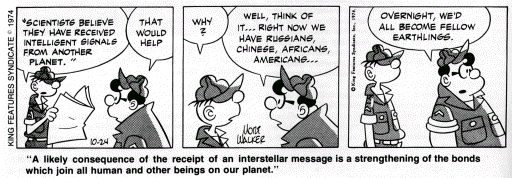![[NAAPO Logo]](../../Images/NAAPOsm.jpg)
North American AstroPhysical Observatory (NAAPO)
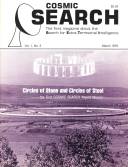
Cosmic Search: Issue 2
(Volume 1 Number 2; March 1979)
[All Articles & Miscellaneous Items]
|
Webpage Table of Contents (Bookmarks)
(Internal links to items in this webpage)
[Note. Use Back button (or <Alt>+<Left Arrow>) to get back to this Table of Contents after you have clicked on a link and viewed the article.]
Codes Used Below:
P: Starting page of article in magazine; A: Author(s); T: Title of article
|
The Quest for Extraterrestrial Intelligence
By: Carl Sagan
[Article in magazine started on page 2]
A masterful overview of SETI and its meaning to humanity — a classic — Eds.
 Through all of our history we have pondered the stars and mused whether mankind is unique or if, somewhere else out there in the dark of night sky, there are other beings who contemplate and wonder as we do — fellow thinkers in the cosmos. Such beings might view themselves and the universe differently. Somewhere else there might exist exotic biologies, technologies and societies. What a splendid perspective contact with a profoundly different civilization might provide! In a cosmic setting vast and old beyond ordinary human understanding we are a little lonely, and we ponder the ultimate significance, if any, of our tiny but exquisite blue planet, the Earth. The Search for Extra-Terrestrial Intelligence (SETI) is the search for a generally acceptable cosmic context for the human species. In the deepest sense the search for extraterrestrial intelligence is a search for ourselves.
Through all of our history we have pondered the stars and mused whether mankind is unique or if, somewhere else out there in the dark of night sky, there are other beings who contemplate and wonder as we do — fellow thinkers in the cosmos. Such beings might view themselves and the universe differently. Somewhere else there might exist exotic biologies, technologies and societies. What a splendid perspective contact with a profoundly different civilization might provide! In a cosmic setting vast and old beyond ordinary human understanding we are a little lonely, and we ponder the ultimate significance, if any, of our tiny but exquisite blue planet, the Earth. The Search for Extra-Terrestrial Intelligence (SETI) is the search for a generally acceptable cosmic context for the human species. In the deepest sense the search for extraterrestrial intelligence is a search for ourselves.
Until recently there could be no such search. No matter how deep the concern or how dedicated the effort, human beings could not scratch the surface of the problem. But in the last few years — in one millionth of the lifetime of our species on this planet — we have achieved an extraordinary technological capability which enables us to seek out unimaginably distant civilizations, even if they are no more advanced than we. That capability is called radio astronomy and involves single radio telescopes, collections
or arrays of radio telescopes, sensitive radio detectors, advanced computers for processing received data, and the imagination and skill of dedicated scientists. Radio astronomy has, in the last decade, opened a new window on the physical universe. It may also, if we are wise enough to make the effort, cast a brilliant light on the biological universe.
Some scientists working on the question of extraterrestrial intelligence, myself among them, have attempted to estimate the number of advanced technical civilizations in the Milky Way galaxy — that is, societies capable of radio astronomy. Such estimates are little better than guesses. They require assigning numerical values to quantities such as the numbers and ages of stars, which we know well; the abundance of planetary systems and the likelihood of the origin of life within them, which we know less well; and the probability of the evolution of intelligent life and the lifetime of technical civilizations, about which we know very little indeed. When we do the arithmetic, the number that my colleagues and I come up with is around a million technical civilizations in our Galaxy alone. That is a breathtakingly large number, and it is exhilarating to imagine the diversity, lifestyles and commerce of those million worlds. But there may be as many as 250 billion stars in the Milky Way Galaxy. Even with a million civilizations, less than one star in 250,000 would have a planet inhabited by an advanced civilization. Since we have little idea which stars are likely candidates, we will have to examine a huge number of them. Thus the quest for extraterrestrial intelligence may require a significant effort.
"A single message from space will show that it is possible to live through technological adolescence."
Despite claims about ancient astronauts and unidentified flying objects, there is no firm evidence of past visitations to the Earth by other civilizations, and so we are restricted to looking for signals from afar. Of the long-distance techniques available to our technology, radio is by far the best. Radio telescopes are relatively inexpensive; radio signals travel at the speed of light, faster than which nothing can travel; and the use of radio for communication is not an anthropocentric activity: radio represents a large
part of the electromagnetic spectrum, and any technical civilization anywhere in the Galaxy will have discovered radio, just as we have. Advanced civilizations might very well use some other means of communication with their peers — "zeta rays," say, which we might not discover for centuries. But if they wish to communicate with less advanced civilizations, there are only a few obvious methods, the chief of which is radio.
The first serious attempt to listen to possible radio signals from other civilizations was set up at the National Radio Astronomy Observatory in Green Bank, West Virginia, in 1959. This program, organized by Frank Drake who is now at Cornell University, was called Project Ozma [See "A Reminiscence of Project Ozma" by Frank D. Drake, January 1979, COSMIC SEARCH.]; after the princess of L. Frank Baum's Land of Oz, a place exotic, distant and difficult to reach. Drake examined two nearby stars, Epsilon Eridani and Tau Ceti, for a few weeks with negative results. Positive results would have been astonishing, because, as we have seen, even rather optimistic estimates of the number of technical civilizations in the Galaxy imply that several hundred thousand stars must be examined in order to achieve success by random stellar selection.
"It is difficult to think of another enterprise which holds as much promise for the future of humanity."
Since Project Ozma, there have been six or eight other such programs, all at a rather modest level, in the United States, Canada and the Soviet Union. Not one of them has achieved positive results. The total number of individual stars examined to date is fewer than 1,000. We have performed something like one-tenth of one percent of the required effort.
However, there are signs that much more serious efforts may be mounted in the reasonably near future. All the observing programs to date have involved either tiny amounts of time on large radio telescopes or large amounts of time on smaller telescopes. In a major scientific study for the National Aeronautics and Space Administration, directed by Philip Morrison of the Massachusetts Institute of
Technology, the feasibility and desirability of more systematic investigations have been powerfully underscored. The study has four main conclusions:
"(1) It is both timely and feasible to begin a serious search for extraterrestrial intelligence;
"(2) a significant . . . program with substantial potential secondary benefits can be undertaken with only modest resources;
"(3) large systems with great capability can be built as needed; and
"(4) such a search is intrinsically an international endeavor in which the United States can take a lead."
The study carries a reassuring foreword by the Reverend Theodore Hesburgh, President of the University of Notre Dame, that such a search is consistent with religious and spiritual values, and includes the following ringing sentiment:
"The question deserves . . . the serious and prolonged attention of many professionals from a wide range of disciplines — anthropologists, artists, lawyers, politicians, philosophers, theologians — even more than that, the concern of all thoughtful persons, whether specialists or not. We must, all of us, consider the outcome of the search. That search, we believe, is feasible; its outcome is truly important either way. Dare we begin? For us who write here, that question has step-by-step become instead: Dare we delay?"
A wide range of options is identified in the Morrison report, including new (and expensive) giant ground-based and space-borne radio telescopes. But the study also points out that major progress can be made at modest cost by the development of more sensitive radio receivers and of ingenious computerized data-processing systems.
In the Soviet Union there is a state commission devoted to organizing a search for extraterrestrial intelligence, and the large, 600-meter diameter "RATAN-600" radio telescope in the Caucasus, just completed, is to be devoted part-time to this effort. And along with spectacular advances in radio technology, there has been a dramatic increase in the scientific and public respectability of theories
about extraterrestrial life. Indeed, the Viking missions to Mars were, to a significant extent, dedicated to the search for life on another planet.
The large RATAN-600 radio telescope in the Caucasus is to be devoted part-time to SETI.


Of course, not all scientists accept the notion that other advanced civilizations exist. A few who have speculated on this subject lately are asking: if extraterrestrial intelligence is abundant, why have we not already seen its manifestations? Think of the advances by our own technical civilization in the last 10,000 years, and imagine such advances continued over millions or billions of years. If any civilizations are that much more advanced than we, why have they not produced artifacts, devices and even cases of industrial pollution of such magnitude that we would have detected them? Why have these beings not restructured the entire Galaxy for their convenience?
And why has there been no clear evidence of extraterrestrial visits to the Earth? We have already launched slow and modest interstellar spacecraft called Pioneers 10 and 11 and Voyagers l and 2 — which, incidentally, carry small golden greeting cards from the Earth to any space-faring interstellar civilizations which might intercept them. A society more advanced than we should be
able to ply the spaces between the stars conveniently, if not effortlessly. Over millions of years such societies should have established colonies which themselves might launch interstellar expeditions. Why are they not here? The temptation is to deduce that there are at most only a few advanced extraterrestrial civilizations — either because we are one of the first technical civilizations to have emerged, or because it is the fate of all such civilizations to destroy themselves before they are much further along.
It seems to me that such despair is quite premature. All such arguments depend on our correctly surmising the intentions of beings far more advanced than ourselves, and when examined closely I think these arguments reveal a range of interesting human conceits. For example, why do we expect that it will be easy to recognize the manifestations of very advanced civilizations? Is our situation not
closer to that of isolated societies in the Amazon basin, say, who lack the tools to detect the powerful international radio and television traffic which is all around them? Also, there is a wide range of incompletely understood phenomena in astronomy. Might the modulation of pulsars or the energy source of quasars have a technological origin? Or perhaps there is a galactic ethic of noninterference with backward or emerging civilizations.
Perhaps there is a waiting time before contact is considered appropriate, so as to give us a fair opportunity to destroy ourselves first, if we are so inclined. Perhaps all societies significantly more advanced than our own have achieved an effective personal immortality, and lose the motivation for interstellar gallivanting — which may, for all we know, be a typical urge only of adolescent civilizations. Perhaps mature civilizations do not wish to pollute the cosmos. There is a very long list of such "perhapses," few of which we are in a position to evaluate with any degree of assurance.
The question of extraterrestrial civilizations seems to me entirely open. Personally, I think it far more difficult to understand a universe in which we are the only technological civilization, or one of but a few, than to imagine a cosmos brimming over with intelligent life. Many aspects of the problem, fortunately, can be experimentally verified. We can search for planets of other stars; seek simple forms of life on such nearby worlds as Mars, Jupiter and Saturn's moon Titan; and perform more extensive laboratory studies on the chemistry of the origin of life. We can investigate more deeply the evolution of organisms and societies. The problem cries out for a long-term, open-minded and systematic search, with nature as the only arbiter of what is or is not likelv.
"It is possible that the future of human civilization depends on the receipt of interstellar messages."
If there are a millon technical civilizations in the Milky Way galaxy, the average separation between civilizations will be about 300 light-years. Since a light year is the distance which light travels in one year (a little under six trillion miles), this implies that the one-way transit time for an interstellar communication from the nearest civilization will be some 300 years. The time for a query and a response would be 600 years. This is the reason that interstellar dialogues are much less likely — particularly around the time of first contact — than interstellar monologues. It might seem remarkably selfless for a civilization to broadcast radio messages with no hope of knowing, at least in the immediate future, whether they have been received and what the response to them might be.
But human beings often perform very similar actions — as, for example, in burying time capsules to be recovered by future generations, or even in writing books, composing music and creating art intended for posterity. A civilization which had been aided by the receipt of such a message in its past might wish to similarly benefit other emerging technical societies. The amount of power that need be expended in interstellar radio communication should be a tiny fraction of what is available for a civilization only slightly more advanced than we, and such radio transmission services could be an activity either of an entire planetary government or of relatively small groups of hobbyists, amateur radio operators and the like.
Although probably no previous contact will have been achieved between transmitting and receiving civilizations, communication in the absence of prior contact is possible.
 It is easy to create an interstellar radio message which can be recognized as emanating unambiguously from intelligent beings. A modulated signal ("beep," "beep-beep," . . . ) comprising the numbers 1, 2, 3, 5, 7, 11, 13, 17, 19, 23, 29, 31, for example, consists exclusively of the first 12 prime numbers — that is, numbers that can be divided only by 1, or by themselves. A signal of this kind, based on a simple mathematical concept, could only have a biological origin. No prior agreement between the transmitting and receiving civilizations, and no precautions against Earth chauvinism, are required to make this clear.
It is easy to create an interstellar radio message which can be recognized as emanating unambiguously from intelligent beings. A modulated signal ("beep," "beep-beep," . . . ) comprising the numbers 1, 2, 3, 5, 7, 11, 13, 17, 19, 23, 29, 31, for example, consists exclusively of the first 12 prime numbers — that is, numbers that can be divided only by 1, or by themselves. A signal of this kind, based on a simple mathematical concept, could only have a biological origin. No prior agreement between the transmitting and receiving civilizations, and no precautions against Earth chauvinism, are required to make this clear.
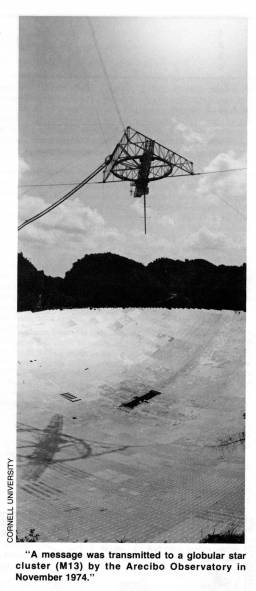 Such a message would be an announcement or beacon signal, indicating the presence of an advanced civilization but communicating very little about its nature. The beacon signal might also note a particular frequency where the main message is to be found, or might indicate that the principal message can be found at higher time resolution at the frequency of the beacon signal. The communication of
quite complex information is not very difficult, even for civilizations with extremely different biologies and social conventions. For example, arithmetical statements can be transmitted, some true and some false, and in such a way it becomes possible to transmit the ideas of true and false — concepts which might otherwise seem extremely difficult to communicate.
Such a message would be an announcement or beacon signal, indicating the presence of an advanced civilization but communicating very little about its nature. The beacon signal might also note a particular frequency where the main message is to be found, or might indicate that the principal message can be found at higher time resolution at the frequency of the beacon signal. The communication of
quite complex information is not very difficult, even for civilizations with extremely different biologies and social conventions. For example, arithmetical statements can be transmitted, some true and some false, and in such a way it becomes possible to transmit the ideas of true and false — concepts which might otherwise seem extremely difficult to communicate.
But by far the most promising method is to send pictures. The message might consist of an array of zeros and ones transmitted as long and short beeps, or tones on two adjacent frequencies, or tones at different amplitudes, or even signals with different radio polarizations. Properly arranged in rows and columns, the zeros and ones form a visual pattern — a picture similar to those an imaginative typist can create by using the letters of the alphabet as a medium. Just such a message was transmitted to space by
the Arecibo Observatory, which Cornell University runs for the National Science Foundation, in November 1974 at a ceremony marking the resurfacing of the Arecibo dish — the largest radio/radar telescope on Earth. The signal was sent to a collection of stars called M13, a globular cluster comprising about a million separate suns, because it was overhead at the time of the ceremony. Since M13 is 24,000 light years away, the message will take 24,000 years to arrive there. If anyone is listening, it will be 48,000 years
before we receive a reply. The Arecibo message was clearly not intended as a serious attempt at interstellar communication, but rather as an indication of the remarkable advances in terrestrial radio technology.
The decoded message forms a kind of pictogram that says something like this: "Here is how we count from one to ten. Here are five atoms that we think are interesting or important: hydrogen, carbon, nitrogen, oxygen and phosphorus. Here are some ways to put these atoms together that we think interesting or important — the molecules thymine, adenine, guanine and cytosine, and a chain composed of alternating sugars and phosphates. These molecular building blocks are put together to form a long molecule of DNA
comprising about four billion links in the chain. The molecule is a double helix. In some way this molecule is important for the clumsy looking creature at the center of the message. That creature is 14 radio wavelengths or 5 feet 9.5 inches tall. There are about four billion of these creatures on the third plant from our star. There are nine planets altogether, four big ones toward the outside and one little one at the extremity. This message is brought to you courtesy of a radio telescope 2,430 wavelengths or 1,004 feet in diameter. Yours truly." Especially with many similar pictorial messages, each consistent with and corroborating the others, it is very likely that almost unambiguous interstellar radio communication could be achieved even between two civilizations which have never met. Of course our immediate objective is not to send such messages, because we are very young and backward; we wish to listen.
"In the deepest sense the search for extraterrestrial intelligence is a search for ourselves."
The detection of radio signals from space would illuminate many questions which have concerned scientists and philosophers since prehistoric times. Such a signal would indicate that the origin of life is not an extraordinarily unlikely event. It would imply that given billions of years for natural selection to operate, simple forms of life generally evolve into complex and intelligent forms, as on Earth, and that such intelligent forms commonly produce an advanced technology. But it is not likely that the transmission we receive will be from a society at our own level of technological advance. A society only a little more backward than we will not have radio astronomy at all. The most likely case is that the message will be from a civilization with a far superior technology. Thus, even before we decode such a message, we will have gained an invaluable piece of knowledge: that it is possible to avoid the dangers of the period of technological adolescence we are now passing
through.
"In the last few years we have achieved an extraordinary technological capability called radio astronomy."
There are some who look on our global problems here on Earth mdash; at our vast national antagonisms, our nuclear arsenals, our growing populations, the disparity between the poor and the affluent, shortages of food and resources, and our inadvertent alterations of the natural environment of our planet mdash; and conclude that we live in a system which has suddenly become unstable, a system which is destined soon to collapse. There are others who believe that our problems are soluble, that humanity is still in its childhood, that one day soon we will grow up. The existence of a single message from space will show that it is possible to live
through technological adolescence: the civilization transmitting the message, after all, has survived. Such knowledge, it seems to me, might be worth a great price.
Another likely consequence of the receipt of an interstellar message is a strengthening of the bonds which join all human and other beings on our planet. The sure lesson of evolution is that organisms elsewhere must have had separate evolutionary pathways; that their chemistry and biology, and very likely their social organizations, will be profoundly dissimilar to anything which is familiar here on Earth. We may well be able to communicate with them because we share a common universe; because the laws of physics and chemistry and the regularities of astronomy are shared by them and by us. But they may always be, in the deepest sense, different. And when we recognize these differences, the animosities which divide the peoples of the Earth may wither. The differences among human beings of separate races and nationalities, religions and sexes are likely to be insignificant compared to the differences between all humans and all extraterrestrial intelligent beings.
If the message comes by radio, both transmitting and receiving civilizations will have in common at least the details of radiophysics. The commonality of the physical sciences is the reason that many scientists expect the messages from extraterrestrial civilizationsto be decodable. No one is wise enough to predict in detail what the consequences of such a decoding will be, because no one is wise
enough to understand beforehand what the nature of the message will be. Since the transmission is likely to be from a civilization far in advance of our own, stunning insights are possible in the physical, biological and social sciences, insights reached from the perspective of a quite different kind of intelligence.
Decoding such a message will probably be a task of years and decades, and the decoding process can be as slow and careful as we choose. Some have worried that such a message from an advanced society might make us lose faith in our own, might deprive us of the initiative to make new discoveries if it seems that there are others who have made those discoveries already, or might have other negative consequences. But I stress that we are free to ignore an interstellar message if we find it offensive. Few of us have rejected schools because teachers and textbooks exhibit learning of which we were so far ignorant. If we receive a message, we are under no obligation to reply. If we do not choose to respond, there is no way for the transmitting civilization to determine that its message was received and understood on the tiny distant planet Earth. The receipt and translation of a radio message from the depths of space seems to pose few dangers to mankind; instead, it holds the greatest promise of both practical and philosophical benefits for all of humanity.
Green Bank 43-meter radio telescope
Veteran operator Ken Cottrell at the control console of the Green Bank 91-meter radio telescope
It is possible that an early message may contain detailed prescriptions for the avoidance of technological disaster, for a passage through adolescence to maturity. Perhaps the transmissions from advanced civilizations will describe which pathways of cultural evolution are likely to lead to the stability and longevity of an intelligent species, and which other paths lead to stagnation or degeneration or disaster. Perhaps there are straight-forward solutions, still undiscovered on Earth to problems of food shortages, population growth, energy supplies, dwindling resources, pollution and war. There is, of course, no guarantee that such would be the contents of an interstellar message; but it would be foolhardy to overlook the possibility.
"Humanity is still in its childhood . . . one day soon we will grow up."
There will surely be differences among civilizations which cannot be glimpsed until information is available about the evolution of many civilizations. Because of our isolation from the rest of the cosmos, we have information on the evolution of only one civilization mdash; our own. And the most important aspect of that information, the future, remains closed to us. Perhaps it is not likely, but it is certainly possible that the future of human civilization depends on the receipt and decoding of interstellar messages.
And what if we make a long-term and dedicated search for extraterrestrial intelligence and fail? Even then we surely will not have wasted our time. We will have developed an important technology, with applications to many other aspects of our own civilization. We will have greatly added to our knowledge of the physical universe. And we will have calibrated the importance and uniqueness of our
species, our civilization and other planets. For if intelligent life is rare or absent elsewhere, we will have learned something about the rarity and value of our culture and our biological patrimony, which have been painstakingly extracted over four billion years of tortuous evolutionary history.
Such a finding will stress as perhaps nothing else can our responsibilities to future generations: because the most likely explanation of negative results, after a comprehensive and resourceful search, is that societies destroy themselves before they are advanced enough to establish a high-power radio transmitting service. Thus, organization of a search for interstellar radio messages, quite apart from the outcome, is likely to have a cohesive and constructive influence on the whole of the human condition.
But we will not know the outcome of such a search, much less the contents of messages from interstellar civilizations, if we do not make a serious effort to listen for signals. It may be that civilizations are divided into two great classes, those which make such an effort, achieve contact nd become new members of a loosely tied federation of galactic communities, and those which cannot or choose not to make such an effort, or who lack the imagination to try, and who in consequence soon decay and vanish.
It is difficult to think of another enterprise within our capability and at relatively modest cost which holds as much promise for the future of humanity.
In the last few years we have achieved an extraordinary technological capability called radio astronomy.
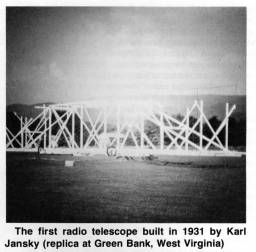
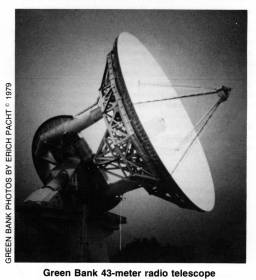

The text of this article is reproduced by permission from SMITHSONIAN magazine May 1978. Copyright 1978 Smithsonian Institution.
 Carl Sagan is the David Duncan Professor of Astronomy and Space Sciences and Director of the Laboratory for Planetary Studies at Cornell University. Before coming to Cornell in 1968, he served on the faculties of Harvard University and of the Stanford University Medical School. Born in New York City in 1934, he received his doctor's degree from the University of Chicago in 1960. His interests encompass the physics and chemistry of planetary atmospheres and surfaces, planetary exploration, origin of life on the earth, and the possibilities and means of detection of extraterrestrial life. He has been closely associated with the NASA planetary explorations involving the Mariner, Viking and Voyager missions.
Carl Sagan is the David Duncan Professor of Astronomy and Space Sciences and Director of the Laboratory for Planetary Studies at Cornell University. Before coming to Cornell in 1968, he served on the faculties of Harvard University and of the Stanford University Medical School. Born in New York City in 1934, he received his doctor's degree from the University of Chicago in 1960. His interests encompass the physics and chemistry of planetary atmospheres and surfaces, planetary exploration, origin of life on the earth, and the possibilities and means of detection of extraterrestrial life. He has been closely associated with the NASA planetary explorations involving the Mariner, Viking and Voyager missions.
Besides hundreds of scientific and popular articles, he has published a dozen books including "The Cosmic Connection: An Extraterrestrial Perspective" (Anchor Press, 1973), winner of the Campbell Award for the best science book of the year, and "The Dragons of Eden: Speculations on the Evolution of Human Intelligence" (Random House, 1977), winner of the 1978 Pulitzer Prize for non-fiction.
As one of science's most eloquent expositors, Sagan has contributed greatly to a better public appreciation of astronomy. In 1977, to improve the presentation of science on television and in motion pictures, he formed "Carl Sagan Productions: Science for the Media, Inc." An initial project is a 13-week series on astronomy.
Sagan edited the proceedings of the first international meeting on communication with extraterrestrial intelligence held in Armenia in 1971. He is also Editor-in-Chief of "ICARUS: International Journal of Solar System Studies" and a member of the Editorial Board of COSMIC SEARCH.
|
|
Letters; SETI Courses
By: Editors
[Article in magazine started on page 9]
Letters
I cannot say how pleased I am to see a regular publication devoted to the SETI problem. Since my own interest began with Walter Sullivan's book in the early '60s, it is fitting that he should have an article in your premier issue. Please enter my two year subscription. The $15 is joyously enclosed.
Gregory J. Wheeler
Los Angeles, California

Please enter my subscription to COSMIC SEARCH for a two year period. As a student of Frank Drake I naturally am aroused by your novel
magazine. In particular, your ad mentions awards for papers on SETI by students. Well, in March I completed an indirect SETI, looking for water beacons (at 1.4 centimeters) in globular clusters. The search was "indirect" in the sense that the prime motivation was astronomical. However, this constitutes the first major SETI from a large number of stars at the water line. Between Frank's latest paper on the "new" waterhole and Paul Feldman's preprint along the same lines I'm sure that it is obvious that this project has salience. The project has the name BEEHIVE and was done at the Haystack Observatory.
Chip Cohen
Cornell University
P.S. I am a second year astronomy grad student.
Dear Chip:
Why don't you submit a popular level paper on PROJECT BEEHIVE for a possible SEARCH AWARD?
COSMIC SEARCH
Note: For more about the "new" waterhole that Chip mentions, see "The Second Waterhole" in this issue's ABCs of SETI.
I was delighted to see your ad. I presently am offering a course on SETI with anew course starting in January. Is it possible to purchase copies of COSMIC SEARCH for my Class?
Donald J. Albers
Chairman, Dept. of Mathematics
Menlo College
Menlo Park, California
Dear Professor Albers:
Yes, of course, and you will be happy to know that we have a special rate.
COSMIC SEARCH
Congratulations and a long life to your new publication. Please enter my two year prepaid subscription.
Jack Craig, USAF
Oregon City, Oregon

Robert Sheaffer
Silver Spring, Maryland

Gail G. Even, Editor
THE CONNECTICUT WHALE SPOUTS
Wethersfield, Connecticut

SETI Courses
An increasing number of college-level courses are being given on SETI. We would like to list those institutions offering such courses in COSMIC SEARCH. If you give a SETI course please write to Prof. John Kraus, Editor of COSMIC SEARCH, O.S.U. Radio Observatory, 2015 Neil Ave., Columbus, Ohio 43210. Years given, attendance, a syllabus (if available) and other information will be appreciated.
Some Humor
Overheard one night at a California airport:
"Say, Mac, could you tell me if that's Cygnus or Orion up there?"
"Sorry, pal, I wouldn't know. I'm not from this part of the country."
|
Circles of Stone and Circles of Steel
By: Don Lago
[Article in magazine started on page 10]
A charming, poetical allegory relating Stonehenge and SETI to the human longing for an understanding of the cosmos. This article has the distinction of winning the first COSMIC SEARCH AWARD; it is also Don Lago's first published article — Eds.
 Every morning for millions of years sunrise over the chalk plains of Britain illuminated the same landscape. The light washed over gently rolling hills and scattered banks of trees, igniting the eyes of birds and small mammals whose species had been greeting the sun here for millions of mornings. Yet one morning the sun found a stranger standing on the plain, an animal who soon showed that he was different from the animals around him. While other animals used the sunlight to begin foraging for food to satisfy their hunger, this creature only stood and watched the sun, as if the light itself was food that fed a different kind of need, a hunger not of the stomach but of the mind. When the sun disappeared he watched the moon and the other lights in the sky. He watched in every season, through harvests and plagues, for years and decades, and though individuals might age and close their eyes forever, new generations would always lift their faces to the sky.
Every morning for millions of years sunrise over the chalk plains of Britain illuminated the same landscape. The light washed over gently rolling hills and scattered banks of trees, igniting the eyes of birds and small mammals whose species had been greeting the sun here for millions of mornings. Yet one morning the sun found a stranger standing on the plain, an animal who soon showed that he was different from the animals around him. While other animals used the sunlight to begin foraging for food to satisfy their hunger, this creature only stood and watched the sun, as if the light itself was food that fed a different kind of need, a hunger not of the stomach but of the mind. When the sun disappeared he watched the moon and the other lights in the sky. He watched in every season, through harvests and plagues, for years and decades, and though individuals might age and close their eyes forever, new generations would always lift their faces to the sky.
 After many generations something strange began happening on the chalk plains. Hundreds of men began bringing massive stones from far away and raising them in a circle. They needed years to break the monoliths out of the earth and drag and heave them inch by inch over miles of hills, but the task could not outlast their determination. With only logs and rope for tools they had to rely on muscles
and sweat to raise the stones, but their aspirations out-
weighed tons of rock.
After many generations something strange began happening on the chalk plains. Hundreds of men began bringing massive stones from far away and raising them in a circle. They needed years to break the monoliths out of the earth and drag and heave them inch by inch over miles of hills, but the task could not outlast their determination. With only logs and rope for tools they had to rely on muscles
and sweat to raise the stones, but their aspirations out-
weighed tons of rock.
Many animals must have noticed the peculiar structure rising nearby, but it could only puzzle them. They might have understood what all this effort was about if the humans had been making a dwelling for themselves, for that was a need shared by every animal, but man was building something that only he could need or understand. Only yesterday on the evolutionary timescale man had been content to roam with his fellow animals in search of food and comfort, but something had happened to him. He had felt something no animal had ever felt, something that made him raise tons of stone into the sky. His organs and muscles and bones had been evolved by millions of animals searching for food and shelter, but now his animal body was serving distinctly human longings.
What set man apart was his discovery of the universe. He had been looking at the earth and the stars for millions of years, but evolution slowly allowed him to see them differently. The familiar terrain where he had always lived began to feel strangely alien. The stars he had noticed without concern came to haunt him with their strangeness. The creature who had been satisfied with food and companionship began to ask what the universe was all about, and he found he could not answer. He looked at the world and saw a bottomless mystery, and his whole life became an enigma.
The void opening in the human mind left man with a loneliness beyond any he had ever known, a cosmic loneliness. There was no one to answer his questions, and perhaps there weren't even any answers. He couldn't ask the animals around him, for where he saw the mystery of the universe, they were busy watching for enemies and sniffing the ground for signs of something to eat. Man was alone with his own thoughts, with questions to answer as well as he could.
Man saw this mystery most awesomely in the sky, and everywhere around Earth human faces turned to follow the lights flying above them. For a long time the sky must have seemed a blur of lights and motion, yet as generation after generation watched, they gradually discerned patterns in the whirling confusion. Though humans might not be able to grasp the meaning of the universe and their lives in it, they could at least begin to unravel the swarm of events around them and know something of how the universe worked. Of first importance was the sun. Though the life of Earth was rooted in the soil, man realized that it flourished or withered depending on the energy raining from the sky. If humans feared that the seasons came and went by whim they must have been greatly reassured to discover that the sun followed a reliable course. Winter would not go on forever: the days would start to lengthen again, and man could know when. He could also know when the smaller lights in the sky would come and go, and even when the moon would pass before the sun and blacken Earth with its shadow. Something profound had happened on Earth: the brains that began as feeble sparks in the primordial seas had come to know of cosmic events before they occurred.
"Though man and creatures elsewhere were born in isolation, all are children of the same universe."
Though knowing their courses, man still didn't know the nature of the lights in the sky. He often conceived of them as powerful personalities responsible for creating and ruling the world. Different groups called these beings by different names, imagined different faces and motivations for them, yet all around the world humans were tracking the same lights and plotting the same paths across the sky.
Humans not only studied the sky, they put a great deal of effort into embodying their discoveries in structures that would be sure to outlast them. Some raised circles of stone whose alignments allowed them to recognize soltices [sic; solstices] or imminent eclipses. Others dug tombs and built temples whose innermost sanctuaries were briefly illuminated on the shortest or longest day of the year. Many raised single archways through which to spot important events, or single stones to mark a steady point from which to watch the sun shift against the features of a mountain range.
Yet stone outlasts civilizations almost as easily as it does individuals. The societies who reflected the sky in mirrors of stone vanished one by one. The Maya suddenly abandoned their great calendars to the jungle. Egyptian culture was strong enough to last thousands of years, but its temples would stand long after the prayers fell silent and the gods were forgotten. Babylon fell into ruin and the tablets containing hundreds ofyears of astronomical patterns were broken and lost. And even when no one was left who knew
how to read it, Stonehenge faithfully carried on the watch of its creators.
Later generations would puzzle over the ruined monoliths of Stonehenge, but if the purpose of the stones was forgotten, the feelings that moved humans to erect them were not.
"Sunlight is reflected in the dew of delicate spiderwebs . . .
and in the massive webs of metal hanging in the sky."
(World's largest fully-steerable radio telescope 100 meters in diameter at Bonn, Germany.)


As morning moves across the face of the planet sunlight is reflected in the dew of millions of delicate spiderwebs, and also in hundreds of massive webs of metal hanging in the air, spun not for capturing insects, but a far more intangible kind of nourishment. The webs rise among mountains and beside the sea, from plains and valleys, deserts and tropical islands, amid forests and arctic wilderness, and each points to the sky.
These circles of metal are the work of the same hands that raised Stonehenge, but they are reaching so much farther. Stones could only trace patterns on the surface of the sky, but these webs of woven metal probe the farthest galaxies. The men of Stonehenge were limited by what their own eyes could see, while the people of the radio telescope see the universe through senses humans do not
possess.
Evolution endowed animals with all the senses they needed to live, but man's needs had outgrown anything evolution could imagine or devise. The human body was designed for a habitat of trees and grasslands, but the habitat of the human mind had suddenly grown to include the entire universe. Evolution devised human senses for the life of a primate, yet now man wanted to perceive more than evolution had deemed sufficient. The human brain was no larger than many others on the planet, but the instruments man built to feed the hunger of that brain would dwarf the greatest whales. All around the Earth his great machines absorbed the energies born in the hearts of distant stars, and his mind worked to understand what was happening there.
The universe perceived from the radio telescope is very different from that seen over Stonehenge. The universe had expanded beyond human imagination, and the stars and galaxies had expanded with it. The common swirl of lights around Earth had been dissolved into billions of centers of motion. The universe was filled with bizarre objects pulsing with incredible energies. And instead of watching for gods, man now searched for creatures like himself.
As man's image of the universe changed he realized that he must be only one of many creatures looking out upon the stars. Earth was not the only womb of life in the universe; the same creative forces that gave birth to man were at work in every galaxy. Man now stared into the sky and wondered what strange faces were staring back at him, and what thoughts flickered behind those faces. He could only guess what minds were awakening elsewhere when Earth was still unformed, or what civilizations had arisen among the stars. But now he knew that he was not the first to look into the universe and feel its strangeness. The men who built Stonehenge had unknowingly performed an ancient rite, for all across the universe hands were raising circles of stone and circles of steel into the sky.
"These circles of steel are the work of the same hands that raised Stonehenge but they are reaching so much farther . . . to the farthest galaxies."
Thousands of years of studying the sky have brought man to search for other minds among the stars. The radio telescopes carry on the work of the men who raised stones to mark the sky, but they wait for something the priests of Babylon and Stonehenge could not imagine: not a solstice, but a call from across the light-years, announcing to anyone who might be listening the presence of a mind. Man listens to the heartbeats of the stars, hoping to detect a pulse of consciousness among the roaring energies of the universe.
Though much in man's vision of the universe has changed, one thing has not. Whether humans saw the cosmos from a Stonehenge or a Green Bank, they felt equally amazed to find themselves alive in such a universe. Whether they looked for signs of gods or consciousness, they acted out of the same hunger to know the cosmos in which they had awakened. Man might never be able to understand the mystery of the universe, but he could not rest until he had experienced that mystery as fully as he could.
"Sunlight is reflected in the dew of delicate spiderwebs . . . "
" . . . and in the massive webs of metal hanging in the sky." (World's largest fully-steerable radio telescope 100 meters in diameter
at Bonn, Germany.)
"Man listens for a call from across the light-years, announcing the presence of a mind."
Yet now man might no longer have to face that mystery alone. If no creature of his own planet could share his feelings, there were yet billions of planets scattered among the galaxies. Each was a womb which might conceive a mind sensitive enough to feel the enigma of his own life and the universe that gave him birth. The universe creates these races far apart and leaves them on their own to try to
find one another. When man manages to find creatures like himself somewhere in the enormities of space, his cosmic loneliness will come to an end, for he will join a fellowship of minds who have shared the same experience. Though born in isolation, all are children of the same universe. Though each might be unique, they are joined by the profoundest bond, that of sharing the same enigmatic existence.

 Don Lago, 22, resides in Missouri. He has attended college briefly. Beyond that, in his own words, "My occupation is finding out what people who have lived before me have discovered and thought about the world, and occasionally I have an interesting thought of my own. This is a full-time job in itself and doesn't leave much time to waste on such things as making money, which I am doing at a bookstore.
Don Lago, 22, resides in Missouri. He has attended college briefly. Beyond that, in his own words, "My occupation is finding out what people who have lived before me have discovered and thought about the world, and occasionally I have an interesting thought of my own. This is a full-time job in itself and doesn't leave much time to waste on such things as making money, which I am doing at a bookstore.
"I was born on the planet Earth (let's not be provincial), and plan to spend most of my life there. I find it very exciting to be alive when man is first searching for other minds in the universe, and hope to live long enough to learn what they have thought about the cosmos."
|
Editorial "Let's Get SETI Through Congress"
By: Bernard M. Oliver
[Article in magazine started on page 15]
The NASA FY '79 Budget included $2 million for the first year of a 5 year SETI program with a total budget of $20 million. This program had the approval of the President's Science Advisor, of the OMB, and of the House and Senate authorization committees. Yet the House and Senate appropriations committees eliminated it entirely.
In times when reductions in government spending are being sought, the temptation to turn down any new program, regardless of its merits, is very strong. But such a procedure is short-sighted and ultimately dangerous. The way to prune a tree is to saw off old dead
branches and balance the remaining ones to please the eye, not to nip off every new young bud. The way to make real budget reductions is to cut out large and old programs that have proven to be ineffective or that have outlived their usefulness, and to balance the
remaining programs, not to practice infanticide. If we don't weed out the old and useless to make way for the new, we'll never get anywhere.
Because of bureaucratic entrenchment it is very difficult to discontinue existing programs. It takes real courage to stand up in Congress and say that a program is ineffective, that the jobs it provides are unproductive. But don't we have a right to expect
courage in our representatives?
SETI has enormous popular appeal. Its inclusion as a NASA program would be hailed by the voting taxpaying public who, in general, care little about the scientific discoveries space has produced, but who are enormously interested in the prospect of other intelligent life. Unscientific motion pictures and fraudulent books about extraterrestrial life enjoy unprecedented popularity today. Surely a soundly based, scientific program would be accepted. In fact, most laymen assume that a SETI program is already going on. Isn't it time NASA lived up to this popular belief?
SETI has withstood two decades of scientific scrutiny. Each passing year finds scientists more convinced of the abundance of life in the universe, and engineers more pessimistic about the possibility of economically feasible interstellar travel. The only practical way to discover this other intelligent life is to search for radio (or other) signals it radiates. Existing radio telescopes could detect their counterparts anywhere in the Galaxy, but this will never happen unless we search in a systematic way. It is important
that we begin now while there are empty bands in the microwave spectrum where we can listen without man-made interference. If we do not pre-empt some of these windows for SETI we will forever blind ourselves to the mainstream of life and end up as Galactic
recluses.
The real problem may be that our Senators and Congressmen need a little SETI fan mail. People tend to write their representatives to condemn rather than to support, and SETI no doubt has elicited letters of condemnation and derision. Would you help tip the scales the other way? Tell your Congressmen and Senators that you'd be happy if one dollar of your taxes annually went to SETI. Think what a magnificent search program $50 million per year would support!
Bernard M. Oliver
Member, Editorial Board of COSMIC SEARCH
|
FORUM:
Gerard K. O'Neill on "Space Colonization and SETI"
[Article in magazine started on page 16]
High energy physicist, teacher, astro-engineer and space colonizer, like a Columbus or a Magellan, O'Neill charts a course into a cosmic future.
[This interview with Gerard K. O'Neill was made by John Kraus of COSMIC SEARCH.]
 COSMIC SEARCH: To what extent do you think civilizations elsewhere in our galaxy or beyond may have colonized space?
COSMIC SEARCH: To what extent do you think civilizations elsewhere in our galaxy or beyond may have colonized space?
O'NEILL: There is a fair amount of evidence that we may be alone in this galaxy as a material-oriented civilization. I emphasize the material oriented. There is a possibility, I think, that others may have gone before us, but only if there is some kind of undiscovered universal rule of life stating that material orientation rather than spiritual or non-material orientation of a civilization is a very brief episode in its evolution, and that every civilization goes through that period very quickly.
COSMIC SEARCH: Would you please enlarge a little on what you mean by a materially-oriented civilization?
O'NEILL: I mean one which produces artifacts, makes use of energy, communicates by means of the electromagnetic spectrum—in other words, an energy-and-material oriented civilization like our own.
COSMIC SEARCH: So, then, we are such a civilization.
O'NEILL: Yes, very much so.
COSMIC SEARCH: Now you alluded to a spiritually-oriented one. What did you have in mind?
O'NEILL: Suppose it is possible for beings to develop which are not tied to matter at all, communicating by some portion of the electromagnetic spectrum that we are not sensitive enough to notice. Suppose also that they have no interest whatever in the physical
universe. In order for us not to be alone, I almost have to conclude that there is a universal rule of life that every civilization evolves very quickly to this end state of non-material orientation.
COSMIC SEARCH: Do you believe that colonization of space is a normal step in the evolution of any society?
O'NEILL: With the proviso that we don't talk about the totally nonmaterial path, yes, I think it is an inevitable step. I think it is unlikely that a civilization will last very long on a galactic time scale without developing space colonies, because the fragility of a civilization confined to the biosphere of one planetary surface is very great when that civilization possesses nuclear weapons in large quantities. You can imagine holding things together for a few decades, but the only end points that seem reasonable are either the statistical possibility (or a statistical certainty if you wait long enough) of a massive nuclear war that sets a
civilization way, way back, or else a steady state society under a rigid dictatorship which confiscates all military weapons and keeps things constant for evermore. These are certainly possible outcomes and would not result in the establishment of space colonies.
COSMIC SEARCH: This would be a condition of stagnation?
O'NEILL: That's right. I see three possibilities for a civilization that gets to about our stage. One is stagnation, one is annihilation, and the third is expansion out into space through space colonies.
COSMIC SEARCH: That is an interesting trilogy.
O'NEILL: Logically it is hard for me to see any other possibilities. At the moment we see the first step of that transition just before us, that critical step of escaping the planetary biosphere and going out beyond the earth to establish colonies there. But it is important to realize that once that quantum jump has been made, all of the transitions after it become very much easier. It seems almost inevitable, considering the physics, that in a time scale which is very short in galactic terms a civilization that developed space colonies would spread throughout a galaxy.
COSMIC SEARCH: If we were to receive a signal from another civilization, say a 1000 light years distant from us, do you think that would be a good thing?
O'NEILL: It depends on the kind of signal. I tend not to place a high probability on receiving a signal. If we do get one and it is only a beacon, some thing that just gives the information "We're here or at least at one time, we were here," I think that kind of signal would be a great help in drawing us outward from the earth. In contrast a detailed exposition, for example, of all the scientific knowledge that we have yet to find on our own could have a very stultifying effect. Advanced western civilization has had a destructive effect on all primitive civilizations it has come in contact with, even in those cases where every attempt was made to preserve and guard the primitive civilization. In part, the reason for the destruction is that all of the knowledge base and the value system that had been built up by what you might call the client civilization became valueless overnight. I don't see any reason at all why the same thing would not happen to us if we were to be put into that situation. For example, speaking as a scientist, suppose I have the choice between laboring to try to do an important experiment and learn another fundamental fact of nature or simply turning on my television set and waiting until the broadcast comes through that will give me the answer. The enormous difference in one's view of one's own value is why I feel that something that has almost no information in it beyond the fact that it is there and that it is artificial could be very valuable. Anything that's much more detailed would almost certainly be harmful.
"I see three possibilities for a civilization that gets to about our stage: stagnation, annihilation and expansion out into space through space colonies."
COSMIC SEARCH: It is possible that another culture could have evolved under such radically different circumstances that there would be very little in common and for a long time all that we would learn from it is that it exists or did exist and much detailed information might be difficult to obtain.
O'NEILL: With the exception, of course, of scientific information because information from the hard sciences is universal.
COSMIC SEARCH: Yes, that is they will be familiar with numbers, with the galaxy and the universe and this gives a base for communication.
O'NEILL: I would go farther than that. We know already from astronomical and other measurements the value of the charge on the electron, the size of Planck's constant, and things of that sort which are universal constants of nature; we know that subjects like physics, mathematics, chemistry are all universal scientific subjects, which means that a civilization that is even as tiny an amount as 1000 years ahead of us already knows so much more than we do that all the science we know would seem very primitive.
COSMIC SEARCH: This is a possibility.
O'NEILL: I would be more categorical and say it's a certainty. Newton's laws, Maxwell's equations and the rest are identically the same from one end of the universe to the other, no matter who discovers them. Logically, I don't see any escape from it. In the soft sciences, though, the alien equivalents of anthropology, psychology and so on would presumably be quite different from ours.
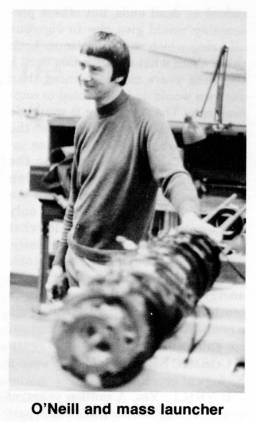 COSMIC SEARCH: What do you consider might be the most likely way that we might learn of the existence of another civilization?
COSMIC SEARCH: What do you consider might be the most likely way that we might learn of the existence of another civilization?
O'NEILL: I've thought about that quite a bit. Let me answer the question by outlining what seems to be the most logical way that a civilization would move throughout a galaxy or would communicate with another civilization. Let us put ourselves not in the shoes of the receiver but of the transmitter. First of all we must get a feeling for time scale. We are at a particular very, very unusual moment in our own history. We have just barely, within the past few decades, (just a microsecond on the cosmic time scale) arrived at the point where we are able to use radio communication. Within at most another few decades, another microsecond, we'll be able to spread throughout the entire galaxy. We happen to be poised just on that knife edge between the two. That gives us a
strange and, I think, a very distorted view of what's practical and possible. But if there are beings who are going to communicate they are presumably very far advanced over our present status, even if the very far only means a thousand years or two. It is much
more likely that they would be hundreds of thousands of years more advanced. Now, of course, one of the most important characteristics of the spread into the galaxy, of which the space colonies are the first step, is the escape from the stultifying decay and stagnation which is one of the likely end points that determines the lifetime of a communicating civilization. The civilization would then undergo cultural evolution in many different directions, some of which would indeed be dead ends, but others presumably would give rise to vigorous offspring which would continue. Let's think about what a civilization even a thousand years more advanced than
our own would do if it wanted to communicate. The first thing it would do as it began to spread throughout the galaxy is to say, "We'll get some information." If you assume that the spreading time of a civilization throughout the galaxy is a tenth the speed of light, you presuppose only that we are able to do technically what we can now understand scientifically, namely to store matter and antimatter and allow them to react to give energy. If we can do that, we will get a tenth of the speed of light. At that rate
a civilization could spread throughout the galaxy in less than a million years.
COSMIC SEARCH: Hardly even a geological epoch.
O'NEILL: Yes. A million years, of course, is only one ten thousandth part of the age of the galaxy so even that is an instant. The first thing a civilization in the first 1000 years out of that million would be likely to do is to try to get all of the information about the galaxy that it could, and to do so in a way that would be totally safe. One of the obvious avenues available to such a civilization is a very cheap one, namely building one highly sophisticated robot probe which is capable of self-replication, contains a great store of knowledge, and has transmitting capability.
COSMIC SEARCH: Is this like a Bracewell probe?
O'NEILL: I don't recall seeing Ron Bracewell's studies. The concept may be very similar. As I describe it you may be able to tell me that it is identical. My concept of such a probe is that it would go to another star system, neighboring the original one. It would use the asteroidal material available there, since there's presumably debris around every star, and use the energy which is certainly there. In a period of a few years, or maybe it would be a hundred years, it would replicate itself. It would then leave one of itself at that star and move off to the next star and so on. As it went, it would establish two-way communication, point-to-point, not a broadcast at all, but from one of these replicator probes to the next. You can work out the numbers, John, and it turns out that by any reasonable standards such a probe system could spread throughout the galaxy and cover essentially every star in the galaxy within a time of no more than half a million years or substantially less than the time required for a civilization to spread out. The
obvious thing for such a probe system is never to get involved in sending high powered signals because it's an ideal example of a telephone or television network with a series of amplifiers, one at each star.
COSMIC SEARCH: These would be relay stations.
O'NEILL: Yes, and also very effective observation stationsmdash;observation stations not dependent on beacons or other voluntary action on the part of the civilizations being observed. If you want to find out about who's alive out there, it's stupid to wait until the other guy develops radio communication. It makes much more sense simply to build a system of these replicator probes which can do highly sophisticated monitoring of every individual planet of every star system and give you probably many millions of years warning before a civilization is even going to develop.
"Newton's laws and Maxwell's equations are identically the same from one end of the universe to the other, no matter who discovers them."
COSMIC SEARCH: The replicator probe concept appears to me to be an extension of the basic Bracewell probe idea. It's like a very advanced reconnaissance system.
O'NEILL: You can call it very advanced, but on the other hand it is probably something that we would be capable of building ourselves within far less than a thousand years, maybe as little as a hundred. Therefore, the most logical development is that a
very short time after the first civilization in a galaxy arrives at a level comparable to our own, say within a thousand years from then, there would be the beginnings of the spreading out of a robot probe system to every star and that within about half a million to a million years or so that process would be complete. That then raises an interesting question. If there is anybody who has come out in the galaxy before us, their probe is overwhelmingly likely already in place. In which case they could have communicated with us at any time in the last few million years. Even without radio they could flash light bulbs at us if they wanted to and the fact that
they have not leaves us with the following possibilities: namely, that we are alone in the galaxy, meaning to say that we are the first civilization that has developed, or that probes are set to trigger only on a civilization that solves its self-destruction problems on its own. For example, the probes could be so equipped that they don't respond to any signal they detect until a thousand years of continued radio broadcasts after the last detected atomic bomb blast. There are all sorts of codes. The last possibility is that if there was a previous civilization in the galaxy, it seeded the galaxy with probes that were destructive of life. But I think this is unlikely because if it were true we would very likely have been wiped out ourselves long before we started radiating television signals.
COSMIC SEARCH: What would have been the motivation for this latter action to wipe out life?
O'NEILL: Some of the same ones that we have seen pretty recently in our own civilization. The first and the strongest who comes out of the litter proceeds to kill the rest so as to get all of what is left for himself.
COSMIC SEARCH: Get all the spoils.
O'NEILL: I think, though, there is good evidence that that has not happened. If, in fact, there is a civilization which develops in the galaxy and which is hostile to other life, it would be foolish for it to wait until the other life gets to the level where they start having star wars. It makes far more sense for them to destroy that other life at a very primitive level when it is
totally incapable of defending itself.
Space city (NASA)
 COSMIC SEARCH: You have talked about these probes going out preparatory to the colonization of the galaxy. This could not be a coordinated effort because when the colonizing groups become separated, by say 100 light years, they would become independent.
COSMIC SEARCH: You have talked about these probes going out preparatory to the colonization of the galaxy. This could not be a coordinated effort because when the colonizing groups become separated, by say 100 light years, they would become independent.
O'NEILL: If you're speaking now of the human movement, it is quite true that by the time they had spread out even to as little as two or three stellar distances they would be, for all practical purposes, independent. However, there would be no need to have more
than one probe system, the initial system, because the information that it would send would simply be relayed across the galaxy from the point of origin of the information and there would be no way of telling, even if you tapped into the transmission, where in the galaxy the original civilization was. This safety element would presumably be designed into it.
COSMIC SEARCH: What do you think would happen to your plans for space colonization in case evidence was obtained of another civilization? What effect would it have?
O'NEILL: It might have some positive effect, but I would guess that the main drives to move out into space are really independent of the existence of other civilizations. I have described why I think it is pretty unlikely we would be hearing anything, and, as you probably know, there are a number of other people, Josef Shklovsky is one, and Sebastian von Hoerner is another, who in the past year have been thinking along lines very similar to those I have described to you. In fact, I had a very interesting
discussion with Shklovsky about this in Prague last year, and it turned out that independently we had come to much the same conclusions. I got a letter from Sebastian von Hoerner expressing much the same thing. But leaving that aside as a civilization moves out into the galaxy, by the time individual colonies are as little as 10 or 20 or 30 light years apart they are effectively not in communication except in the most general way. And similarly I think that the reasons we would move into space would not be much affected by the existence of another civilization.
Steps in O'Neill's plan for exploring the galaxy
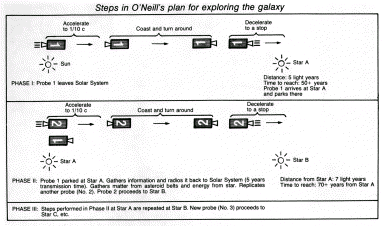 COSMIC SEARCH: Do you think that the space colonization activities will significantly increase the probability of another civilization detecting us through all our radio transmissions?
COSMIC SEARCH: Do you think that the space colonization activities will significantly increase the probability of another civilization detecting us through all our radio transmissions?
O'NEILL: I wouldn't guess so because in many respects communication between space colonies could be a lot more efficient and done at much lower power and radiate less stray energy than our present difficult communications which are after all around the outside of a sphere which is opaque to radio. Most of the radiated power that we are putting out, the kind that would go really long distances, is from the big military radars. There the issue is not whether space colonies exist but whether militarism continues and whether it escalates.
COSMIC SEARCH: But the radars may be quite directional so that the probability may be small that somebody would chance upon it.
O'NEILL: I wouldn't bet on it. After all, the military radars by definition try to obtain total coverage over a wide angular range because they are searching for incoming aircraft or missiles. So they do cover a wide range and only a few pulses need to be received to identify something as being artificial.
COSMIC SEARCH: Then you believe that the radars are more likely to give us away than the television stations?
O'NEILL: I think so, although there is the issue of the relative amount of noise in the galaxy at various frequencies so that I shouldn't comment from a technical viewpoint. It may be, for example, that when you look at the noise spectrum in detail there is some unsuspected part of the spectrum that would turn out to be the biggest give-away.
COSMIC SEARCH: Do you think we should institute a radio blackout to keep our existence as quiet as possible?
O'NEILL: It's probably a bit late for that.
COSMIC SEARCH: You think the cat's out of the bag?
O'NEILL: I think so, but also, as I mentioned before, I believe that if there is anybody out there who is hostile to us we wouldn't have been allowed to get as far along as we are now. I don't think radio communication is the critical development point at all. If there were another civilization that preceded us in the galaxy, whether hostile or non-hostile, they would be detecting our presence not by radio, but by having their own sophisticated probe in orbit around the sun. They would have seen every stage in our
development from the most primitive.
COSMIC SEARCH: Do you think there is enough in common between SETI and space colonization for either of these activities to be helpful to the other? Are they complementary?
O'NEILL: I think they are fairly independent. I would guess there are a fair number of people whose primary interest is in one of these areas but who take a friendly interest in the other—or who enjoy speculating about it. But I don't see there being
any direct tie-in at all.
COSMIC SEARCH: I feel that space colonization could give mankind a common goal and help prevent stagnation but if funding can't be generated it will never occur—I am thinking of federal funding. What about private enterprise doing it like the East India Company or the Hudson's Bay Company opened new avenues of commerce?
O'NEILL: I think it's fairly unlikely as things now look. The main reason is that this development, this break-out into space, is something that will require roughly 15 years to occur, and that is much longer than the time horizon for any private capital venture which is normally limited to about 5 years. So if you look back to things like the Jamestown colony or the East India Company or the Hudson's Bay Company, those were all ventures in which there was a substantial financial return occurring within as little as 2 or 3 years of the original investment, or well within the 5 year time horizon which was roughly applicable even back then. Now, on the other hand, there are motivations which are far broader than the distribution of the private ownership system throughout the world. Nationalism is far more general. Competition between nations, hostilities, fears and so on are very widespread. If we look at the historical parallels, it's more likely that the break-out into space is going to happen for competitive reasons rather than for cooperative ones. Whatever language that is used to describe it, I think that we're going to find one nation getting ahead of somebody else in this field, as Russia is getting ahead of the United States now, and that then someone else will begin to play catch-up.
"It's more likely that the break-out into space is going to happen for competitive reasons rather than cooperative ones."
COSMIC SEARCH: Yes, this is the view that Sebastian von Hoerner expressed in the January COSMIC SEARCH interview. He has expressed some of these things in a very similar way, that to avoid stagnation we need competition.
O'NEILL: I guess that what I'm saying is that if you look at history it's likely that the competition is going to occur willy-nilly. The U.S. may not be involved in it. I hope that we will be, but it might be Russia and Japan, for example.
COSMIC SEARCH: What kind of a sequence do you envision in colonizing the near space? You've written about the L4 and L5 points. What other locations may be used?
O'NEILL: The various studies that have gone on in the past 2 or 3 years have concluded that there are many possible orbital locations—L4 and L5 among them. The present best guess is that we start out with a high circular orbit maybe two-thirds of the way from the earth to the moon. As I indicated in my book "The High Frontier," if you go through the calculations you find out that you could arrange very comfortable earth-like living conditions in a space colony even out beyond the orbit of the planet Pluto. So certainly there is plenty of room in the solar system.
COSMIC SEARCH: Has your book "The High Frontier" helped generate interest in space colonization?
O'NEILL: Yes, I think that it definitely has. A great many people write to me who have read the book and become very enthusiastic about it as a result. It was a nice little extra when the book won the Phi Beta Kappa Award as the best science book of the year (1977).
COSMIC SEARCH: After the colonization of our solar system what do you see as the next steps?
O'NEILL: I would guess that the time zero for sending out a colony would be comparable, give or take a hundred years, to the time zero for sending out a replicator probe, which means relatively soon. I would guess it would be within the next 100 or 200
years or within a period of 50 years after space colonies were already matter-of-fact and common-place throughout the solar system. Then I would bet that some colonies will push off to the nearby star systems. The limitation is really just the technological limitation of producing weighable quantities of anti-matter at a feasible cost and reasonable energy efficiency. I see anti-matter and ordinary matter as the obvious choice for fuel.
"I would bet that some colonies will push off to the nearby star systems when we can produce weighable quantities of anti-matter."
COSMIC SEARCH: Do you have an idea as to when that might be?
O'NEILL: We can make some very rough guesses. It's an interesting story that Napoleon had several sets of formal flatware for his imperial dining table depending on the particular guests being entertained. The most important potentates or rulers were served with flatware that was made out of aluminum. This, of course, was in the early years of the last century. The visiting royalty of slightly lower rank was served with flatware of platinum and so on down through gold. It is interesting that one goes from the level of near pricelessness of aluminum to the point where about 150 years later we have household aluminum foil and aluminum beer cans. So, within 100 to 200 years I would guess that we would be able to make anti-matter in substantial quantities. We can make it right now
if we wanted to try hard enough. It's just that we would only get microscopic quantities and at an enormous cost just as in the case of aluminum in Napoleon's time.
COSMIC SEARCH: Now all of these plans hinge on the funding. Are you optimistic about this aspect or otherwise?
O'NEILL: Well, John, on a time scale of a year or so and restricted to just this one country, I certainly couldn't make any wild guesses. I am very pleased that there is a small modest program now going on, at a total level of less than a half a million dollars a year in a number of grants around the country that relate to this activity. The Congress has generally been quite supportive of such ideas as satellite solar power and space industry. You probably are aware of the High Frontier Feasibility Act introduced by Senator Harrison Williams of New Jersey, which has gone through the Senate and is now in the Senate-House Conference Committee.
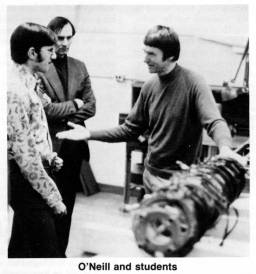 COSMIC SEARCH: Tell me more about that please.
COSMIC SEARCH: Tell me more about that please.
O'NEILL: It was a proposal that came totally independently from many of us already working on this. It developed at the senator's own suggestion, and it's a very sensible one, that an agency which does not have an axe to grind in this business like DOE
(Dept. of Energy) or NASA (National Aeronautics and Space Administration), take an independent objective look at it and see whether it makes sense and whether it could be of advantage to the country economically. So he put it in the form of an amendment to the National Science Foundation (NSF) authorization act with a request that a study be carried out by the NSF.
COSMIC SEARCH: When did that occur?
O'NEILL: The original bill was introduced, as I recall, about March or April (1977). It went through committee, was reported out, and the whole bill was acted on by the Senate. It's now in Senate-House conference. It would not be a big thing as it's only
calling for a quarter of a million dollars in the first year, but it would be an objective study which, again, would be of great help in laying a broader base for a bigger study later on.
COSMIC SEARCH: But it would be an Act of Congress and that's significant.
O'NEILL: Yes, I think it is, and there are a great number of bills which have now been reported out of Committee in support of satellite power. There was also a very nice resolution that was put forth by Congressman Olin Teague of Texas at the end of last year on this subject so I would say that Congress has been very much aware of the need to open our options and to possibly consider new industries and new markets, things that would be of economic value.
COSMIC SEARCH: You have done a good job informing them. Getting our representatives and senators acquainted with these problems and convinced that they are worthwhile is important. Now I would like to bring up this problem about space activity, including solar power satellites, and the effect all this could have on searching for extra-terrestrial intelligence due to the radio interference the activity would create. Every time you put something up in the sky that has a transmitter, it's a potential interference threat. Do you see ways of reconciling this?
O'NEILL: Yes, I would think so, John. One of the first calculations that our group carried out for large scale industrial activity in space was concerned with building a large SETI-type receiving dish that would be placed at a long distance from the
earth and shielded from interference from the earth by a separate disc-like shield sitting in free space. We concluded that the operation looked very cost effective and that a far bigger SETI dish could be built for a comparable price than if it was located on the surface of the earth.
COSMIC SEARCH: You may be familiar with the recent Russian proposal to place some very large antennas, very large dishes, some kilometers in diameter at about the orbit of Saturn, constituting an interferometer with a baseline of about 20 astronomical units. It came as something of a surprise to me that with that kind of spacing and centimeter wavelengths that the entire universe is within the near-field or Fresnel field of the antenna and therefore it is possible in principle to measure the distance to every object in the universe. You could do 3-dimensional mapping—holography. Shklovsky and Kardashev are among those who have proposed this. It is something that tells us that radio astronomers are yet a long way from the end of their tether.
O'NEILL: Absolutely. I think it's a fine idea. It's an excellent example of the kind of radio astronomy that I certainly hope will be done in the next decades.
COSMIC SEARCH: What kind of a picture do you have of how things might go if expansion into space takes place? What kind of steps may occur?
O'NEILL: I think it may be rather haphazard. I would guess that within the next 5 to 10 years some nation, not necessarily the United States, in fact, probably not the United States, will get such a substantial edge on understanding the problems of maintaining people in space for long periods of time and carrying on large scale activities there, that other nations will begin to get scared and that the response will be a mad scramble to get out there. When that happens, presuming we have a president who would support it, as in the case of the Apollo project, I think there would be good Congressional support for a major effort in space and that the net
result would be that the United States would be in there among the scramblers. Another 10 years into the future from there—I'm guessing maybe the 1980s for this scramble to begin, so going into the 1990s—there will be several different nations with a
space capability and all of them will be carrying on large scale activities. So similarly in that time period it becomes almost a question of semantics when you determine that the first space colony was built. You know how many people are involved, how long they have been there and so on, but you end up with a sort of meaningless question. If you come back 10 years after that, now getting 20 to 30 years into the future, you will conclude that the jump was made even though you can't put your finger on exactly what year it was. Then I would expect that fairly soon in the next century, which is after all not far away, a number of industries could operate more economically in space than they could on the surface of the earth both from the point of view of the availability of materials and the low cost of assured sources of energy.
COSMIC SEARCH: You are assuming now that there will be astro-engineering—mining of the moon and asteroids?
O'NEILL: Yes, it is pretty small scale engineering after all. Some of the present contracts are looking into such projects, like the study being carried out by the Lunar and Planetary Institute. A very small scale of engineering is required to get to the point of being economically interesting. One or two bulldozers is all that it takes. So I would guess that that is inevitable at a
certain point.
COSMIC SEARCH: There would then be a gradual filling up of space around the earth resulting in a sort of Saturn's ring of space stations?
O'NEILL: Perhaps so if there are satellite power stations, but, of course, they are just one space application. The kind of guesses that I have made with you, John, are not predicated on satellite power turning out to be economically the best way to go. I think that if satellite power does develop as the best possible method for generating large quantities of base load power then the whole movement into space may go somewhat more coherently, perhaps a little bit faster, but it won't make an enormous difference. I think it's going to happen anyway. One of the first things that people are going to discover when they get out into space in substantial numbers is that the region immediately around the earth is not necessarily the best place to locate a space colony. It might make a lot more sense to go to a place which is richer in solar energy, which means moving in closer to the sun, or richer in materials, which means going to the asteroid belt.
COSMIC SEARCH: One of the benefits of SETI is that it gives us a cosmic perspective. We are so earth oriented that this is needed and certainly space colonization will aid in giving this perspective. These are goals that all of mankind can use to enter into a new phase.
O'NEILL: Right.
COSMIC SEARCH: You have given us a cosmic chart for the future. Thank you, Gerry.

 Gerard K. O'Neill is Professor of Physics at Princeton University where he has been a faculty member for 25 years. Born in Brooklyn, New York, in 1927, he served with the U.S. Navy from 1944 to 1946, received a bachelor's degree from Swarthmore College in 1950 and a doctor's degree from Cornell University in 1954. In 1956 O'Neill originated the principle of colliding-beam storage rings in which atomic particles circulate in the rings and then meet head-on, resulting in more efficient energy production than in an ordinary accelerator where moving particles strike a stationary target. Between 1959 and 1965, O'Neill and a team of physicists from Princeton and Stanford Universities constructed the first high-energy particle storage ring and produced head-on particle collisions. Subsequently, many storage rings have been built, the largest, two kilometers in diameter, being at the European Center for Nuclear Research (CERN) at Geneva, Switzerland.
Gerard K. O'Neill is Professor of Physics at Princeton University where he has been a faculty member for 25 years. Born in Brooklyn, New York, in 1927, he served with the U.S. Navy from 1944 to 1946, received a bachelor's degree from Swarthmore College in 1950 and a doctor's degree from Cornell University in 1954. In 1956 O'Neill originated the principle of colliding-beam storage rings in which atomic particles circulate in the rings and then meet head-on, resulting in more efficient energy production than in an ordinary accelerator where moving particles strike a stationary target. Between 1959 and 1965, O'Neill and a team of physicists from Princeton and Stanford Universities constructed the first high-energy particle storage ring and produced head-on particle collisions. Subsequently, many storage rings have been built, the largest, two kilometers in diameter, being at the European Center for Nuclear Research (CERN) at Geneva, Switzerland.
More recently, as an outgrowth of an undergraduate course, O'Neill has become interested in the space colonization concept. His first publication on the subject appeared in the September 1974 issue of PHYSICS TODAY. This article and his book "The High Frontier: Human Colonies in Space" (William Morrow and Co., 1977) have generated widespread interest in his ideas of employing, within the limits of present-day technology, materials and energy freely available in space to construct large manufacturing facilities and human communities in very high orbit above the earth. O'Neill enjoys mountain hiking, sailing boats and flying gliders.
|
SIDEBAR
Regarding O'Neill's interstellar vehicles, it is easily shown that to achieve one-tenth the velocity of light (using the annihilation energy of matter and anti-matter) about one-tenth of the mass of the interstellar vehicle needs to be in fuel. However, the mass of the "fuel tanks" (or storage tanks) might be considerably more.
The momentum of a vehicle of mass M and velocity v is Mv. The momentum of the photons produced by the annihilation of the mass m of matter and anti-matter is mc, where c is the velocity of light. Equating momenta,
Mv=mc or m=(V/c)M
For a vehicle with a velocity v of one-tenth the velocity of light we have
m=(1/10)M
Thus, the required mass of the matter-anti-matter fuel is one-tenth that of the vehicle mass. Since an equal amount of fuel will be required for deceleration at the destination star, the total fuel requirement is twice this.
The energy of the vehicle is (1/2)Mv2. The energy produced by annihilation of the mass m of matter and anti-matter is (from Einstein's equation) equal to mc2. The efficiency of the system is the ratio of these energies or
(1/2)Mv2/mc2
From the conservation of momentum, as above,
v=(m/M)c
so the efficiency becomes
(1/2)(Mm2c2)/(M2mc2) = (1/2)(m/M)(mc2)/(mc2) = (1/2)(m/M)
In our example,
m=(1/10)M
so the efficiency is
1/20 or 5 percent.
Although the above analysis is simplistic, it gives some insight into the considerations involved.
|
|
|
A Single Vote
An Historical Fable by Sedgewick Seti
[Article in magazine started on page 24]
Hans Christian Oersted lived in Denmark. One day in 1819 he connected a wire to a new galvanic cell he had acquired. A compass happened to be lying near the wire and Oersted noticed that its needle moved. When he disconnected the wire the needle returned to its normal position. Oersted was intrigued. The experiment suggested to him that the current in the wire produced some kind of force which
affected the compass needle. This could be important, he thought, and more work should be done so he prepared a proposal for a research grant to study the effect further.
In due time his proposal for 100 kroner came before his country's august Parliament for consideration. Lord Allsen spoke out forcefully against Oersted's proposal. It would be a waste of the taxpayers' money, he pointed out, to spend even one pence to find out more about what a wire would do to a compass. What was needed, he said, was more practical research like developing longer burning, brighter candles that didn't need their wicks trimmed as often or breeding faster horses so that messages could be carried between cities more swiftly. Lord Allsen promised to do all he could to support research for better candles and faster horses.
Others spoke against Oersted's proposal but finally Lord Bensen was recognized by the King who was presiding over the Parliament. Lord Bensen explained that what Oersted had discovered might be just a beginning, the first insight into other effects, and although he could not foresee what these might be, they could lead to developments of considerable value. Oersted was an explorer like Columbus or
Magellan; his finding was something new and he should be spported, Lord Bensen pleaded.
A lively discussion followed, much of it in acrimonious exchanges between supporters and opponents of the proposal. Finally, the King rapped his gavel to end the discussion and call for a vote. It was very close, but Oersted's proposal carried by a single vote.
Backed by the grant, Oersted extended his research and this led to further work by Faraday, Maxwell, Hertz, Edison and many others so that today we have electric motors, generators, and lights, the telegraph and telephone, radio, television, electronic computers and a host of other devices. It is interesting to speculate that if Lord Allsen and other Lord Allsens had had their way we might enjoy none of these today, the world would have been spared the blight of everything electrical but we might have better candles and horses so fast that, working in relays, a message could reach Chicago from New York in no more than 3 days.
|
The Case for SETI
By: Richard Berendzen
[Article in magazine started on page 25]
This article is a slightly abridged version of the statement Dr. Berendzen presented before the Subcommittee on Space Science
and Applications of the U.S. House of Representatives' Committee on Science and Technology at Washington, D.C., September 19, 1978.
Mr. Chairman and members of the Subcommittee on Space Science and Technology, I appreciate this opportunity to testify before you on the subject of SETI — the Search for ExtraTerrestrial Intelligence.
In the 19th century, Thomas Carlyle considered the stars and said: "A sad spectacle. If they be inhabited, what a scope for misery and folly. If they be not inhabited, what a waste of space." Or, as Lee DuBridge, Science Adviser to President Eisenhower, put it: "Either we are alone or we are not; either way boggles the mind."
The quest for mankind's kin invariably prompts philosophical speculations. But on the basis of modern knowledge, what actually do we know about this esoteric yet enthralling subject?
As recently as a generation ago, most scientists would have argued, often ex cathedra, that the likelihood is low that life exists beyond Earth. However, as Martin Rees has succinctly noted, "Absence of evidence is not evidence of absence." And accumulating evidence during the last two decades has convinced many scientists world-wide that extraterrestrial life probably does exist, possibly in enormous abundance. It must be noted, however, that incontrovertible proof has yet to be found: to date, the evidence is strictly
circumstantial, but it is highly suggestive and possibly compelling. Today, the serious scientific search for extraterrestrial life commands the attention and respect of many of our most prominent, careful, and judicious scientists. SETI — in its sophisticated, modern form — is solid and sober, not tawdry or sensational.
Even for many informed skeptics, the question of the existence of extraterrestrial life has become not so much one of if as of where, and with regard to the search it has even become when, for ultimate contact may be virtually inevitable. This view was summarized recently in a report by the august U. S. National Academy of Sciences:
Each passing year has seen our estimates of the probability of life in space increase, along with our capabilities of detecting it. More and more scientists feel that contact with other civilizations is no longer something beyond our dreams, but a natural event in the history of mankind that will perhaps occur within the lifetime of many of us ... In the long run this may be one of science's most important and most profound contributions to mankind and to our civilization.
Life, yes — but in what forms? Extraterrestrial beings almost certainly will not be humanoids. It would be too extraordinary if this planet's conditions were duplicated precisely elsewhere. Our life resulted from a lengthy, delicate evolutionary process, which would have been permanently changed if any of a multitude of parameters had been different. Thus, although many scientists believe that life, even in advanced forms, probably is ubiquitous in the universe, they are equally convinced that there are no humans beyond Earth. In Loren Eiseley's words: " ... nowhere in all space or on a thousand worlds will there be men to share our loneliness ... Of men elsewhere and beyond, there will be none forever." Even in a fertile cosmos, life here remains unique and precious.
Biochemists believe that of the 100 plus elements known to man, only one can be the basis of life, here or elsewhere — carbon. Given that terrestrial life consists of aggregates of complex carbonaceous polymers, such an assertion may appear chauvinistic; actually it reflects nature itself. Carbon is the only known element capable of forming the intricate molecules so seemingly essential to anything approximating life as we understand it.
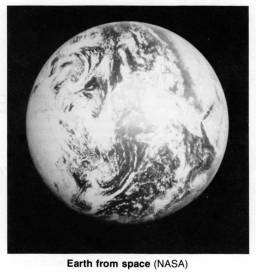 The insightful question about the genesis of life on Earth is not, "Was it miraculous?," but rather, "Was it unique?" In the 1920's, the biochemists Haldane in England and Oparin in Russia independently suggested that organic compounds could be produced from elementary inorganic molecules. Increased knowledge about the Earth's primordial atmosphere indicated that it had contained appropriate ingredients for the origin of life — hydrogen, ammonia, methane, water vapor. Then, in the early 1950's, Miller and
Urey dramatically showed that these molecules would form amino acids if subjected to a laboratory simulation of the Earth's early conditions.
The insightful question about the genesis of life on Earth is not, "Was it miraculous?," but rather, "Was it unique?" In the 1920's, the biochemists Haldane in England and Oparin in Russia independently suggested that organic compounds could be produced from elementary inorganic molecules. Increased knowledge about the Earth's primordial atmosphere indicated that it had contained appropriate ingredients for the origin of life — hydrogen, ammonia, methane, water vapor. Then, in the early 1950's, Miller and
Urey dramatically showed that these molecules would form amino acids if subjected to a laboratory simulation of the Earth's early conditions.
Subsequent research supports the conclusion that life likely will arise spontaneously, given the right initial situation. Of course, if we are wrong on this, irrespective of the cosmos's vastness, we could be alone. Even though terrestrial life now is hearty and adaptable, any one of a multitude of possible calamities could have prevented our development, such as inadequate supply of terrestrial water, severe irregularities in solar luminosity, major dynamical perturbations by the moon or planets, or collision with
another astronomical object. Our biological beginnings may have been special, even unique; or perhaps no other suitable habitat exists. But besides the philosophical repugnance of this egocentric view, modern findings seem contrary.
Therefore, many of us believe that, under reasonable conditions, chemical and biological evolution will be inevitable. And, although the appearance of extraterrestrials may be wildly different from our own, their chemistry will be at least remotely similar. If this last assumption is false, then the following statements will constitute a conservative lower bound; i.e., if non-carbon based life is possible, the overall prevalence of life will be even greater.
Of all the celestial objects, the one that for the longest time has prompted man to wonder if he is alone is the enigmatic Mars. Like Earth, it has seasons during which its polar caps shrink in the spring, while its equatorial regions darken as if vegetation were being nourished by melting liquids.
 And in 1877, a leading Italian astronomer reported sighting long rectilinear features on the Martian surface — "canali," or channels. This innocuous term was later Anglicized to "canals," which implies intelligent intervention. At the turn of the century, the quest for Martian life was championed by Percival Lowell of the prominent Boston family; and, in the early 1920's Marconi reportedly detected Martian radio signals. Moreover, on the evening of 21 August 1924, as Earth and Mars passed exceptionally close to one another in their elliptical orbits, many radio stations worldwide ceased broadcasting for several minutes each hour in order that Martian radio signals might be detected.
And in 1877, a leading Italian astronomer reported sighting long rectilinear features on the Martian surface — "canali," or channels. This innocuous term was later Anglicized to "canals," which implies intelligent intervention. At the turn of the century, the quest for Martian life was championed by Percival Lowell of the prominent Boston family; and, in the early 1920's Marconi reportedly detected Martian radio signals. Moreover, on the evening of 21 August 1924, as Earth and Mars passed exceptionally close to one another in their elliptical orbits, many radio stations worldwide ceased broadcasting for several minutes each hour in order that Martian radio signals might be detected.
Another impetus to the Martian intrigue arose in the mid-1930's, when a clergyman read a story over British radio alleging that communists were invading the countryside. That this fictitious account should elicit widespread consternation prompted a perspicacious young American radio producer to employ a similar ruse but with creatures even more terrifying than communists — Martians. This led to the famous radio hoax in 1938.
Due to local atmospheric turbulence, ground-based astronomy from Earth cannot provide a definitive answer about the nature of Mars's surface; hence, an in situ experiment was needed. In 1971, our understanding of Mars changed dramatically as a NASA probe returned by far the best photographs seen of the planet until that time. Although they did not settle the question of Martian life, they revealed a fascinating world, with gargantuan volcanos and colossal canyons. The fabled canals were revealed to be nothing more than undulating natural depressions, and the equatorial darkenings were explicable without life forms.
Still we do not know about the possible presence of microscopic Martian life. The rigors of Mars would make life difficult although not insuperable. NASA's Viking mission has been stupendous but many questions remain. If even elementary life forms were discovered on Mars or elsewhere in the solar system, we would be emboldened, for the presence of two life-supporting objects about a single star would strongly imply prevalence elsewhere.
But our discussion today focuses on intelligent extraterrestrial life, and that unquestionably implies a search outside our solar system.
To proceed, let us assume that life will arise only, if not reside permanently, on planets, not in interstellar gas clouds or elsewhere. Again, if we were wrong on this, our estimates would be too conservative.
Our story now must turn to the planets's parents, the stars. Our Sun is one of more than 250 billion stars composing the Milky Way galaxy, in a universe containing tens of billions of galaxies. In fact, there are more stars in the heavens than there are grains of sand on the beaches of Earth. Of these multitudes of stars, which might make suitable parents for life-supporting planets? A candidate
star should be moderately luminous, roughly like the Sun. Extremely luminous stars burn nuclear material so rapidly that their lifetimes are mere fractions of the Sun's; hence, life near them probably would have insufficient time to undergo the arduous process of evolution. In contrast, extremely under-luminous stars burn slowly, permitting biological evolution; but their ecospheres, or habitable zones, would be small, requiring potentially life-supporting planets to orbit so close that they would be forced to keep one face perpetually towards the star, thereby evaporating their atmosphere on one side while freezing it on the other. A candidate star should also be temporarily stable; it should not pulse in size, or erupt, or throw off gaseous shells, or spin frantically. Therefore, we omit as prime candidates such objects as variable stars, novae, planetary nebulae, and pulsars.
The planets themselves must not undergo dynamical perturbations. Roughly half the stars in our galaxy are members of multiple systems in which two or more stars lock gravitationally and orbit each other. Planets around a member of such a system might be perturbed by the other star. To be cautious, let us discard all multiple star systems as being dangerous abodes for life.
The next question is whether any of the suitable stars actually possess planets. Several independent lines of evidence suggest they do. Theory indicates that stars form by condensing gravitationally from the gas and dust that lace throughout a galaxy's spiral arms. As such a nebula contracts, apparently it can split into clumps of different mass: a large one with several small companions, leading to a single star with planets; or several of comparable size, leading to a multiple star system. In principle, a substantial fraction of the suitable stars could possess planets.
And planets appear to be observed orbiting some of the stars nearest the Sun. Interstellar distances are so vast that a Jupiter, much less an Earth, would scarcely be visible directly at even the nearest star. Planets can reveal themselves indirectly, though, by the minute wiggle their gravitational pull causes in the path of their parent star. After decades of painstaking observations, such perturbations seem to have been detected for a few nearby stars. (The measured size ofthese shifts, incidentally, is about the same as a hair's angular diameter as seen at one mile.)
The planets appear to exist, but are the requisite chemicals available? Even though chemical analysis of these planet's atmospheres lies far beyond our present capability, in the past few years radio astronomers have discovered numerous forms of interstellar molecules, including biologically significant ones. Considering that the planets formed in such an environment, it seems highly plausible that their atmospheres contain the substances necessary for biochemical evolution. Hence, we now strongly believe that the suitable parent stars exist, the planets exits, the chemicals exist, the necessary conditions exist. But does all that imply that extraterrestrial life exists?
Findings and conjectures such as these have prompted several bold efforts to estimate the number of extant civilizations that might be attempting interstellar communications within our galaxy. Even though such calculations obviously are plagued by unknowns, science can provide educated guesses for all the factors involved, save one — the length of time a civilization will spend in a communicative phase. The number of civilizations in the galaxy today turns out mathematically to be roughly equal to this time span expressed in years; e.g., if advanced civilizations survive for an average of a million years, then about one million of them are extant in our galaxy. Paradoxically, the greatest uncertainty in this calculation may arise not from the study of nature but of Man.
Within the solar system we can search directly for non-intelligent lower life forms like ferns or bacteria. But outside our parochial environment, the hypothetical creatures must be communicative if we are to find them. The most dramatic way to communicate would be through direct contact; however, even using wild extrapolations of contemporary technology, deep space voyages seem highly problematic. If a rocket could burn with the efficiency of the solar interior, the energy requirements for a round trip even to a nearby star still would be enormous. Such pessimistic conclusions are based not on our ability in technology but on our understanding of nature. The distances between stars are characteristically light-years; yet, Einstein showed us that no craft can travel faster than the speed of light and even to approach that rate would require titanic expenditures of energy. Although perhaps ingenious solutions eventually can be found, most astronomers today concur that interstellar space travel will be untenable, at least for Earthlings, probably for generations to come.
Nevertheless, interstellar communication could be achieved immediately by using the fastest, most efficient mode known — the electromagnetic spectrum, of which visible light is only a small portion. In the 19th century, several imaginative but vain proposals were made for attempting visual contact. The mathematician Gauss, for instance, suggested planting a pine forest in Siberia in the
shape of a Pythagorean triangle, as a detectable sign of terrestrial intelligence. And an astronomer proposed signalling by burning kerosene in a 20 mile-wide ditch to be dug in the Sahara desert.
Are we equally naive today? Undoubtedly! That unprofound observation, however, should not prevent action; if it were to do so, we would ensure the blunting of mankind's ingenuity. To paraphrase William James, only by risking do we live at all.
Astronomers now study the heavens with radio waves as well as with visible light, and such bands now seem to offer the uniquely rational mode for interstellar communication: They are easily transmitted and received, propagate over interstellar distances without being absorbed, stand out against background stars, and travel at the maximum speed in nature — that of light.
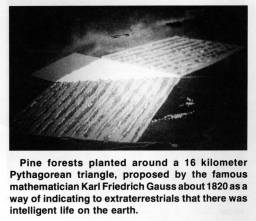 Coincidentally, we on Earth inadvertently have been sending out such signals for the past few decades, through our use of radio and television and of military and scientific radar. At present, mankind's major interstellar emissary is commercial radio and TV.
Coincidentally, we on Earth inadvertently have been sending out such signals for the past few decades, through our use of radio and television and of military and scientific radar. At present, mankind's major interstellar emissary is commercial radio and TV.
But to communicate this way, we should follow a play on Biblical dictum: In the case of SETI, it is better to receive than to send. We fail to know not only exactly where and how to send but also when. Even if we knew that a certain star had a habitable planet and that radio was the proper medium, our message might not arrive there at the proper epoch: It could come before the inhabitants had evolved to the level of radio technology or after they had passed that era or even after they had annihilated themselves. If we were to receive a signal, such problems would vanish. On the other hand, if each civilization were to follow such logic, none would transmit, at least until it could do so without being exorbitantly consumptive. Because our radio ability is in its infancy, we are as technologically primitive as a civilization can be and yet achieve interstellar communication. Thus, if we make contact, the other beings must be as scientifically advanced as we, and possible eons ahead.
On 8 April 1960, the first serious attempt by man was made to intercept signals from other beings, when a radio telescope was tuned to 21 centimeters. (1420 megahertz) and pointed at a Sun-like star about 10.5 light-years away. (See "A Reminiscence of Ozma" by Frank D. Drake in the January 1979 COSMIC SEARCH). Since then other searches have been made in the United States and abroad, looking towards a handful of nearby candidate stars, usually at 21 centimeters, because interstellar hydrogen emits at that wavelength, producing a prominent natural marker presumably known to all advanced beings.
The attempts to date have been negative, as one would expect considering the range of unknowns involved. Nevertheless, it is sobering to realize that today the world's largest radio telescope — the 300 meter diameter surface at Arecibo, Puerto Rico — would be capable of communicating with its twin, if one existed, even in a distant part of the galaxy.
Contemporary science is already able to identify candidate stars and likely wavelengths, and contemporary equipment could detect the signals if they were transmitted with devices no more powerful than our own. These are but a few of the reasons why many serious scientists treat the search with new respect: Science fiction is rapidly becoming science fact.
Presumably, the initial discovery of life elsewhere will be made one-way and at-a-distance; that is, we will infer the existence of life on another planet by detecting non-natural, quasi-coded radio emissions from it. Such signals could be intentional messages or inadvertent radio noise, revealing the other planet's advanced technology. Of course, other scenarios probably will occur, especially
among advanced beings, but irrespective of the details, inhabitants here seemingly will have at least these options: to avoid response; to return a radio signal that can be readily detected and decoded; or, possibly, to launch spacecraft towards the other planet. Clearly, if Earth ever discovers such a radio emission, mankind will face monumental decisions.
Regardless of the wisdom of making initial contact, it could occur serendipitously: At our modern level of technology, we might accidentally discover other civilizations or vice versa. Although we can only poorly affect the ability of others to detect us, we can strongly influence our capability to find them, by making concerted searches. But should they be made?
Science fiction is replete with tales of potential hazards, a common one being the invasion of Earth. But such holocausts would require the other beings to be aware of us, as well as we of them; also, it assumes the feasibility of interstellar space flight. As another danger, the beings elsewhere could subvert us intentionally with their seemingly beneficent broadcasts, playing on our ignorance. Obviously mankind would have to proceed carefully, guarding against impetuosity or gullibility. And there is the serious
possibility of culture shock. Just the realization that we truly are not alone might be traumatic, but would it threaten our egos or shatter our institutions? Even the converse could happen: At last the commonality of all Earthlings might become more apparent. But suppose the messages we received were both benign and voluminous, enabling us to leap centuries in knowledge. Would that celestial umbilical cord rob us of our own ingenuity, or would it inspire us to new heights?
The most frequently cited benefit to come from contact would be instant technological gain. Even though this might occur, the immense distances militate against lively repartee. A two-way conversation would require tens or possibly hundreds of years, even using radio and anti-cryptography (that is, readily readable messages based on parameters in nature). But if information could be transmitted and deciphered — from an advanced, friendly civilization to us — it might enhance our understanding not only of science and technology but also of arts and humanities. Perhaps it would provide us with new aesthetic forms, raising our consciousness and making life more rewarding. And the very existence of such long-lived civilizations would prove that the rigors of survival are not inevitably debilitating. In short, we possibly could join what has been called the "galactic heritage".
And with our ability to comprehend comes a yearning to explore, to move out of Cradle Earth, even to know our kin beyond. If the estimates of scores of modern scientists are correct, at this instant there may be thousands if not millions of advanced civilizations, whose radio transmissions are passing not merely through space but even through our very bodies. If we only knew exactly where and how to look and had the will to do so, life on this planet might at last reach childhood's end.
Rarely, however, do major triumphs come easily. Requiring monumental ingenuity and resolve, this search would be like virtually no other effort known before. What we contemplate here would challenge our imagination and wisdom with unprecedented effort in diverse disciplines; moreover, it would test our fortitude, possibly spanning not only terms of Presidents but also lifetimes of scientists and even of nations.
But irrespective of the pros and cons of searching, would the inquisitive human mind be willing to forego the quest? Within the next few decades we will have explored most of the "ghetto Earth", as our planet might be viewed in its present state of cosmic quarantine. Will humankind limit its vision over astronomical time periods to this minute locale, especially with the ability to do otherwise at hand?
The sternest arbiter of all is not the President, the Congress, or even the People; it is Time. Before that unforgiving master, how will our judgments stand? As we sit in the Court of Ferdinand and Isabella, will we give Columbus his ships? Are we willing to look through Galileo's telescope? Dare we join Darwin on the Beagle? How long will we tarry at Newton's seashore, while the ocean of truth lies undiscovered?
Only in exceptional epochs do we face such decisions. Now is one of those times. Even though the issues here perhaps seem vague, implausible, and futuristic, their ultimate significance possibly could dwarf the Apollo Project, if not the entire space program.
But about this search we are fearful — of appearing naive, of venturing imprudently, of proceeding hastily, of squandering resources, of confusing priorities, even of achieving success. Yet, as Bronowski has noted generally: "We are all afraid — for our confidence, for the future, for the world. Yet every man, every civilisation, has gone forward because of its engagement with what it has set itself to do."
• Our root questions here come down to these:
1. Are our reasoned suppositions and circumstantial evidence misleading or wrong? Given that we cannot know the answer precisely, are we yet confident enough to proceed? If not, when will we be—at what stage of discovery, with what degree of certitude?
2. How much are we willing to pay to achieve contact—in terms of money, time, and commitment—especially if for decades the search were unsuccessful?
3. And even if the search is practical now, do we actually want to know if there is life beyond Earth? Do we want to make contact?
• Each person must answer individually:
1. For myself, I am impressed by the current evidence, even if not entirely convinced. That the modern findings are inconclusive and incomplete is unarguable, but so too is the unmistakable fact that they cannot be ignored. Science never rests. Contrary to popular belief, science is not an immutable body of absolutes — codified, comprehensive, and final; rather, it itself is a growing, evolving process. And that generic truth holds for the case here. Instead of only lamenting about our ignorance, let us also rejoice at our knowledge; while steadfastly recognizing our limitations, let us likewise acknowledge our achievements. And of late, they have included the piecing together of a wondrous mosaic — spanning eons of time and leaping millions of light-years in distance, ranging from stellar core to atomic nucleus, from primordial egg to human gene. The data are not all in, nor will they ever be. But from what we do know, a reasonable person could reasonably conclude that we likely are not alone.
2. Any responsible search should include, at core, cutting-edge science and technology; accrued benefits should be both potential and immediate. Like in any pursuit, the suitable level-of-effort in this one should be simultaneously frugal and adequate, commensurate with the task. But would even modest funding for such a search be extravagant or wasteful? In short, would the search be worth the cost, however low? If contact eventually were achieved, the $24 purchase of Manhattan Island would pale in comparison; and even if the search were not successful, the ancillary scientific and technological benefits alone would justify it.
3. I believe Mankind's desire to know if we are alone and to make contact with life elsewhere is instinctive, innate, indelible. If not now, then soon, a methodical search will begin. If not by the United States, then by other nations, it will be made. And I believe here and now to be the proper place and time. To me, the answer is clear and irrefutable: Yes, let us proceed!
Richard Berendzen is University Provost of the American University, Washington, D.C., and a member of the Editorial Board of COSMIC SEARCH. For the premier issue (January 1979) he contributed an editorial "Science and the Multitudes" and also an article "Time and a Cosmic Perspective," a biographical sketch accompanying the latter.
Berendzen on SETI:
• "SETI is solid and sober, not tawdry or sensational."
• "A methodical search will begin. If not by the United States, then by other nations, it will be made. The answer is clear: Let us proceed!"
• "Contrary to the Biblical dictum: In the case of SETI, it is better to receive than to send."
• "SETI may be one of science's most important and profound contributions to mankind and our civilization."
|
|
The SEnTInel (SETI News)
By: The Editors
[Article in magazine started on page 30]
- The Need for Protection of Frequencies for SETI
- Life Believed to Originate in Space
- Penzias and Wilson Receive Nobel Prize
- Infinite Radio Ranges not Possible
- Ultra-Narrowband SETI
- A New Type of Dish Antenna
- SETI Considered Enterprising
- Navy takes over NRAO Interferometer
The Need for Protection of Frequencies for SETI
Contributed by Mark Stull and Charles Seeger
Over a century ago, Thomas Huxley wrote in Man's Place in Nature: "The question of questions for mankind—the problem which underlies all others, and is more deeply interesting than any other—is the ascertainment of the place which Man occupies in
nature and of his relations to the universe of things. Whence has come our race; what are the limits of our power over nature and of nature's power over us; to what goal are we tending; these are the problems which present themselves anew and with undiminished interest to every man born in the world." The scientific exploration we call SETI (Search for Extra-Terrestrial Intelligence) speaks directly to this ancient question.
At present the most practical approach to SETI is to search for radio signals from other civilizations. Under these circumstances, the frequency band from 1400 to 1727 megahertz (MHz) is of unique value. Signals from other civilizations might be broadcast at any frequency, but it is within roughly this small fraction of the spectrum that we have the greatest ability to detect one. This is not a temporary technological situation. Rather, it is because this band lies in the frequency range where naturally emitted interfering cosmic background radiation (or noise) is least. A weak signal in this band might be detected while a stronger signal from the same civilization but at a frequency well outside this band might not be. Moreover, it is possible that extraterrestrial societies may deliberately choose this band for transmissions meant for detection by civilizations unknown because they, too, would realize not only that it lies in the frequency range where information transmission is most efficient, but also that it contains the prominent interstellar spectral lines of hydrogen and hydroxl, the decomposition products of water. If another water-based intelligent life form wished to call attention to itself, it seems an obvious place to advertise. Hence, this band had been dubbed "the waterhole."
By historical accident, the 1400 to 1727 MHz band is now largely free of terrestrial signals which would seriously impair SETI observations. In fact, SETI can easily share the waterhole with the many low-power earth-based transmitters currently using these frequencies, and spurious emissions from powerful transmitters outside the band may be the most annoying terrestrial sources of interference. But this happy situation is well on the way to changing drastically. There are already a few experimental satellites using the waterhole, and unless action is taken at the World Administrative Radio Conference (WARC) being held this year in
Geneva, Switzerland, large numbers of satellite systems will be introduced during the eighties and thereafter. There is no necessity for the proposed, or for the existing, satellite seruices to use this band. Technically, there are other satisfactory bands. The
present portions of the waterhole used for space-earth transmissions were allocated twenty years ago to possible future uses in the space service, long before such uses were defined and long before it was generally recognized that these frequencies were of unique value to SETI.
The upcoming WARC will have as its task the first complete revision in twenty years of the International Radio Regulations. These regulations are binding upon all members of the International Telecommunications Union (ITU). Whatever cooperative agreement is reached by the more than one-hundred-fifty nations which participate in the ITU, it will control worldwide spectrum usage for the remainder of this century and well beyond, because of the enormous investments involved in worldwide telecommunications systems. Thus, the 1979 WARC is an opportunity for SETI that must not be missed.
Present satellite use of the waterhole is relatively small. However, the maritime MARISAT system is slowly being brought into operation there, and the 24-satellite NAVSTAR, or GPS, system plans to use the band starting in the early eighties. Four prototype GPS satellites are already in orbit. Other major systems have also been proposed for the waterhole where, now, only a few meterorological [sic; meteorological] and other research satellites operate. The Federal Communications Commission (FCC), the civil radio spectrum authority in the United States, has tentative plans to open this band to television broadcasting. Beyond this, because of satellite economics and because of mankind's extraordinary lust for communication facilities, many other satellite systems will surely be developed. As a result, a huge investment in satellite systems will be made in the eighties and beyond, not only in the waterhole but throughout the microwave spectrum, and soon the earth will be surrounded by a brilliant man-made glare denying access to the universe from the surface of the earth over most of the microwave spectrum. This investment, perhaps as much as tens of billions of dollars, will create great economic pressure against an attempt at a subsequent WARC, to revise whatever allocations are devised in
1979. Certainly, any protection that might be given SETI in the waterhole at later WARC's would result in much greater economic dislocation.
Satellite uses of the waterhole today are few, and the design lifetime of orbiting transmitters is short (five to seven years), though construction for much longer lifetimes is planned for the eighties and thereafter. The need to replace equipment as it becomes obsolete provides an opportunity to engineer the new equipment to operate at a different frequency without incurring excessive costs. Then, too, a large fraction of present system equipment can be cheaply modified for operation in a neighboring or other appropriate
band. Although SETI observations around the world are increasing in number and comprehensive programs are being planned, the level of expected activity can accommodate the present satellite transmissions in the band well into the mid-eighties and perhaps longer, if need be. Thus, if prompt action is taken now, a plan can be developed and implemented that will protect the waterhole while minimizing the impact on satellite services now in the band. Such a plan should bar new satellite systems from the waterhole and provide a timetable for those currently operational or in advanced stages of design to obtain alternate frequencies. It should be noted that this would insure compliance with United States telecommunications law which requires that, in the allocation of frequencies, public interest considerations, such as those that motivate a SETI program, prevail over economic ones.
The interest of mankind as a whole in SETI is large and growing. Countries as diverse as India, Japan, Canada, the Soviet Union, and the United States are either carrying out or considering SETI programs. The detection of the existence of another civilization in the universe would provide splendid motivation for humanity to reconsider its self-image and could provide strong impetus toward a more
stable global political order. The very ideas inherent in SETI have sparked some established religious organizations to examine and expand their theologies. Moreover, for us to attempt to discover whether or not we are alone is indeed prudent, since earth has been
announcing its presence strenuously for several decades through its television and radar stations. We are discoverable, and contact initiated by an extraterrestrial civilization, the presence of which had not been suspected, could be a profound surprise.
The last WARC at which there was a complete revision of the International Radio Regulations was held in 1959. Then an issue arose that was similar to that presented by SETI, but which probably lacked the broad popularity of the subject of extraterrestrial life. This was protection from interference for scattered parts of the spectrum for radio astronomy. The United States initially expressed barely nominal support, but a loose international coalition of astronomers, scientists, scholars, and others finally convinced the ITU after a modest but inspired campaign. Though somewhat embarrassed, the United States reversed its policy in mid-WARC, and has since been an effective supporter of the needs of radio astronomy. Many of the spectacular scientific achievements of radio astronomy would probably have not yet occurred, were it not for this essential protection by the nations of the world acting through the ITU. No small element in the success of the radio astronomers at the 1959 WARC was their appeal for the right of mankind to know, coupled with the obvious
absence of considerations of private gain or national imperative that usually attach to demands for spectrum allocations.
SETI in the waterhole requires less protection and less total bandwidth than radio astronomy. But, like radio astronomy, without adequate international help it is more than likely that SETI at an effective level will have to be put off until it can be carried out
from space sometime in the indefinite future and at great cost.
Wouldn't it be heart-lifting to see the United States, the dominant exploiter of the microwave spectrum for satellite telecommunications systems, lead the effort at the 1979 WARC to respect once again humanity's right to seek, now, its "relations to
the universe of things"?
Those wishing to express their views about frequency protection for SETI should contact:
Dr. Frank Press
Executive Office of the President
Office of Science and Technology Policy
Washington, DC 20500
and the Commissioners of the Federal Communications Commission:
Charles D. Ferris, Chairman
Tyrone Brown
Joseph R. Fogarty
Robert E. Lee
James H. Quello
Abbott M. Washburn
Margita E. White
at the Federal Communications Commission
1919 M St., N. W.
Washington, DC 20554
Life Believed to Originate in Space
Scientific theories of the origin of primitive life may be divided into two broad categories—those which say that life originated solely from combinations of elementary substances here on the earth, and those which say that some necessary substances were deposited on the earth from space. The "deposited" theory received a boost recently by Sir Fred Hoyle (well-known astronomer) and Professor Chandra Wickramasinghe of University College, Cardiff, Wales. They concluded recently that the relatively large organic molecules now known to exist in space were deposited on the earth by comets and meteors, and served as seeds for the development of life. This idea bodes well for SETI, because the seeds are everywhere in space, and would need only to encounter a planet at the appropriate time in the planet's history for life to begin.
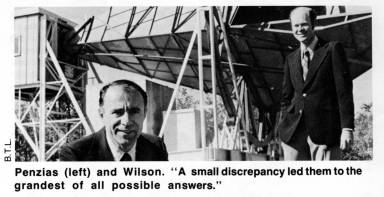
Penzias and Wilson Receive Nobel Prize
Radioastronomers Arno Penzias, 45, and Robert Wilson, 42, have received a Nobel prize for their discovery of the 3 degree kelvin sky temperature associated with the Big Bang fireball which created the universe. Penzias and Wilson made their observations in 1965 at the Holmdel, New Jersey, site of the Bell Telephone Laboratories (BTL) where another BTL scientist, Karl G. Jansky, discovered radio
waves of extraterrestrial origin in 1931.
Penzias and Wilson had measured a 3 degree excess in the temperature of their big horn antenna. They at first suspected its cause in some of the antenna's connections but finally concluded it was related to the creation of the universe. Their careful tracking down of a small discrepancy led them to the grandest of all possible answers.
Four radioastronomers are now Nobel laureates, the other two being Antony Hewish, 54, and Sir Martin Ryle, 60, of the Cambridge University, England, radio observatory — Hewish for his discovery of pulsars (see "Little Green Men, White Dwarfs and Pulsars" by Jocelyn Burnell in the January 1979 COSMIC SEARCH) and Ryle for his development of the aperture synthesis method of mapping radio
sources. Hewish and Ryle received the prize in 1974; Penzias and Wilson were awarded theirs in the most recent ceremony (1978), receiving together half of the physics prize of $165,000, the other half going to the 84-year-old Russian physicist Peter Leonidovich Kapitsa for his research on materials at low temperatures.
Infinite Radio Ranges Not Possible
It is a widely accepted fact of nature that signals having a narrow bandwidth can be transmitted and received over greater distances than signals having a wide bandwidth. This leads one to the conclusion that intelligent civilizations trying to contact one another across interstellar distances by radio would use the narrowest bandwidth that they could possibly achieve. If the minimum achievable
bandwidth is known, one can calculate the ranges that might be attained between two civilizations, making reasonable estimates of their transmitter powers and antenna sizes.
Heretofore it has been believed that this minimum achievable bandwidth was based primarily on the technological skills of the civilizations involved. It is technologically difficult, for example, to build receivers and transmitters that do not wander around slightly in frequency, thereby requiring the receiver bandwidth to be at least as wide as the maximum wandering width. Another technological difficulty is that of trying to compensate exactly for the Doppler frequency shifts caused by motions of both the
receiver and transmitter through space. Any inexactness in compensating the Doppler shifts requires that the bandwidth be at least as wide as the resulting frequency errors. It would seem reasonable then that more and more advanced civilizations would in time be able to do better and better jobs of solving these technological problems, so that their minimum achievable bandwidths, and hence their maximum ranges should increase indefinitely, with no particular ultimate limit. The great significance of this is that all civilizations could ultimately be within range of each other.
Recently, however, Frank Drake and George Helou of the National Astronomy and Ionosphere Center (N.A.I.C.) at Cornell University have
shown that there is an intrinsic property of the turbulent dust and gas between the stars that sets an absolute minimum to the achievable bandwidth.* [*N.A.I.C. Reports 75 and 76.] Although this gas is exceedingly thin, interstellar distances are so very large that a radio signal traveling through the gas is gradually split up into many separate signals, each of which arrives at the receiver at a slightly different time and frequency. This situation is analogous in its effect to long range voice communication in a giant room or mountain chasm. You hear multiple echos so closely spaced that they all blend together, making it difficult to understand what is being said. As you might expect, this effect gets worse at longer range, because there is more intervening gas. The net result of all this is that interstellar signals are going to have a bandwidth of at least 0.01 hertz from nearby stars, and 0.1 hertz from more distant ones, so there is no advantage for SETI in trying to push technology beyond that point.
A not-so-obvious property of this gas-caused minimum bandwidth is that it also depends on what frequency is used. Higher frequencies permit smaller bandwidths. If this effect is entered into calculations of the optimum frequency to use for SETI, Drake and Helou arrive at about 70 gigahertz (wavelength about 4 millimeters) which is significantly higher than that commonly advocated and searched. The earth's atmosphere makes ground based SETI programs at that frequency difficult but this obstacle can be overcome by making observations from above the atmosphere. Drake and Helou recommend that frequencies in the vicinity of 70 gigahertz be included in the list of those to be ultimately searched.
Ultra-Narrowband SETI
Soon after the lower limit to the bandwidth that can be used for SETI was calculated by Drake and Helou, Paul Horowitz of Harvard University actually used this minimum bandwidth.* [*"Science" Aug. 25, 1978.] With a bandwidth of only 0.015 hertz, he employed the 305-m diameter dish antenna at Arecibo, Puerto Rico to listen in the directions of 181 nearby stars. Each star was examined for eight minutes, searching for ultra-narrowband signals near the hydrogen line (1420 megahertz), assuming that the transmitting civilization had doppler-corrected their signals specifically for our solar system. Horowitz observed a total bandwidth
of 1 kilohertz, and recorded this on magnetic tape. At a later time, the tape was played back into a computer which divided the original 1 kilohertz bandwidth up into 65,536 different channels, each 0.015 hertz wide. This is the narrowest bandwidth ever used
for SETI purposes, and as a result this search is the most sensitive ever made of those stars.
No signals were detected, but Horowitz has successfully demonstrated that it is now possible for man to use the minimum useable SETI
bandwidth. He also makes the point that narrow bandwidth, together with his doppler correction techniques, are an answer to part of the problem of interference from man's own transmitters. A man-made transmission can easily be distinguished from an alien signal with Horowitz's techniques, which keeps the false alarm rate within reason. Nevertheless, a man-made signal will still blind the radio telescope to alien signals that might exist at the same frequency.
A New Type Of Dish Antenna
When something has been around as long as the dish antenna, you wouldn't think there would be anything new to say about it. Not so!
Sebastian Von Hoerner of the National Radio Astronomy Observatory in Green Bank, West Virginia, has come up with a method of designing
dish antennas which provides greater sensitivity and less noise pickup.* [*Institute of Electrical and Electronic Engineers, Transactions on Antennas and Propagation, May 1978.] Rather than using the traditional parabolic shape for the main reflector his method uses an unusual asymmetrical shape having several different curvatures. One of the prime motivations for his design was its potential use in SETI systems.
SETI Considered Enterprising
The Rolex Company of Geneva, Switzerland, celebrated the 50th anniversary of their enterprising invention of the world's first waterproof watch case, by sponsoring a competition to pay tribute and give tangible support to the human Spirit of Enterprise. Entrants were required to submit detailed proposals and descriptions of their enterprising projects. Over 3000 applicants from around the world entered in the three categories: Applied Science and Invention, Exploration and Discovery, and the Environment. Of these, 131 were selected for special description in a book just published, entitled "In the Spirit of Enterprise" (Freeman, 1978). One of
the selected projects is "Searching for Extraterrestrial Intelligence," submitted by Dr. Richard M. Arnold of the Bell Telephone Laboratories in Columbus, Ohio. Dr. Arnold is also an active participant in the ongoing SETI program at the Ohio State University
Radio Observatory. His proposal describes the current observing project, explains how it is being carried out largely by volunteers such as himself, and points out how its detection range could be substantially increased by only modest expenditure. His proposal
ends with the observation—"Nothing less than the question of our place in space and time is at stake."

Navy Takes Over NRAO Interferometer
The 2700-m three-element interferometer of the National Radio Astronomy Observatory (NRAO), Green Bank, W. Va., is now being operated
by the Naval Research Laboratory, Department of the Navy. From the completion of the last of the three telescopes in 1968 until September 30, 1978, the site was operated by Associated Universities, Inc., under National Science Foundation sponsorship.
The Navy Research Laboratory plans to maintain operation of the site for one year as a time-keeping instrument. A polar motion study is presently underway.
The first of three stations of the interferometer, the 85-ft. Howard Tatel telescope, was used by Frank Drake in 1960 to conduct the first SETI search, Project Ozma (see "A Reminiscence of Project Ozma," in the Jan. 1979 COSMIC SEARCH).
|
|
Generalized Life
By: Jerome Rothstein
[Article in magazine started on page 35]
Can matter evolve, even under conditions very different from those on the earth, into configurations or patterns, static or dynamic, which can be called life-like in some sense?
Jerome Rothstein leads you by well-reasoned thermodynamic arguments to the conclusion that many life forms could evolve in the cosmos that we would have difficulty recognizing. In the broadest sense, he describes generalized intelligent life forms as self-replicating, computer-controlled heat engines that are able to play survival games. — Eds.
Introduction
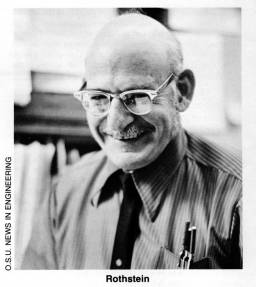 Can matter evolve, under conditions very different from those obtaining at any time in the history of the earth, into patterns or configurations which can be called life-like in some sense? What kinds of behavior should we call life-like? What kinds of behavior should we call intelligent? How can we avoid the trap of framing our concepts in a manner so closely tied to our earth experience and environment that we would not even recognize exotic life forms in the cosmos if we found them? What kinds of generalized life might exist?
Can matter evolve, under conditions very different from those obtaining at any time in the history of the earth, into patterns or configurations which can be called life-like in some sense? What kinds of behavior should we call life-like? What kinds of behavior should we call intelligent? How can we avoid the trap of framing our concepts in a manner so closely tied to our earth experience and environment that we would not even recognize exotic life forms in the cosmos if we found them? What kinds of generalized life might exist?
Such questions run very deep indeed. Trying to obtain solid scientific answers entails cutting across disciplines seldom yoked together in the past. Physics, chemistry, psychology, philosophy, are but a few. Whether we need to borrow concepts from ecology, organization theory, management science, sociology or game theory, is an open question. The possibility that new laws or principles are operative is always present.
We must cast a wide net, rely on the most universal and best established laws we can, and try to keep our speculations both free and disciplined. By this I mean not fettered by old habits and prejudices, yet disciplined by an appreciation of the great work of those who constructed the foundations on which we stand. Striking a proper balance between freedom and discipline is hard to do, and it sometimes takes the insight and courage of a Galileo, Einstein or Freud to do it.
The laws of thermodynamics are probably the closest approximation we have in science to "eternal verities." The great revolutions in physics accompanying quantum mechanics and relativity, for example, left them essentially untouched even though the rest of physics underwent tremendous conceptual upheaval. There seems to be well-nigh universal agreement that although thermodynamics will doubtless undergo extensive development in its applications to new areas such as biology, complex systems, and systems not in equilibrium, its existing solid core will be preserved intact. We therefore base our search on the first and second laws of thermodynamics, particularly on extensions of the latter. Other laws of physics will provide harmony, counterpoint, and thematic variations on an essentially thermodynamic melody.
Thermodynamics and Evolution
The first law of thermodynamics is often stated as the law of conservation of energy, i.e., energy can neither be created nor destroyed, only changed from one form to another. Its significance goes beyond this for conservation of energy, with dissipative processes (like friction) excluded, is a theorem in both mechanics and electrodynamics. The first law applies even when processes like friction make mechanical energy seem to disappear. The new form in which the energy appears is "heat", and many have taken quantity of heat as actually being defined by means of the first law. Heat is not mechanical energy; it is not measured by means used to obtain mechanical information. If this were not the case there would be no need to set up the first law as the basis of a new discipline. It would only be a theorem of mechanics! Thermodynamics came into being because of the great practical importance of phenomena usually idealized away and neglected in mechanics.
The second law of thermodynamics can be popularly characterized by saying that processes like friction have an inherently one-way aspect. For example, a spinning wheel may be slowed down by friction in its bearing, ultimately coming to rest, leaving the bearing hotter than it was before. But heating the bearing doesn't make the wheel spin (without auxiliary apparatus and having something else heated in the process). We can always convert "high grade" energy, like mechanical, electrical, or chemical energy, entirely into heat, but there are strong limitations on the conversion of "low grade" heat energy into a high grade form. These are the province of the second law of thermodynamics, of which one form states that in real processes the energy bookkeeping of the world always "enriches" the low grade energy total at the expense of the high grade total, with "breaking even" an ideal limiting case. This is expressed quantitatively in terms of a new thermodynamic quantity, called entropy, which never decreases, remains constant only in ideal cases, and generally increases. When an isolated system comes to equilibrium, its entropy increases to the maximum value possible for the total amount of energy in the system. For the wheel discussed above, this occurs when all the energy of rotation has been turned into heat by friction, and the whole system has reached a uniform temperature (the bearing is no longer a "hot spot").
"Thermodynamics urges, and the structure of the world allows, the evolution of things which can be called heat engines and computers."
What has this to do with the evolution of life? Coming to equilibrium is like dying! The second law says everything is running down, but organic evolution involves the long-term build-up of complex systems from initially simple ones. But the running down of an isolated system is not at all synonymous with the running down of a non-isolated system in permanent communication with a source of energy and a "sink" for waste heat. An engine in that kind of situation can continue to run indefinitely. The second law is satisfied if the total entropy change of the whole system is positive. We can get an "evolution" toward a steadily "running" state instead of to an equilibrium state.
This is what happened here on earth when life evolved, for the spinning globe presents any part (not too near the poles!) alternately to the sun (source) and to space (sink); this cycle drives the "machinery" of vegetation to this day. Animal "machines" use plants or other animals as their energy sources, burn the fuel, and discharge heat and waste to their surroundings (sink). But explaining how an existing machine can function is a far cry from explaining how the machine came to be there in the first place. Remarkably, thermodynamics gives a rationale for both.
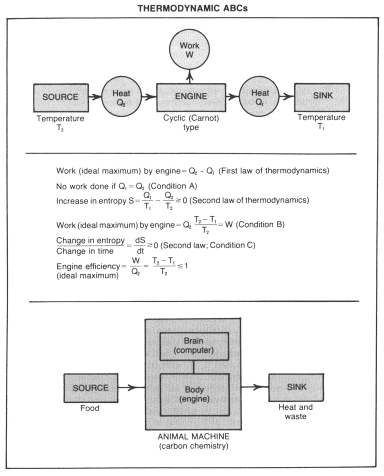 Living things are active and can do work on their environment. We will therefore advance our insight into their evolution if we can give a thermodynamic justification for the evolution of our system, over the course of time, from a state of no work done on each cycle (Condition A) (see box) to that of a Carnot heat engine (Condition B).
Living things are active and can do work on their environment. We will therefore advance our insight into their evolution if we can give a thermodynamic justification for the evolution of our system, over the course of time, from a state of no work done on each cycle (Condition A) (see box) to that of a Carnot heat engine (Condition B).
We need to generalize evolution toward equilibrium appropriately to a set of permanently imposed conditions which prevent our system from ever reaching equilibrium. The evolutionary time scale is long compared to a cycle; in our terrestrial case, for example, evolution can take millions of years, while a cycle may be comparable to a day. We can then regard the cycle time as being vanishingly small and re-express the second law case as a positive rate of change of entropy (Condition C). Under constant constraints the system will ultimately be driven to some steady value of the entropy increase rate.
But how is this steady rate related to the initial rate? If our system is initially disorganized, it can be expected simply to take in and then give out equal quantities of heat per cycle, and this is the situation of no work (Condition A). This is the "worst" case, where the rate of increase of entropy is maximum for the source and sink temperatures specified. In equilibrium cases the rate of change of entropy is exactly zero (its minimum possible value) because entropy is maximum. Following Onsager's pioneering work
(published in 1931) and since followed up by Prigogine and many others, we now know that in the steady state the rate of change of entropy is a minimum (or close to it). The approach to steady state is thus essentially an evolution toward the smallest rate of entropy production compatible with the nature of the system and the conditions imposed. But this says that insofar as it is possible, the system will evolve toward a combination of a perfect Carnot engine and a concentration of stored high grade energy (or something
close to it). This is a highly organized system. The price in entropy increase required for its evolution is paid by degrading some high temperature heat from the source into low temperature heat rejected to the sink.
The theorem of minimum rate of entropy increase need be only a very rough approximation for our purposes. We need an organizing principle, but we do not require perfection. Evolution of an inefficient engine, as long as its efficiency is not zero, suffices.
Structure, Computation, and Life
We now see that thermodynamics allows organized systems to evolve under permanently maintained non-equilibrium conditons, but we want to know what systems have the potential to do so. Many systems lack such ability. A container of water or a metal bar can be alternately heated and cooled with essentially no tendency for one cycle to differ from the next. We assume, of course, that the
temperature range is moderate; the container won't rupture, corrode, or leak, the water won't boil away or freeze, the bar won't melt, etc. These provisos suggest where to look, and the simple case where melting and freezing occur within a temperature cycle is a good place to start.
"The evolution of a system simulating life-like behavior is the evolution of life."
Consider a container with ice, water, and salt, in such proportions that all the salt would dissolve if all the ice melted, but if most of the water froze, then salt would crystallize out of solution. Such systems are not only important in old-fashioned home ice-cream freezers, but also in the Zarchin sea water desalination method (under study in Israel). One can choose cycle time, temperature range, container shape, and water to salt ratio to do many tricks just by temperature cycling alone. For example, salt introduced in one location could gradually disappear and settle elsewhere, and an initially uniform salt solution could eventually develop high and low salinity regions. Now electric cells can be built using such differences in concentration of dissolved salts. Our nerves and electric eels use them. So even this simple system soon evolves into something capable of storing some energy (in this case chemical). The heat flow through it permits it to do the work involved in changing salt concentrations in parts of an initially uniform solution.
The key feature is the phase change (solid to liquid and back). Salt behaves differently in ice (solid) and water (liquid). A change in how much salt is dissolved is "switched on and off" by changing from solid to liquid and back. The essential point here is control over some property in the sense that it can be switched between (at least) two different levels, where the change in property becomes manifest as a change in behavior. When it is present the possibility of cumulative effects arises, whereby cyclic change in state can result in evolution to a different behavior.
Several remarks should be made at this point to emphasize how general and powerful are the principles exemplifed in this simple example. First of all, in the present context there are many things equivalent to phase change. Gas becomes liquid when gas molecules become clusters of molecules which continually break up and reform, the change being essentially complete when the clusters are very large, on the average, and essentially no molecules spend more than a negligible fraction of the time free of cluster-mates. Cluster formation involves bonding together of molecules, analogous to bonding of atoms into molecules or to cross-linking of polymer chains in a liquid to form a solid plastic. Chemical reactions can be reversed, bonds can be broken as well as formed, the formation and
dissolution of cross-linkages can change a viscous liquid to a jelly-like solid and back (used for locomotion by amoebae by extending and retracting pseudopodia) and processes rapid in one situation may be slowed or prohibited altogether in the other. Switching and control are possible in a large variety of situations, including many of exquisite sensitivity to changes in external parameters. In our example that parameter was temperature, but almost any physical quantity will do in an appropriate system (e.g. pressure, chemical concentration, stress, electric or magnetic fields, etc.).
The second remark is that cumulative effects often involve what can, with justice, be called memory (information storage), where the system records its history in the sense that its present properties reflect what has been done to it previously. After each such change we start a new "ballgame", so to speak. Again simple systems often have this property. If one bends a metal bar and straightens it, it is more difficult to bend it again. This work-hardening effect, well known to the village blacksmith and to ancient sword-makers, is still of paramount importance in construction and manufacture.
The third remark is that these two things taken together give us the basic elements of a computer. It is possible to interconnect large numbers of switches (control elements) and information storage units in such a way that the system as a whole can carry out any procedure, be it computation, data processing, or anything representable in such terms. Of course everything must be encoded in terms of quantities appropriate to the particular system, but given this, any describable input-output behavior can be modeled (simulated) by such a system.
It may now not seem like such a reckless extrapolation to say two things: First, thermodynamics urges, and the structure of the world allows, the evolution of things which can be called heat engines and computers. When sufficiently developed they could realize behavior of almost arbitrary complexity. If we could but describe what we mean by life-like or intelligent behavior, we could then see
it modeled in the behavior of such a system. Secondly, we suggest that this is the basic idea needed to explain the origin of life and the eventual evolution of intelligence. After all, any physical system is an analog computer programmed to simulate its own actual behavior (which it does to perfection!). The evolution of a system simulating life-like behavior is the evolution of life.
Generalized Life
Life as we know it is chemically based. Information is stored largely in the specific composition and ordering of a small number of chemically distinguishable units in long chain molecules. Control (switching) is done largely by what chemists call catalysis. But thermodynamics applies to all systems in which concepts like work, energy, heat, and temperature are relevant. The tendency toward the
evolution of "well-informed heat engines" discussed above, being purely thermodynamical, is independent of what specific kind of thermodynamical system is under consideration. All that is required, essentially, is information storage and control, no matter how it is done. Chemical configuration is only one means of storing information, and catalysis merely a control mechanism appropriate to that
means. There are mechanical, electrical, and magnetic configurations capable of storing information, as in phonograph records or punched cards, in ferroelectric materials, or magnetic tapes.
Let us consider now some specific exotic systems in which evolution in complexity might conceivably lead to something like life. Our stability principles, which include both stable static configurations and stable dynamic configurations, originate, on the fundamental level of quantum mechanics, from two fundamental concepts. These are stationary conditions or states and the exclusion principle. The first gives both static and dynamic stability (it was conceived of by Bohr before quantum mechanics developed in its modern form). The second, discovered by Pauli, was applied by Bohr to building up the periodic table of all chemical elements. Briefly, in an atom or other system, no two electrons can be in the same state. So in building up heavier atoms by adding more electrons outside the nucleus, the electrons must go into states of higher momentum and energy (Bohr called them orbits originally). Carried further it explains many facts of atomic and molecular structure including stability, size, shape, and many other properties. Modern solid state physics and electronics are similarly based on quantum mechanics, and the field of quantum biology is now also rapidly expanding. Transitions between stationary states can occur, like that from the lowest energy state (ground state) to a higher state when the system absorbs energy. By emitting energy it can return to the ground state, frequently by way of states of intermediate energy, or it may end up in a metastable state (one of higher energy than the ground state but with low probability of jumping to the ground state). With metastable states comes energy storage. If this stored energy can be made available in organized, rather than chaotic fashion, we have the foundation for heat engines. This is dramatically demonstrated by lasers, and many other examples can be cited. In lasers, emission of radiation, whose energy has been previously stored in metastable states, is done in organized fashion with the radiation acting as its own catalyst. The first spontaneously emitted photons trigger the production of others which are coherent with them (i.e. not disorganized relative to them); this process, called stimulated emission, was predicted by Einstein in 1917.
We are now ready to consider specific systems. We will not discuss any life possibilities based on carbon or other ordinary chemistries because they have monopolized our thinking in the past. Rather we will look for possibilities where life, as ordinarily conceived, is impossible. Among these are frozen regions, like the surface of Jupiter, and hot regions, like stars. We begin with the latter, starting with neutron stars.
Neutron stars are small dense rapidly-rotating objects, perhaps ten miles in diameter, yet with a mass perhaps a quarter that of the sun. They have densities comparable to and higher than nuclear matter, possess tremendous magnetic fields, and are thought to be the objects known as pulsars. The surface of a neutron star marks a transition from ordinary densities to perhaps 10,000 times that of
water, and consists mainly of iron 56, the isotope which is the end-point of nuclear burning. The temperature is of the order of 100,000 degrees (kelvin). In the crust, thought to be solid, densities and temperatures rise rapidly by factors of the order of 1000, increasing even more in deeper layers. Nuclei will exist in a neutron sea, the way metal ions exist in an electron sea in ordinary solid metals, and the deeper one goes, the more particles the average nucleus will contain. Eventually the crust nuclei, electrons and neutrons all become a neutron liquid with very large nuclei "dissolved" in it. These neutron-rich nuclei contain thousands of particles compared to the hundreds at most in ordinary matter. Eventually they become big enough, as one goes deeper, to overlap and form what can be called a "macronucleus" or super dense liquid consisting of neutrons, a few percent of protons, and a corresponding number of electrons. As the density increases still further, new heavy particles can be formed (baryons, hyperons), and it is thought
that neutron stars have a dense hyperon core (perhaps ten billion times as dense as the surface).
What has this to do with generalized life? In the liquid core one has a transition region between small and large nuclei. The largest ones contain more particles than we humans contain atoms, and the small ones go down to very few particles. We have here the possibility of a "solution chemistry" of nucleons analogous to the aqueous solution chemistry of amino acids, proteinoids and proteins from which life evolved. The arguments given earlier from thermodynamics and quantum ideas are just as applicable to this case as to the chemical case. In principle, therefore, the theoretical basis for the origin of life is present in neutron stars just as it was on earth. We need only substitute big nuclei for big molecules, neutrons for water, and let our imaginations go.
There are other possibilities too. Who knows how many kinds of hyperons might be encountered deep inside the core? Mightn't there be concentric spheres of corresponding "big hyperon" solution chemistries? And going outward again, mightn't there be a region of cooperative effects involving iron 56 polymeric compounds? Magnetic field strength can serve as a thermodynamic variable just as
pressure can, and on neutron stars, particularly at the surface, it will have to play a decisive role.
White dwarf stars are not as dense as neutron stars, and allow fewer possibilities for nucleon or hyperon chemistry. At their cores, however, conditons may be extreme enough to allow some situations to develop like those at the outer layers of neutron stars. Also, if they or other stars are sufficiently rich in elements appreciably heavier than hydrogen, it is possible to envisage concentric spheres each with its own solution chemistry of atomic cores, partially stripped of their electron shells, in an electron sea. These could provide a spectrum of possibilities between ordinary chemistry and nucleon or hyperon "chemistry."
The foregoing situations are hot and heavy, but their opposites, cold and light, admit similar possibilities. Fundamental particles generally have a magnetic moment, or spin; they are like tiny magnets. Interactions between spins of different atomic or molecular systems are generally weak and drop off rapidly with increased distance between the systems. Within nuclei, atoms, and molecules, on the other hand, they are relatively strong, tending to line up antiparallel, cancelling out their magnetic effect. This explains why most substances are non-magnetic under ordinary conditions. But at very low temperatures even weak interactions can be felt because general thermal agitation of atoms and molecules has been reduced. Many substances which are non-magnetic at ordinary temperatures become ferromagnetic or antiferromagnetic when the temperature is low enough. So it may not be absurd to imagine that complex magnetic systems could evolve somewhere in cold space, possibly even as close as Jupiter. That planet has high magnetic fields, a cold surface, a solar energy source including ultra-violet and x-rays, and internal sources also.
It is possible to speculate about superconductivity and superfluidity along the same lines as just done with spin systems. The large variety of vortex systems in superfluids can rival that of big molecular systems in chemistry. They might even coexist with the magnetic systems just discussed. In addition superfluid systems might well exist in neutron stars! For neutrons in the crust, at sufficiently low densities, should interact attractively to form pairs. This creates a situation analogous to formation of electron pairs, which is the basis of modern superconductivity theory. This topic might well have been discussed earlier, and is clearly
important in the biology (!) of neutron stars. It might even be important in deeper layers too, for there may be other kinds of pair formation.
How about large scale low density systems? Magnetic fields permeate space and interact strongly with the tenuous plasma (ionized gas) found there. The motions of magnetic stars (including neutron stars) will do work on the plasma, and the plasma can affect many objects over a large region. Magnetohydrodynamic instabilities, turbulence, and driven steady states suggest that evolution of organized large scale behavior is possible. Refusal to entertain any possibility here of evolution of life-like behavior may be too traditional! But why stop there? Why mightn't one apply a kind of statistical mechanical analysis to galaxies, in which they play a role like that of molecules, and then use the non-linear equations of general relativity to envisage the slow evolution of complex assemblages of galaxies? Might they not tend to become vast well-informed heat engines?
Perhaps this is a good point to terminate this kind of speculation, at least in print. I will say, however, that once you get into the spirit of the game you can cook up more and more possibilities for the evolution of generalized life. I leave it as an exercise for the reader to try this for global wind patterns, ocean currents, and the magnetosphere, with the next assignment to find six more!
Conclusions
What can we say about the questions asked in the introduction, what new ones does the discussion suggest, and are there any unforseen insights now visible?
"In many cases there is simply no way in which we could communicate with them, and even if we could there might be no way for either of us to ever recognize a communication from the other as such."
In my opinion matter can evolve into configurations which can justly be called life-like and do so under many different conditions, in many parts of the universe. I see no reason to believe that terrestrial life forms are at all similar, in their physical make-up, to many theoretically possible strange forms, and I consider their a priori probability of evolving, given only the astrophysicist's big-bang universe, to be no less than ours. In many cases there is simply no way in which we could communicate with them, and even if we could there might be no way for either of us ever to recognize a communication from the other as such. Our neutron star friends might only be able to sense superfluid nucleon currents, for example, and neither matter nor radiation from us could ever penetrate the star to their level. Similarly no information-bearing packet of matter and energy could survive the journey from them to us. The best we might sense is a "glitch" in pulsar rate or the like, which we would explain by other hypotheses. Contact by us with a cold form, like a Jovian spin system, would probably kill it. Differences in size and time-scale, as well as habitat and sensory organs, could make communication impossible. There's no talking to a being whose attention cannot be gotten in less than ten million years, or whose life span is less than a nanosecond. We can only hope to communicate with beings whose life spans differ from ours by at most a small number of orders of magnitude, and who can respond to signals we generate by means of signals we can detect.

We have said essentially nothing about what kind of behavior should be called life-like or intelligent. What we did was to see how heat engines and computers could evolve, relying on their ability to realize any operationally describable behavior, and thus life-like or intelligent behavior.
Almost any definition we select is open to dispute because of its arbitrary choice of defining conditions. The least parochial definitions which are not so general as to be meaningless that have occurred to me are as follows. Any dynamic pattern in a non-equilibrium system capable of replicating itself will be said to exhibit generalized life-like behavior, with the proviso that the elements of the pattern are part of a higher entropy configuration before combination than after. It fits the Carnot cycle picture earlier described, for the more such Carnot engines are operating, the less the total rate of entropy increase. One can even extend the earlier argument to favor self-replication as the fastest way to achieve minimum rate of entropy generation. Darwinian selection, in a real sense, appears as a kind of thermodynamic law, for in this context thermodynamic evolution favors the most efficient engines.
Intelligent behavior is harder to specify, and the following attempt will probably engender much more criticism than the previous one. A system exhibiting life-like behavior will be said to exhibit intelligent life-like behavior if it can play survival games. More explicitly, it can gather information (by measurement) about its environment and compute a response which preserves it, whereas without such an appropriately computed response, it could be destroyed. This makes a wheat virus, which unsuccessfully attacks a new wheat variety, intelligent by this definition if it can mutate to a new form able to attack the wheat. Many instinctive behaviors or adaptations also become intelligent by this definition. While this is uncomfortable, my attempts to avoid including such cases were more so.
I close with what seems to me to be a pleasing new insight of almost poetic beauty. It is that the gloomy heat-death of the universe, so often thought to be an inescapable consequence of the second law of thermodynamics need not follow at all. To paraphrase Mark Twain, I believe reports of the heat-death of the universe in X billion years are grossly exaggerated. As the universe cools, low-temperature forms of generalized life will be able to evolve. I believe it plausible that cold life will win over heat-death, that from the big bang on, there has been a succession of generalized life forms evolving, that they are still evolving, and that we share the cosmos with them.

 Jerome Rothstein was born in Bronx, New York, in 1918. After receiving bachelor's degrees from the City College of New York and the Jewish Theological Seminary of America and a master's degree in physics from Columbia University (1940) he was with the U.S. Army Research and Development Laboratories from 1942 to 1957 working in the areas of solid state physics and physical electronics. For the next 10 years he was associated with several industrial organizations including Edgerton, Germeshausen and Grier of Bedford, Massachusetts. Since 1967 Rothstein has been a member of the faculty of the Ohio State University where he is now professor of Computer and Information Science and of Biophysics. His publications, covering a wide range of topics, number in the hundreds. In 1977 he received the most original paper award of the International Conference on Parallel Processing and the previous year their best paper award.
Jerome Rothstein was born in Bronx, New York, in 1918. After receiving bachelor's degrees from the City College of New York and the Jewish Theological Seminary of America and a master's degree in physics from Columbia University (1940) he was with the U.S. Army Research and Development Laboratories from 1942 to 1957 working in the areas of solid state physics and physical electronics. For the next 10 years he was associated with several industrial organizations including Edgerton, Germeshausen and Grier of Bedford, Massachusetts. Since 1967 Rothstein has been a member of the faculty of the Ohio State University where he is now professor of Computer and Information Science and of Biophysics. His publications, covering a wide range of topics, number in the hundreds. In 1977 he received the most original paper award of the International Conference on Parallel Processing and the previous year their best paper award.
|
|
ABCs of SETI
By: John Kraus
[Article in magazine started on page 39]
The sun and its planets comprise the SOLAR SYSTEM and the nearby stars the SOLAR SYSTEM NEIGHBORHOOD. The size of the neighborhood is rather arbitrary. Within a dozen light-years there are 20 stars. This might be considered as the "near" neighborhood. Within 1000 light-years there are a million or more stars. This might be considered as the "far" neighborhood.
The word "neighborhood" may suggest a closer proximity of the other stars than is the case. The actual distances are so far beyond our ordinary range of experience as to be difficult to comprehend. In order to acquire some feeling for the distances, let us imagine that everything has been reduced in size so that the earth is the size of a small pea. On this scale the sun is the size of a bushel basket at a hundred paces but the nearest star (actual distance 4 light-years) is as far as Australia is from New York!
If this star has a planet, like the earth with civilization and all, then it is as though we live on one small pea while "They" live on another pea 16,000 kilometers (10,000 miles) away!
It is obvious that interstellar distances are enormous and also that most of space is empty. Even in the solar system, with the sun, earth and other planets adding more objects, the space is still 99.9999999999 percent empty!
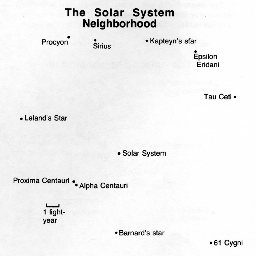 Some of the closer stars are shown in the Solar System Neighborhood sketch [see the graphic to the right]. They are our "next door" neighbors. The nearest ones at about 4 light-years are Alpha Centauri (actually a double star) and Proxima Centauri. Somewhat more distant at 11 or 12 light-years are Epsilon Eridani and Tau Ceti, the two stars Frank Drake observed in his Project Ozma (see page 11 of the January 1979 COSMIC SEARCH [Issue 1]).
Some of the closer stars are shown in the Solar System Neighborhood sketch [see the graphic to the right]. They are our "next door" neighbors. The nearest ones at about 4 light-years are Alpha Centauri (actually a double star) and Proxima Centauri. Somewhat more distant at 11 or 12 light-years are Epsilon Eridani and Tau Ceti, the two stars Frank Drake observed in his Project Ozma (see page 11 of the January 1979 COSMIC SEARCH [Issue 1]).
Although relatively close, the only stars in the sketch bright enough to be seen with the unaided eye are Sirius, Alpha Centauri and Procyon. If the dot for the Solar System represented the size of the orbit of Pluto (outermost planet of the Solar System), it should be one hundred times smaller in diameter (or 10,000 times smaller in area) than shown in order to be on the same scale as the interstellar distances. The star dots are also much too big (by an even larger amount).
The sun is the most powerful light emitter in its near neighborhood with the exception of Sirius (20 times as powerful as the sun), Procyon (7 times) and one of the Alpha Centauri pair which is slightly more powerful than the sun. The rest are weaker, most of them much weaker. Two exceptions are Epsilon Eridani and Tau Ceti (the ones Frank Drake observed) which are roughly one-third as strong as the sun.
A useful way of classifying stars is by their color or spectrum leading to such intriguing names as blue giants, red giants, white dwarfs, red dwarfs and yellow dwarfs (the sun is one). In a future ABCs of SETI we will discuss the spectral classification of stars in more detail and note how it enables us to pick out stars like the sun. We know that the sun has planets, one of which has a technological civilization. Thus, other stars like the sun would be prime candidates for a search for extraterrestrial intelligence. Epsilon Eridani and Tau Ceti are in this category and this influenced Frank Drake to "look" at them first.
Summary:
• Within a dozen light-years (the near Solar System Neighborhood) there are about 20 stars.
• Within 1000 light-years (the far Solar System Neighborhood) there are a million or more stars.
• If all distances were reduced so that the earth were as small as a pea, a planet attached to the nearest star would be like another pea as far as Australia is from New York.
• Interstellar space is mostly empty, in fact more than 99.9999999999 percent empty.
• Two near neighborhood stars at about a dozen light-years are Epsilon Eridani and Tau Ceti (the ones Frank Drake observed in Project Ozma).
• There are many kinds of stars, such as red giants and white dwarfs.
• The sun is a yellow dwarf.
• Note:
One light-year equals the distance light travels in one year (300,000 kilometers times the number of seconds in a year or about 1013 kilometers).
From the SOLAR SYSTEM NEIGHBORHOOD to the GALACTIC NEIGHBORHOOD is a big jump. Distances in the Galactic Neighborhood are measured in millions of light-years whereas in the near Solar System Neighborhood we deal with distances of a few light-years and in the far Solar System Neighborhood distances of perhaps a thousand light-years. Our entire galaxy is 100,000 light-years in diameter (see ABCs of SETI in the January 1979 COSMIC SEARCH).
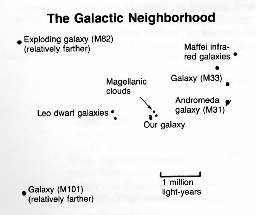 The Galactic Neighborhood sketch [see graphic to the right] is a two-dimensional representation of the vicinity of our galaxy. The dots representing our galaxy and the other galaxies are approximately the proper size relative to the intergalactic distances.
The Galactic Neighborhood sketch [see graphic to the right] is a two-dimensional representation of the vicinity of our galaxy. The dots representing our galaxy and the other galaxies are approximately the proper size relative to the intergalactic distances.
The nearest galaxies to our own are the Magellanic galaxies or Magellanic clouds, appearing as two luminous patches in the southern sky. They are less than one quarter million light-years distant, close enough to be considered as satellite galaxies of our own.
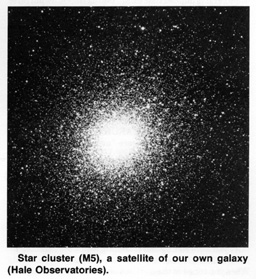 Our galaxy also has other satellites in the form of star clusters [see photo of M5 to the left] which are aggregations of some hundreds of thousands of stars. These are too close to show on the Galactic Neighborhood diagram, being as close as the outer spiral arms of our galaxy. The Magellanic galaxies are about four times as far and are much larger, containing perhaps 1000 million stars.
Our galaxy also has other satellites in the form of star clusters [see photo of M5 to the left] which are aggregations of some hundreds of thousands of stars. These are too close to show on the Galactic Neighborhood diagram, being as close as the outer spiral arms of our galaxy. The Magellanic galaxies are about four times as far and are much larger, containing perhaps 1000 million stars.
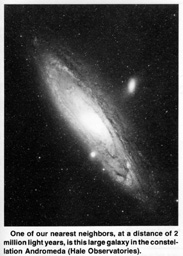 Farther from our galaxy at a distance of nearly one million light-years are several dwarf galaxies in the constellation Leo. Still farther at about two million light-years is the Andromeda galaxy (M31 in Messier's list) [see photo of M31 to the right]. It is the nearest large galaxy and is thought to be similar in many respects to our own, containing several hundred thousand million stars. As shown in the photograph, we view it neither broadside nor edge-on but at an intermediate or slant angle. Even at its great distance it is so large that it covers several degrees of sky. With so many stars and possibly many planets, the chances appear good that there may be at least a few intelligent civilizations in the galaxy but they are so faraway they maybe very difficult to detect. The Andromeda galaxy even has a couple of dwarf satellite galaxies, just to the right and below the central galaxy in the photograph.
Farther from our galaxy at a distance of nearly one million light-years are several dwarf galaxies in the constellation Leo. Still farther at about two million light-years is the Andromeda galaxy (M31 in Messier's list) [see photo of M31 to the right]. It is the nearest large galaxy and is thought to be similar in many respects to our own, containing several hundred thousand million stars. As shown in the photograph, we view it neither broadside nor edge-on but at an intermediate or slant angle. Even at its great distance it is so large that it covers several degrees of sky. With so many stars and possibly many planets, the chances appear good that there may be at least a few intelligent civilizations in the galaxy but they are so faraway they maybe very difficult to detect. The Andromeda galaxy even has a couple of dwarf satellite galaxies, just to the right and below the central galaxy in the photograph.
At about the same distance as the Andromeda galaxy but in a different direction are two galaxies, Maffei 1 and Maffei 2, which emit strongly at infra-red wavelengths, that is, wavelengths longer than light but shorter than radio. [Photos of Maffei 1 and Maffei 2 are not shown in this article.]
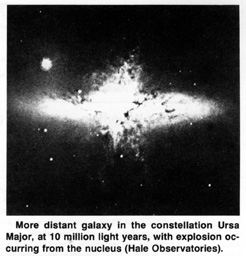
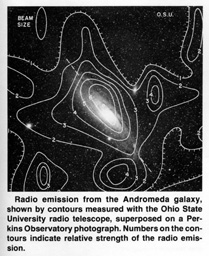
Still farther at 10 million or so light-years are two more large galaxies, M82 [see photo above to the left] photo and M101 [photo not shown] in Messier's list. M82 is unusual in that it appears to be undergoing a great explosion from the nucleus. The Andromeda galaxy (M31) shows no visible signs of such activity but the contours of radio emission from M31 measured with the Ohio State University radio telescope [see photo above to the right] suggest that M31 may have undergone a previous explosive phase which ejected material that emits little or no light but does emit radio waves (note the spikes of radio emission).
There are a number of other galaxies, mostly small, in the galactic neighborhood which we might arbitrarily consider as closer than a dozen million light-years.
Galaxies can be classified morphologically, that is, according to their shape or form. Our own galaxy and the Andromeda galaxy, with their prominent spiral arms, are spiral galaxies. Elliptical galaxies are of symmetrical shape (circular or elliptical) but without spiral arms or evidence of other internal structure. Their appearance may be similar to that of a star cluster but they may contain many more stars. The dwarf satellite galaxies of the Andromeda galaxy are ellipticals. Irregular galaxies are ones which cannot be readily classified as either spiral or elliptical. The Magellanic galaxies are irregulars.
Summary:
• Within a dozen million light-years there are several dozen galaxies. This is the Galactic Neighborhood.
• The nearest large galaxy, similar to our own, is the Andromeda galaxy (M31) which is about two million light-years distant.
• This sister galaxy is about the same diameter as our own (100 000 light-years) and contains about the same number of stars (200 billion).
• Galaxies are classified as spiral, elliptical and irregular and as large or dwarf. Our galaxy and the Andromeda galaxy are large spiral types.
In the January 1979 [Issue 1] ABCs of SETI, we noted that the hydroxyl radical (OH) radiated naturally at 18 centimeters wavelength and hydrogen (H) at 21 centimeters. Combining H and OH we get water (H2O) so the wavelengths between 18 and 21 centimeters are referred to as a "waterhole" even though the H and OH are not chemically combined. The actual combination of H and OH, or water itself, has a natural wavelength (or "line") at about 1.4 centimeters (14 millimeters). Thus, wavelengths near 1.4 centimeters may be regarded as another "waterhole" and some consider it to be the real waterhole. Water also has a natural wavelength at about 2 millimeters so wavelengths near this might be considered as a third waterhole.
A number of searches for extraterrestrial intelligence have been made at the second waterhole. The rationale is that if water is as important to alien societies as to ours then "They" might choose to signal at wavelengths in this region. Or they might select wavelengths in this region for the simple reason that the sky background noise is low provided observations are made in space (above the atmospheres of planets).
Summary:
• The second "waterhole" is at wavelengths near 1.4 centimeters, the natural wavelength of actual water.
• The first "waterhole" lies at wavelengths between 18 and 21 centimeters.
• SETI searches have been made in both "waterholes".
Notes:
• First waterhole wavelengths:
18.3 centimeters (1638 megahertz)
21.1 centimeters (1420 megahertz)
• Second waterhole wavelength:
13.5 millimeters (22.2 gigahertz)
• Third waterhole wavelength:
2 millimeters (150 gigahertz)
The question is often asked: Are we unique or are we average? It is implied that we are taking the entire universe as our reference.
No one knows the answer, but suppose we say that we are "average", what does this mean? It implies that life and civilizations are commonplace and that we are just one among many civilizations. Like the "E Pluribus Unum" stamped on U.S. coins, we are "one of many". And if we are one of many, the most reasonable guess is that we are average, that is, we are neither very advanced nor very primitive but somewhere in between. However, we have no idea how right or wrong this guess may be (see Sebastian von Hoerner's comments on this point on page 40 of the January 1979 [Issue 1] COSMIC SEARCH).
Now suppose we say we are "unique", what does this imply? It suggests that we really are alone, not only in our own galaxy but in the entire universe. We are a true cosmic curiosity, a miniscule oasis, a tiny speck in a vast universe where matter has evolved to the point where it can contemplate itself and the universe which spawned it. Part of the fascination of SETI is that it may provide the clue which can tell us whether we are indeed unique or merely average.
Summary:
• If life abounds in the universe then we are most likely "average".
• If life exists nowhere else in the universe then we are "unique".
• SETI may be able to tell us which we are.
Did you ever turn your radio on at 3 A.M. when only a few stations were to be heard? As you tuned the receiver searching for a station, you heard a hissing noise, like escaping steam, all across the band until you tuned in a station and the noise gave way to speech or music.
As you were tuning and searching, you were listening to BROADBAND noise. It was the same anywhere you tuned. When you tuned in the station, you were then listening to a NARROWBAND signal carrying information or "intelligence". You only heard this station when you were tuned to its specific wavelength.
Why does a broadcast station transmit a narrowband instead of a broadband signal? Because it can be heard farther and more clearly if it concentrates its power in a narrow band of wavelengths instead of spreading it out over many wavelengths.
Before World War I, in the early days of radio (it was called "wireless" then), high voltage spark discharges were used for transmitting code signals but even with high power the stations couldn't transmit far because the spark generated a broadband signal (which could be heard all across the dial). After World War I, when vacuum tube transmitters came into general use, it was possible to generate much narrower band signals which could be heard only at one spot on the receiver dial. These signals carried much farther and spark transmitters soon became obsolete.
What does all this have to do with SETI? Simply that for a given power, a narrowband signal carries farther and an extraterrestrial technological civilization would, no doubt, use a narrowband signal for its beacon transmissions. It might even make it so narrow that it couldn't even carry speech or music but only the slow dots and dashes of a cosmic Morse code because this could go still farther. It makes more sense (if you want to be found) to send Morse code signals very slowly (carrying but little information) rather than a voice signal (with more information) which is never heard by anyone. (A television signal is even broader band than speech and would have still less range).
Now we understand why most searches for extraterrestrial intelligence are done with very narrowband receivers. Since, however, the particular wavelength an extraterrestrial society might use is uncertain, many narrow bands or channels are usually searched simultaneously. The channels could be searched one at a time but this would take much longer. The multi-channel SETI receiver is analogous to a TV receiver equipped with a hundred picture tubes for monitoring a hundred channels simultaneously in the hope that someday on one channel the long-sought-for picture might appear.
Summary:
• A "broadband" signal is like noise which extends across the entire receiver dial.
• A "narrowband" signal is like that from a radio station which is heard in just one place on the receiver dial.
• Narrowband signals can travel further than broadband signals (for a given power).
• To achieve maximum range, an extraterrestrial civilization would likely employ a narrowband signal.
• Most searches for extraterrestrial intelligent signals are done with receivers having many narrowband channels.
• Note:
Even at a slow sending rate of dots and dashes, it is possible to send pictures, as in a wire-photo, but it might take a long time, measured in days, to send just one picture over interstellar distances. Ordinary television pictures (at a rate of many pictures per second) are also sent with dots and dashes but they must be sent at a very high rate (millions per second) and this requires a broader bandwidth. Thus, for a given power, a slow rate of sending information (slow Morse code) is appropriate if you want your signals to go as far as possible whereas a high rate of sending information or data will reduce the distance at which your signals can be detected. Whether the dots and dashes are sent at a slow or fast rate, the waves carrying them always travel through empty space at the same velocity of 300,000 kilometers per second.
In future issues of COSMIC SEARCH many other facets of SETI will be discussed. Books for further reading are listed in "Off the Shelf", a regular feature of COSMIC SEARCH.
|
|
In Review:
By: John Kraus and Mirjana Gearhart
[Article in magazine started on page 47]
In a deeply perceptive article, "Fitness in the Universe: Choices and Necessities"*, philosopher-scientist and Nobel laureate George Wald of Harvard sees the remarkable in the commonplace. "We tend to take too much for granted" says Wald, "particularly when it is so fundamental that it surrounds us." In a cosmos of change where anything can happen but only some things persist, Wald asks the question, "Why?" Thus, he points out that if the proton did not have so much greater mass than the electron, all matter would be fluid and if the proton did not have exactly the same but opposite charge as the electron (or some simple multiple of it) all matter would be charged, and the universe as we know it would not exist: everything would tend to fly apart — no stars, no galaxies, no life.
It is remarkable too, he notes, that the same four elements, hydrogen, carbon, nitrogen and oxygen, play equally important roles in the vital functioning of a great star as in the metabolism of a small living organism. Further, both the star and the organism are coupled by the radiation from the star which provides the energy on which the organism depends.
Wald calls water (made of two of these elements: hydrogen and oxygen) "the strangest molecule in all chemistry." In its frozen form it floats and, he says, "if ice did not float — and hydrogen sulphide and ammonia ices do not float — it is highly unlikely that life could arise or long survive" because ice's floatability allows the bulk of liquid water to remain below it rather than freezing solidly during long cold spells.
Evolution of living organisms on the earth has led them to certain carbon molecules for the performance of certain functions as the chlorophylls for photosynthesis and carotenoids for vision. Learning about how life evolved on the earth, Wald says, must tell us something about how it might arise elsewhere.
Under the heading of individuality he notes that although every molecule of a substance is identical, no two living organisms are or ever have been identical. "Each living organism is unique, different from every other, different even from itself from moment to moment."
Back to electrons and protons he asks if their properties are accidental; for although "one could tinker" a bit with their difference in mass without changing things very much, the exact equality of their charge is an extreme limitation. "Only precise equality would seem to yield the universe we
know. So — as we see it — this may be the best way to build a universe. What I want to know is: How did the universe find that out? How could it have arrived at those properties in its
elementary particles without trials? — and what could have been the nature of those trials?"
Did the principle of natural selection which guides the development of living organisms, asks Wald, also have a hand in determining the properties of protons and electrons? "It is a possibility worth considering," he concludes, "that God is a mathematical physicist."
— John Kraus
*In "Origins of Life", Reidel, Dortrecht-Holland, 1974, edited by Cyril Ponnamperuma.
Sylvia Engdahl writes in a clear, simple, easily-understood manner that should appeal to readers of all ages. In "The Planet-Girded Suns" she has produced an interesting, well-researched history of the idea that extraterrestrial life exists. She notes that the idea of other solar systems supporting life is not a new one. For expressing such ideas, Giordano Bruno was burned at the stake as a heretic in Rome in 1600. Almost 100 years later, as Engdahl relates, Christian Huygens published the first full-length scientific treatise on the subject. Huygens, a Dutch astronomer and physicist, wrote "The Celestial Worlds Discover'd" and was one of the first to realize how insignificant earthly problems could become when viewed with a more cosmic perspective.
Engdahl notes that by the 18th century, belief in extraterrestrial life was not just the fad of a few — the belief became basic and endured relatively unchanged for almost a century. But there were doubters, such as William Whewell, Master at Cambridge's Trinity College. In his "On the Plurality of Worlds" published in 1853, he contended that there might not even be other planets orbiting other solar systems, let alone life on those planets.
"The Planet-Girded Suns" is an interesting mixture of history and literature. Quotations are given from many poets, from Milton to Tennyson, who have turned their pens to the heavens, speculating both on the grandeur of the universe and whether man-like creatures inhabit other worlds.
By carefully reconstructing her story from voluminous notes on many writers, both well-known and obscure, Engdahl has given vitality and dimension to the idea of extraterrestrial intelligence at a time when it is gaining renewed acceptance as both a great scientific endeavor as well as a great philosophical question.
"The Planet-Girded Suns" is entertaining and informative, providing a background for today's interpretations of an idea that has been around since the early Greeks and will be around to tantalize man for a long time.
Mirjana Gearhart
*1974, Atheneum, New York.
If extraterrestriaIs ever happen onto the Voyager records, we may likely receive a three word message: "SEND MORE BACH!"
|
|
Man's Role in the Galaxy
By: R. N. Bracewell
[Article in magazine started on page 48]
Years ago when authors needed a habitat for extraterrestrial aliens they could always call on Venus or Mars and in even earlier times the moon was a favorite base. H. G. Wells, Andre' Maurois, Jules Verne and Baron von Munchausen all contemplated inhabitants of the moon but now that the moon has in reality been visited and many of the planets have been photographed at close quarters it is a little embarrassing these days to pretend that there are people there. Consequently more recent fiction, Star Trek and Star Wars for example, have drawn on planets outside the solar system as the stage for interaction between our spacemen and alien societies.
"The discovery of the first non-solar planet would be a milestone in astronomy."
So graphic are some of these stories that we tend to forget that there is no scientific evidence for the existence of any planets other than the nine known to belong to our solar system. It may be plausible to assume that our solar system is just average and merely one of innumerable others rather like it, but in fact we do not know. The discovery of the first non-solar planet would be a milestone in astronomy and would undoubtedly engender great interest in the particular star found to have the planet. It would certainly make a difference to our outlook on the idea of searching for intelligent life by microwave radio receiving antennas. Instead of having to search the whole sky and share observing time over many stars we could focus on the candidate star. A strong incentive would come into existence for the construction of an adequate microwave listening system; and a variety of other means could be employed to find out more about the candidate star.
I have in mind telescopes specially designed for much higher angular resolution than is customary for current astrophysical research. One approach would be to improve astrometry, the classical technique by which the dark companion of Sirius was detected. The idea is to accumulate photographs of a star, together with its surround of background stars, over a period of months or years. If the star is a double star, then the two will circle about their mutual center of gravity. But if one of the pair is invisible, then the
visible one will exhibit sinuous departures from its regular position as measured with respect to the frame of reference determined by the background stars. Of course, if the invisible companion is only a planet, then the amount by which the star wobbles is rather small and new instrumental developments will be called for. Another approach would be to work in the infrared where the planet's own heat radiation would be sought instead of just the reflected light. This approach would require a space mission in order to reduce
the heat radiation from the earth's own atmosphere and from the interplanetary dust that pollutes the earth's orbit.
Even if other planets were found in the galaxy the existence there of life comparable to human life would still be a moot question. It certainly would not follow hat because there are other planets there will be other beings with the understanding of the control over nature that man possesses. Indeed we may go further and say that life on earth, life of any kind, is the only life for which we have evidence. As far as we know today there may be no other life in the whole of the galaxy. The proposition that earthly life is the only life can never be proved true (in view of the vastness of the galaxy and the impossibility of inspecting all the sites). However, the proposition is subject to disproof, it would be disproved at the moment of discovery of life elsewhere. It is a general characteristic of good scientific theories that they are vulnerable, or subject to experimental disproof; theories that cannot be tested or can be tested only with extreme difficulty, are of little use to current progress in science. Now, it may take some effort to discover other life, but instead of sitting idly speculating and expressing opinions pro and contra we should be demanding action to look for life. The sort of action I have in mind is the construction of special instruments to look for planets as described above or searching for radio signals that may be arriving from extraterrestrial civilizations or certain other astronomical observations that might turn out to be related to the occurrence of living communities. In addition, it is practically certain that action-oriented thinking would produce new initiatives that have not been thought of yet. I strongly favor action in this field.
Meanwhile, is there anything we can say that might have a bearing on the possible uniqueness of life as we
know it on earth? It is often argued that our sun is an average star, that it is situated in an inconspicuous place neither in the middle of nor on the edge of the galaxy, that the earth is not the center of the universe as Ptolemy supposed and that the Mediterranean is not the center of the world as the Romans evidently thought. In fact it is pointed out that whenever man has assumed that he occupies a privileged position he has been demoted to a humbler position as knowledge has expanded. Therefore, it is
said, it would be wrong to assume that we are unique in being the only life in the galaxy. As Gus Arriola's comic strip character Porfirio put it, "Panchito! It'd be gross conceit to imagine that in all those awesome endless galaxies we are the only worms!"
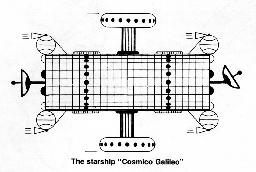
Whether it would be conceit or not, it would be an assumption. The danger in reasoning from such a position is evident when we apply the averageness argument to intelligent life on the earth. Would it be a gross conceit to suppose that in all the hundreds of thousands of living animal species populating the planet earth that we are the most intelligent species? Apparently not, seeing that we really are a unique species on earth. Why then should we not be unique in the galaxy?
"Whenever man has assumed that he occupies a privileged position, he has been demoted to a humbler position as knowledge has expanded."
Not only are we unique on earth but we are unique in the solar system. Now here is an interesting line of thought. Some many years ago there were no intelligent humans on the North American continent but there were intelligent humans in Africa. It seems that apes already endowed with special abilities as regards hand, eye and brain descended from the trees and spread over the African savannah, growing in intelligence as they engaged in group hunting. They developed tools and weapons and came ultimately to derive more advantage from language and transmitted instruction than from continued bodily evolution.
Why shouldn't an intelligent bear have emerged from the North American forest onto the prairie and developed along similar lines? Perhaps given time, this might have occurred. It could never happen now because even minor threats from predators are handled very sternly by human settlers; witness the virtual disappearance of the wolf and grizzly bear. But in the days before man reached North America why should not an intelligent rival to man have developed from some bearlike or raccoonlike ancestor? There have been many cases of convergent evolution on separate continents; examples would be the marsupial cats and the Tasmanian tiger which in Australia evolved to fill niches occupied by wild cats and dogs in Asia. Very similar creatures developed from quite dissimilar ancestors.
The reason that no intelligent species arose on the American prairies or the Siberian steppes or the South
American pampas is a simple one. In the time needed for such evolution to take place, tens to hundreds of millions of years, the early models of primitive man originating in Africa were able to walk all over the earth, except for Antarctica, and preempt further natural evolution of independent intelligent species elsewhere.
From Africa to America may be a long walk and the going was undoubtedly rough but I should think that 10,000 years would suffice. Under the influence of population pressure gradient family groups would migrate outward sometimes imperceptibly, sometimes on longer marches and an average speed of one mile per year does not seem unreasonable. Thus, although no conscious intention existed to cover long distances, nevertheless, that is what happened. The persons arriving at the ultimate destinations were not the same persons that set out and they never returned to their original homeland. In fact they completely lost memory of their origins. We need only recall that when the great European voyages of discovery began in the fifteenth century the scattered races of man began to gain mutual awareness of their existence over the whole of the earth for the first time.
We are accustomed to speak of the earth as inhabited by humans but of course most of it is inhabited courtesy of remarkable developments in Africa which, at one time, was the only habitat of man. We regard Antarctica as inhabited by man because the numerous permanent expeditions on that icy continent maintain a steady population in the hundreds. But it is hard to think that intelligent life might ever have evolved there independently. Now before many decades pass there will be expeditions on the moon and Mars and there will be interplanetary space colonies and we will be accustomed to saying that the solar system is inhabited, and indeed it will be, but not because life originated or could have originated there, given time, but because life got there by migration (just as it has migrated all over the earth) long before evolution received a chance to try a new and independent tack.
I am leading up to my interesting idea. After we have explored the solar system, or even before that exploration is completed, it will become technically feasible to send probes to nearby stars and in time to send expeditions. I am not thinking necessarily of round-trip expeditions where those setting out from home also return home but of something more akin to migration. Underthese conditions speed is not of the essence and thus many of the scientific objections to space travel that have been voiced by prominent physicists do not apply. It is not necessary to travel at speeds approaching the speed of light if you are not planning to come back; consequently great feats of rocketry are not required.
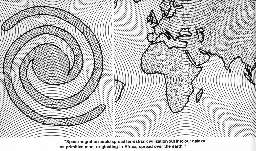
It is not clear to me what force will impel the migrants to travel. We can hardly draw a parallel with our hunting and gathering ancestors whose movements may have been controlled largely by food supply. But conceivably forces of political and religious persecution, which have caused substantial migration in the past, could become factors. Population pressure is sometimes mentioned. In any case, when the possibility comes to exist, will not some group at some time seize it?
In time, space migration could spread terrestrial civilization out into our galaxy. Now the key question here is, how long will this take by comparison with the characteristic time for independent evolution?
The factual piece of information we have about evolution is that it took about 5 billion years for man to appear on earth following the formation of the earth. If conditions had been more favorable in some way it might have taken less time, perhaps one billion years. Certainly if conditions had been less favorable it could have taken much longer as we see from the examples of Venus, Mars and the moon.
If man can migrate into neighboring galactic space in noticeably less than a billion years, then he will undercut independent evolution just as he has already done in the non-African continents, and the solar system. Whatever stage life may have reached in the favorable habitats that our spacefaring descendants discover, continued natural evolution there will be hampered by man's arrival.
If, on the other hand, a billion years is to elapse before we significantly penetrate the galaxy, then we must entertain the likelihood that a certain fraction of the (as yet unknown number of) suitable planets may have intelligent life. So let us quickly do the calculation. Just as we do not know whether the migrants from Africa to America averaged one mile per year, or ten times more or ten times less, so we also do not know with what velocity we might migrate into space. However, to gain a feeling for the numerical magnitudes involved let us adopt one percent of the speed of light as an average speed, that is 3000 kilometers per second. This speed, while high, is rather modest by fictional space travel standards. For example, at this rate it would take 450 years merely to reach the nearest stars (in the Alpha Centauri system). Now the galaxy is immense and it might be considered a significant penetration of the galaxy if we were to reach say the closest thousand stars. But as a galactic yardstick I am going to adopt 30,000 light years, which is the distance from here to the center of the galaxy.
At one percent of the speed of light that distance would take 3,000,000 years. Thus the calculation comes out resoundingly in favor of migration as a means of civilizing the galaxy rather than independent evolution. In other words, confronted with the problem of endowing the galaxy with intelligent life, a master planner's best strategy would be to do a good job in one place and let the intelligent life spread out from there.
Are there weak points in this reasoning? Well, the average speed of space travel, though modest, is necessarily conjectural. Still, even if the assumed speed is reduced ten or one hundred times the conclusion is unchanged. On the other hand, who knows what higher speeds might not be achievable by our descendants in the course of time. We are discussing events that will be spread over the next million years or so of the history of the human race.
Another feature to consider is that there are many other stars that have been around as long as or longer than our sun and since intelligent life arose here we cannot absolutely exclude current intelligent life elsewhere. There may very well be some and we should take the possibility into account even though it can reasonably be pointed out that America was around as long as Africa and Mars was around as long as the earth. Furthermore, it remains to be shown that those other stars have planets. Even so, other intelligent life cannot be ruled out merely by reasoning. If such intelligencces exist, then my idea applies to them too. They also may become centers of expanding spheres of migration and for all we know may already have begun to expand. There has been plenty of opportunity.
"How you and I, trifling subsets of the atoms of the universe, can be conscious of the whole is a mystery."
The universe dates back about 15 billion years to the Big Bang. Star formation began almost immediately and generations of stars have been born and have lived out their lives since then. The first generation of stars is not likely to have provided life niches, certainly no rocky planets with oceans, because in the beginning there was only hydrogen and some helium. Oxygen, which is needed for water, did not exist at that time but was manufactured in the interiors of those first stars. It is interesting to contemplate the human body, the vehicle of the intelligent life that we are discussing, and to note that most of it is water—hydrogen and oxygen. Numerically, the majority of the atoms in our bodies are the selfsame hydrogen atoms that took part in the Big Bang and have come down to our times unchanged since then. The atoms constituting the majority of the mass of our bodies are oxygen atoms whose history is quite different. They originated in nuclear reactions inside stars at immense pressures and temperatures, were later expelled explosively as the star burned out, and became a trace constituent of the interstellar matter from which second generation stars condensed. The same story holds for the carbon atoms whose unique and rich chemistry is the basis of all known life. Thus, in ourselves, we are profoundly cosmical creatures who are now discussing the conscious redistribution of ourselves back into galactic space.
By cosmological standards, the million years or so that would suffice to penetrate the galaxy by space travel is a mere instant. An outside observer who had inspected our galaxy thousands of times at regular intervals since its birth would find intelligent life all over the galaxy on one of his inspections whereas there had been only isolated pockets on his previous inspection. It is hard to believe that intelligent life has already flashed through our galaxy for no signs of it have been detected. Therefore, I am inclined to think that favorable conditions for development of intelligent life are not abundant, suitable planets are not common, and that man may indeed be unique or quasi-unique. The only way to find out is to do something, such as searching for nonsolar planets; speculation will not tell us.
Still, the prospect of man's uniqueness certainly has an impact on man's view of himself. Instead of seeing ourselves as a rather ordinary byproduct of stellar evolution, whose accidental demise would have very little impact on the galaxy as a whole, we are presented with a broader vision of a remarkable destiny to transmit consciousness through the galaxy. The fragility of such a cosmic plan, if I may so describe it, is extreme; yet despite many setbacks life on earth did rise to the point where inanimate atoms, mere products of a lifeless universe, bundled together and staring up into the sky, could begin to ask questions about
and even dimly to understand the universe. How you and I, trifling subsets of the atoms of the universe, can be conscious of the whole is a mystery. Although we are indeed mere byproducts of natural universal laws governing stars, galaxies and the whole universe, we are already beginning to influence the course of natural events on earth. It may be man's noble role, as I am suggesting here, to spread this new phenomenon of consciousness through the galaxy.
The text of this article first appeared in "Isaac Asimov's Science Fiction Magazine" (reproduced by permission). The drawings with this article are by Su Ark of COSMIC SEARCH © 1979.
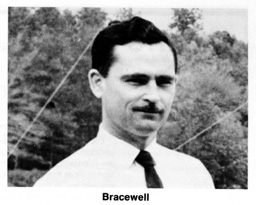 Ronald N. Bracewell has served nearly a quarter century on the faculty of Stanford University where is now the Lewis M. Terman Professor and Fellow in Electrical Engineering and Director of the Radio Astronomy Observatory. Born in Australia in 1921, he received his bacheor's degree from Sydney University in 1941 and his doctor's degree from Cambridge University, England, in 1950. Coming to the United States in 1954 he joined Stanford the following year.
Ronald N. Bracewell has served nearly a quarter century on the faculty of Stanford University where is now the Lewis M. Terman Professor and Fellow in Electrical Engineering and Director of the Radio Astronomy Observatory. Born in Australia in 1921, he received his bacheor's degree from Sydney University in 1941 and his doctor's degree from Cambridge University, England, in 1950. Coming to the United States in 1954 he joined Stanford the following year.
His important contributions to the theory of radio telescope antennas have resulted in numerous scientific articles. He has written books: "Radio Astronomy" with J. L. Pawsey (Oxford, 1955), "The Fourier Transform and Its Applications" (McGraw-Hill, 1965) and "The Galactic Club: Intelligent Life in Outer Space" (Freeman, 1974). Bracewell has been a leader in discussions of extraterrestrial intelligence and methods of its detection, originating the concept of using robot probes for the exploration of the interstellar neighborhood. His broad interests include the study and cataloging of the trees and rare plants of the Stanford area. Bracewell is a member of the Editorial Board of COSMIC SEARCH.
|
"The greatest discoveries are yet to come." John Archibald Wheeler in the American Scientist.
|
|
Off the Shelf
By: Mirjana Gearhart
[Article in magazine started on page 52]
The literature of SETI is extensive. In this and future issues of COSMIC SEARCH selected books and other publications are listed with pertinent information. Space prevents the inclusion of more than a small number in each issue. We believe you will find in these references much that will add to your knowledge and understanding while imparting something of the adventure and excitement of SETI.
Richard Berendzen, ed., LIFE BEYOND THE EARTH AND THE MIND OF MAN, 1973, NASA Publication, SP-328, U.S. Government Printing Office. (106 pg., paperbound). A theologian, an astronomer, a physicist, a biologist and an anthropologist discuss some of the complex implications of contacting extraterrestrial intelligences.
Stephen H. Dole, HABITABLE PLANETS FOR MAN, 1970, American Elsevier Publishing Co., New York, N.Y. (158 pg., hardbound). A book concerned with destinations-how man might find other habitable planets. The author describes the future expansion of human colonies to other planets, with the population on them exceeding the population of the earth.
Sylvia Louise Engdahl, THE PLANET-GIRDED SUNS, 1974, Atheneum, New York, N.Y. (192 pg., hardbound). A history of man's view of other solar systems and other life from Giordano Bruno, who was burned at the stake in 1600, to modern man's concepts.
William K. Hartman, MOON AND PLANETS: AN INTRODUCTION TO PLANETARY SCIENCE, 1972, Wadsworth Publishing Co., Belmont, Cal. (392 pg., hardbound). Theories of the origin of the solar system, growth of planets, planetary surfaces, habitable planets and the nature of life are discussed.
Stanley L. Jaki, PLANETS AND PLANETARIANS: A HISTORY OF THEORIES OF THE ORIGIN OF PLANETARY SYSTEMS, 1978, Halsted Press, Somerset, N.J. (257 pg., hardbound). The first documented account of the history of theories of the planets, with special emphasis on extraterrestrial intelligence.
S. A. Kaplan, ed., EXTRATERRESTRIAL CIVILIZATIONS, 1971, NASA Technical Translation, No. TTF-631 (265 pg., paperbound). Problems of interstellar communication. A collection of Soviet papers translated into English.
John W. McVey, WHISPERS FROM SPACE, 1973, MacMillan Co., New York, N.Y. (250 pg., hardbound). Project Ozma and the techniques for searching for extraterrestrial life are highlighted.
Roy Miller, SPACE ART, 1978, O'Quinn Studios, New York, N.Y. (192 pg., paperbound). A comprehensive collection of photographs of the space art of Bonestell, McCall, Pesek, Rudaux and other well-known artists.
Gerard K. O'Neill, THE HIGH FRONTIER: HUMAN COLONIES IN SPACE, 1977, William Morrow and Co., New York, N.Y. (275 pg., hardbound). The author discusses in detail some of the problems and implications of space colonization.
Michael W. Ovenden, LIFE IN THE UNIVERSE, A SPECIFIC DISCUSSION, 1962, Doubleday Anchor Books, Garden City, N.J. (149 pg., paperbound). A book about the solar system, the evolution of life on earth, the adaptability of life and its possible existence on other planets.
Richard A. Proctor, OTHER WORLDS THAN OURS, 1897, D. Appleton and Co., New York, N.Y. (134 pg., hardbound). A book that puts SETI in historical perspective by an author writing at the turn of the century. Ideas about life on other planets and the possibility of life on Mars were sure-fire topics to interest readers in 1897.
Martin H. Sable, EXOBIOLOGY: A RESEARCH GUIDE, 1978, Green Oak Press, Brighton, Mich. (324 pg., hardbound). A compilation of some 3400 entries dealing with the many aspects of exobiological research.
Carl Sagan, THE DRAGONS OF EDEN: SPECULATIONS ON THE EVOLUTION OF HUMAN INTELLIGENCE, 1977, Random House, New York, N.Y. (263 pg., hardbound). Speculations on the evolution of human intelligence culminating in search for extraterrestrial intelligence.
Carl Sagan and others, MURMURS OF EARTH, 1978, Random House, New York, N.Y. (273 pg., hardbound). The intriguing story of how the Voyager records were made. The records, launched on August 20 and September 5, 1977, aboard the Voyagers, contain 118 photographs of earth, 90 minutes of the world's greatest music, an evolutionary essay and greetings in almost 60 human languages and one whale language.
P. H. A. Sneath, PLANETS AND LIFE, 1970, Minerva Press, New York, N.Y. (204 pg., paperbound). A discussion of our knowledge of the structure of the universe and of conditions essential to life.
Steven Weinberg, THE FIRST THREE MINUTES: A MODERN VIEW OF THE ORIGIN OF THE UNIVERSE, 1978, Basic Books, New York, N.Y. (180 pg., hardbound). A fascinating story, containing unique stop-action frames of the first three minutes of the formation of the universe.
|
Miscellaneous Items
Webpage Table of Contents (Bookmarks)
(Internal links to categories of items in this webpage)
Information About the Publication
(Editorial Board, Editors, Table of Contents)

ISSN 0161-8555
CODEN: COSEDN
Editorial Board
- Richard Berendzen, University Provost, The American University
- John Billingham, Director SETI Program, NASA-AMES Research Center
- Ronald Bracewell, Director, Radio Astronomy Observatory, Stanford University
- Thomas A. Clark, NASA-Goddard Space Flight Center
- Arthur C. Clarke, Sri Lanka, author of "2001, A Space Odyssey"
- Norman Cousins, Chairman, Editorial Board, SATURDAY REVIEW
- Frank D. Drake, Director, National Astronomy and Ionosphere Center (Arecibo), Cornell University
- Robert E. Edelson, SETI Project Manager, Jet Propulsion Laboratory, California Institue of Technology
- Donald S. Hall, Director, Strasenburgh Planetarium, Rochester, New York; President, International Planetarium Society
- Theodore M. Hesburgh, President, University of Notre Dame
- Nikolai Kardashev, Space Research Institute, Academy of Sciences, Moscow, USSR
- Philip Morrison, Physics Department, Massachusetts Institute of Technology
- Bernard Oliver, Vice President, Hewlett-Packard Company; Director of NASA-Ames Cyclops Project
- Cyril Ponnamperuma, Director, Laboratory of Chemical Evolution, University of Maryland
- Martin Rees, Director, Institute of Astronomy, Cambridge University, England
- Carl Sagan, Director, Laboratory for Planetary Studies, Cornell University
- Walter Sullivan, Science Editor, New York Times
- V. S. Troitsky, Radiophysical Scientific Research Institute, Gorky, USSR
- Sebastian von Hoerner, National Radio Astronomy Observatory
Editors, and Others Involved in the Publication
Editors: Robert S. Dixon and John Kraus, Ohio State University Radio Observatory
Managing Editor: Mirjana Gearhart, Ohio State University Radio Observatory
Subscription Manager: Janet Stevens
Business Manager: Sylvia Raub
Controller: Lesly Arnold
Assistants: Richard Arnold, Gregory Brown, Ann Cole, Pene Curmode, Jerry R. Ehman, Wendy McKenna, David Raub, Hazel Snyder
The Cover
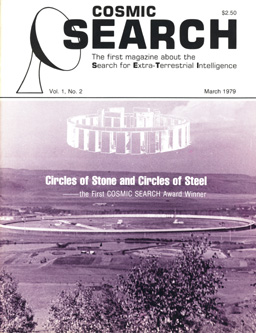
The Cover: Stonehenge and the RATAN-600. The drawing of Stonehenge (restored) was made about 1625 by Inigo Jones. The RATAN-600 is the world's largest continuous-surface radio telescope. The area of four Arecibo dishes would fit inside this Kraus-type telescope. Located near Zelenchukskaya, U.S.S.R., it will be used in searches for extraterrestrial intelligence.
About COSMIC SEARCH
COSMIC SEARCH is published 6 times a year by Cosmic-Quest, Inc. Copyright © 1979 by Cosmic-Quest, Inc. All rights reserved.
Cosmic Quest, Inc., is a private non-profit organization dedicated to the promotion and support of SETI endeavors.
Subscription price: $12 a year in U.S. (and possessions), $16 elsewhere. Single copies: $2.50 in U.S. (and possessions), $3 elsewhere.
Address subscriptions and all other correspondence to: Radio Observatory, Box 293, Delaware, Ohio 43015.
Application to mail at second-class postage rates is pending at Delaware, Ohio, and at additional mailing offices.
Table of Contents (in magazine)
| Item | Pg |
|---|
| The Quest for Extraterrestrial Intelligence by Carl Sagan | 2 |
|---|
| Circles of Stone and Circles of Steel by Don Lago | 10 |
|---|
| Space Colonization and SETI — An exclusive interview with Gerard K. O'Neill | 16 |
|---|
| The Case for SETI by Richard Berendzen | 25 |
|---|
| Generalized Life by Jerome Rothstein | 35 |
|---|
| Man's Role in the Galaxy by R. N. Bracewell | 48 |
|---|
| Features | |
|---|
| Glossary | Inside Front Cover |
|---|
| Letters | 9 |
|---|
| Next Issues | 14 |
|---|
| Editorial by Bernard Oliver | 15 |
|---|
| Fable | 24 |
|---|
| The SenTInel (SETI News) | 30 |
|---|
| Puzzle | 34 |
|---|
| ABCs of SETI | 39 |
|---|
| In Review | 47 |
|---|
| Off the Shelf | 52 |
|---|
Purpose of COSMIC SEARCH
The purpose of COSMIC SEARCH is to present all aspects of the search for intelligent life in space in a popular but responsible manner.
Coming in COSMIC SEARCH
- "The Possibilities of SETI from Space" by Roy Basler
- "Neutrinos for Interstellar Communication" by Jay Pasachoff and Marc Kutner
- "Interstellar Communication with Gravity Waves" by David Douglass
- "Cosmic Languages" by Hans Freudenthal
- "A Hymn to Life in the Universe" by Don Lago
- "Strategies of Searching for Extraterrestrial Civilizations" by Nikolai Kardashev
- "Extraterrestrial Life: Where is Everybody?" by Jesco von Puttkamer
- "Minds and Millennia" by Michael Arbib
- "Bio-Cosmology: A New NASA Thrust" by Bernard Oliver
- "Extraterrestrial Politics" by Michael Michaud
- "We Wait and Wonder" by John Kraus
- FORUM:
- Interview with scientist-philosopher John Archibald Wheeler on "Science, Art and the Universe"
- Interview with NASA's SETI Director John Billingham on "SETI"
- ABCs of SETI will explain in simple terms:
- Stars (They are not all alike. Spectra and the sun-like stars)
- SETI Wavelengths (The hydrogen line, the "waterholes," the Drake-Helou line, the Kuiper-Morris line, the Kardashev lines. Which one is best?)
- Doppler shifts (Wavelengths are relative. The red shift)
- Three degrees (The Big Bang Background)
- Radio Telescopes (What do they hear?)
- Range and Size (How far can a telescope reach?)
- More SEnTlnel news reports, "Off the Shelf" books and other special features.
Cosmic Calendar
| 15 billion BC | Universe began (BIG BANG) |
| 10 billion BC | Our galaxy formed |
| 5 billion BC | Solar system (sun, earth and other planets) formed |
| 2 million BC | Homo sapiens emerged |
| 5000 BC | Writing invented |
| 1888 AD | Hertz produced radio waves |
| 1903 AD | Letter "S" sent by radio waves across Atlantic Ocean by Marconi |
| 1959 AD | Cocconi and Morrison proposed SETI |
| 1960 AD | First attempt to detect extraterrestrial civilizations by Drake |
| 1979 AD | First issue of COSMIC SEARCH |
Distance Table
Distances in light travel time (approx.)
| Earth to moon | 1 second |
| Earth to sun | 500 seconds (8 min.) |
| Sun to Mars | 12.5 minutes |
| Sun to Jupiter | 40 minutes |
| Sun to Pluto | 5.5 hours |
| Solar system diameter (at orbit of Pluto) | 11 hours |
| Sun to nearest star | 4 years |
| Sun to center of galaxy | 30,000 years |
| Diameter of galaxy | 100,000 years |
| Distance of Andromeda galaxy | 2 million years |
| Distance to "edge" of universe | 15 billion years |
To convert light travel time to kilometers multiply travel time in seconds by velocity of light (300,000 kilometers per second).
Glossary
- Anthropocentric:
- Man-centered.
- Astronomical Unit:
- A unit of length equal to the distance of the earth from the sun, about 150 million kilometers.
- Bandwidth:
- The wavelength or frequency range to which a receiver responds. Bandwidths can be described as narrow or wide, according to their range.
- Big Bang:
- The beginning event in the Universe. The explosion of this primordial fireball some 15 billion years ago caused the initial outward expansion of gas and dust which formed the universe. CETI: An acronym for Communication with Extra-Terrestrial Intelligence.
- Blackbody radiation:
- Hypothetically radiation which is perfect; that is, all incident radiation is absorbed and re-emitted.
- CETI:
- An acronym for Communication with Extra-Terrestrial Intelligence.
- Doppler Shift:
- The resulting frequency change caused by the relative motion along a line of sight between two observers.
- Dyson Sphere:
- Shells built around stars by advanced civilizations. These objects are hypothesized by Princeton astronomer Freeman Dyson. These spheres might be detected by our astronomies as infrared sources.
- Exobiology:
- The study of extraterrestrial life forms.
- Galaxy:
- A large system of stars. Our galaxy, the Milky Way, is a spiral galaxy containing some 100,000 million stars, 100,000 light years in diameter and 10,000 light years thick.
- Gigahertz:
- A unit of frequency equal to 1,000 million hertz.
- Hertz:
- A unit of frequency equal to one cycle per second.
- Hydrogen:
- The most abundant element in the universe. It radiates naturally at a wavelength of 21 centimeters.
- Infrared radiation:
- Radiation whose emitted wavelengths are longer (redder) than those seen by the human eye, but shorter than radio wavelengths.
- Kelvin degrees:
- Absolute temperature measured in the celsius scale. Ten degrees kelvin equals ten degrees celsius above absolute zero.
- Lagrangian points:
- Five points (designated Ll, L2, L3, L4, and L5) in the plane of orbit of two mutually orbiting bodies where a third body, of relatively small mass, can remain in equilibrium with respect to the other two bodies.
- Light Year:
- The distance traveled by light in one year, about 10 trillion kilometers.
- Light (speed of):
- In empty space: 300,000 kilometers per second.
- Maser:
- A sensitive amplifying device employing energy jumps of atomic particles.
- Megahertz:
- A unit of frequency equal to one million hertz.
- Microwave radiation:
- Radiation in the short-wave radio spectrum having a wavelength range between 1 and 30 centimeters.
- Nanosecond:
- One billionth of a second.
- Radio Astronomy:
- The science of making astronomical observations using instruments sensitive to radio wavelengths.
- Redshift:
- A shift toward the longer wavelengths of the optical spectrum due to recessional velocity (the Doppler effect).
- SETI:
- An acronym for Search for Extra-Terrestrial Intelligence.
- Ultra-violet radiation:
- Radiation whose emitted wavelengths are shorter (more violet) than those to which the eye is sensitive, but longer than x-rays.
SEARCH AWARDS
For best papers on SETI
Category 1. Undergraduate students
Category 2. Graduate students
Category 3. Anyone else under 30 years of age
Papers may be on any aspect of the Search for Extra-Terrestrial Intelligence (SETI). Papers must be double-spaced typewritten with one inch margins on 8 1/2 by 11 inch bond paper and less than 2000 words in length. Any illustrations must be clearly executed.
Authors of best papers will be given a SEARCH AWARD of $100 and the paper will be published in COSMIC SEARCH. Authors should include their full address and telephone number. Authors should enclose a self-addressed stamped envelope if they wish to have their manuscripts returned. Manuscripts accepted and published are copyrighted and become the property of COSMIC SEARCH magazine.
Manuscripts may be submitted at any time. Their review is a continuous, on-going process. Each article received is reviewed by a special committee and if judged worthy, either in its original form or after revisions, will be given a SEARCH AWARD. The opinion of the committee is final.
A contestant may submit and have under review only one manuscript at a time and be eligible for only one SEARCH AWARD in one category. However, it is possible for one person to achieve SEARCH AWARDS sequentially in each of the three categories.
Address SEARCH AWARD Committee, Radio Observatory, P.O. Box 293, Delaware, Ohio 43015.
SEARCH PUZZLE
[Click on image below to obtain a larger version. In your browser you may need to uncheck the preference that says something like "Resize large images to fit in window" to avoid seeing a scaled image that appears smaller than the image below.]
Miscellaneous Quotes
The following quotes are not directly associated with any article. They are listed here in the order in which they appear in the magazine; page numbers are given. Uncredited quotes should be credited to the Editors of COSMIC SEARCH magazine.
Quote on page 9
Overheard one night at a California airport:
"Say, Mac, could you tell me if that's Cygnus or Orion up there?"
"Sorry, pal, I wouldn't know. I'm not from this part of the country."
Quotes on page 34
Metric Fun
The new metric system of System International (SI for short) is beautiful in its simplicity, conciseness and ease
of use.
Not only that, it can be fun. For example, we have
| 10-18 boys | = | 1 attoboy |
| 109 los | = | 1 gigalo |
| 10-12 boos | = | 1 picoboo |
| 10-15 bismols | = | 1 femtobismol |
| 101 cards | = | 1 decacards |
| 1012 bulls | = | 1 terabull |
| 10-1 arnez | = | 1 deciarnez |
| 10-18 misers | = | 1 attomiser |
| 10-9 goats | = | 1 nanogoat |
| 10-6 phones | = | 1 microphone |
Now you try your hand at topping these.
Advice for UFO observers: "It's not an alien spaceship unless you can read the extraterrestrial license plate."
Paraphrased from a statement by Arthur C. Clarke in "Things in the Sky".
Quote on page 51
"The greatest discoveries are yet to come."
John Archibald Wheeler in the American Scientist.
Miscellaneous Photos
The following photo is not directly associated with any article. It is shown on this webpage at a relatively small size; click on it to obtain a larger size version.
Photo on Outside Back Cover
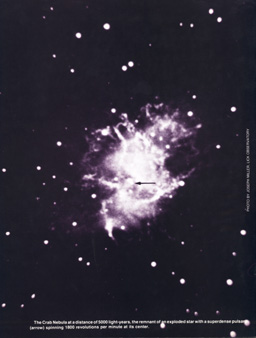
Miscellaneous Graphics
The following graphics are not directly associated with any article. They are listed here in the order in which they appear in the magazine.
|
![[NAAPO Logo]](../../Images/NAAPOsm.jpg)
 Through all of our history we have pondered the stars and mused whether mankind is unique or if, somewhere else out there in the dark of night sky, there are other beings who contemplate and wonder as we do — fellow thinkers in the cosmos. Such beings might view themselves and the universe differently. Somewhere else there might exist exotic biologies, technologies and societies. What a splendid perspective contact with a profoundly different civilization might provide! In a cosmic setting vast and old beyond ordinary human understanding we are a little lonely, and we ponder the ultimate significance, if any, of our tiny but exquisite blue planet, the Earth. The Search for Extra-Terrestrial Intelligence (SETI) is the search for a generally acceptable cosmic context for the human species. In the deepest sense the search for extraterrestrial intelligence is a search for ourselves.
Through all of our history we have pondered the stars and mused whether mankind is unique or if, somewhere else out there in the dark of night sky, there are other beings who contemplate and wonder as we do — fellow thinkers in the cosmos. Such beings might view themselves and the universe differently. Somewhere else there might exist exotic biologies, technologies and societies. What a splendid perspective contact with a profoundly different civilization might provide! In a cosmic setting vast and old beyond ordinary human understanding we are a little lonely, and we ponder the ultimate significance, if any, of our tiny but exquisite blue planet, the Earth. The Search for Extra-Terrestrial Intelligence (SETI) is the search for a generally acceptable cosmic context for the human species. In the deepest sense the search for extraterrestrial intelligence is a search for ourselves.
 It is easy to create an interstellar radio message which can be recognized as emanating unambiguously from intelligent beings. A modulated signal ("beep," "beep-beep," . . . ) comprising the numbers 1, 2, 3, 5, 7, 11, 13, 17, 19, 23, 29, 31, for example, consists exclusively of the first 12 prime numbers — that is, numbers that can be divided only by 1, or by themselves. A signal of this kind, based on a simple mathematical concept, could only have a biological origin. No prior agreement between the transmitting and receiving civilizations, and no precautions against Earth chauvinism, are required to make this clear.
It is easy to create an interstellar radio message which can be recognized as emanating unambiguously from intelligent beings. A modulated signal ("beep," "beep-beep," . . . ) comprising the numbers 1, 2, 3, 5, 7, 11, 13, 17, 19, 23, 29, 31, for example, consists exclusively of the first 12 prime numbers — that is, numbers that can be divided only by 1, or by themselves. A signal of this kind, based on a simple mathematical concept, could only have a biological origin. No prior agreement between the transmitting and receiving civilizations, and no precautions against Earth chauvinism, are required to make this clear.
 Such a message would be an announcement or beacon signal, indicating the presence of an advanced civilization but communicating very little about its nature. The beacon signal might also note a particular frequency where the main message is to be found, or might indicate that the principal message can be found at higher time resolution at the frequency of the beacon signal. The communication of
quite complex information is not very difficult, even for civilizations with extremely different biologies and social conventions. For example, arithmetical statements can be transmitted, some true and some false, and in such a way it becomes possible to transmit the ideas of true and false — concepts which might otherwise seem extremely difficult to communicate.
Such a message would be an announcement or beacon signal, indicating the presence of an advanced civilization but communicating very little about its nature. The beacon signal might also note a particular frequency where the main message is to be found, or might indicate that the principal message can be found at higher time resolution at the frequency of the beacon signal. The communication of
quite complex information is not very difficult, even for civilizations with extremely different biologies and social conventions. For example, arithmetical statements can be transmitted, some true and some false, and in such a way it becomes possible to transmit the ideas of true and false — concepts which might otherwise seem extremely difficult to communicate.

 Carl Sagan is the David Duncan Professor of Astronomy and Space Sciences and Director of the Laboratory for Planetary Studies at Cornell University. Before coming to Cornell in 1968, he served on the faculties of Harvard University and of the Stanford University Medical School. Born in New York City in 1934, he received his doctor's degree from the University of Chicago in 1960. His interests encompass the physics and chemistry of planetary atmospheres and surfaces, planetary exploration, origin of life on the earth, and the possibilities and means of detection of extraterrestrial life. He has been closely associated with the NASA planetary explorations involving the Mariner, Viking and Voyager missions.
Carl Sagan is the David Duncan Professor of Astronomy and Space Sciences and Director of the Laboratory for Planetary Studies at Cornell University. Before coming to Cornell in 1968, he served on the faculties of Harvard University and of the Stanford University Medical School. Born in New York City in 1934, he received his doctor's degree from the University of Chicago in 1960. His interests encompass the physics and chemistry of planetary atmospheres and surfaces, planetary exploration, origin of life on the earth, and the possibilities and means of detection of extraterrestrial life. He has been closely associated with the NASA planetary explorations involving the Mariner, Viking and Voyager missions.






 Every morning for millions of years sunrise over the chalk plains of Britain illuminated the same landscape. The light washed over gently rolling hills and scattered banks of trees, igniting the eyes of birds and small mammals whose species had been greeting the sun here for millions of mornings. Yet one morning the sun found a stranger standing on the plain, an animal who soon showed that he was different from the animals around him. While other animals used the sunlight to begin foraging for food to satisfy their hunger, this creature only stood and watched the sun, as if the light itself was food that fed a different kind of need, a hunger not of the stomach but of the mind. When the sun disappeared he watched the moon and the other lights in the sky. He watched in every season, through harvests and plagues, for years and decades, and though individuals might age and close their eyes forever, new generations would always lift their faces to the sky.
Every morning for millions of years sunrise over the chalk plains of Britain illuminated the same landscape. The light washed over gently rolling hills and scattered banks of trees, igniting the eyes of birds and small mammals whose species had been greeting the sun here for millions of mornings. Yet one morning the sun found a stranger standing on the plain, an animal who soon showed that he was different from the animals around him. While other animals used the sunlight to begin foraging for food to satisfy their hunger, this creature only stood and watched the sun, as if the light itself was food that fed a different kind of need, a hunger not of the stomach but of the mind. When the sun disappeared he watched the moon and the other lights in the sky. He watched in every season, through harvests and plagues, for years and decades, and though individuals might age and close their eyes forever, new generations would always lift their faces to the sky.
 After many generations something strange began happening on the chalk plains. Hundreds of men began bringing massive stones from far away and raising them in a circle. They needed years to break the monoliths out of the earth and drag and heave them inch by inch over miles of hills, but the task could not outlast their determination. With only logs and rope for tools they had to rely on muscles
and sweat to raise the stones, but their aspirations out-
weighed tons of rock.
After many generations something strange began happening on the chalk plains. Hundreds of men began bringing massive stones from far away and raising them in a circle. They needed years to break the monoliths out of the earth and drag and heave them inch by inch over miles of hills, but the task could not outlast their determination. With only logs and rope for tools they had to rely on muscles
and sweat to raise the stones, but their aspirations out-
weighed tons of rock.

 Don Lago, 22, resides in Missouri. He has attended college briefly. Beyond that, in his own words, "My occupation is finding out what people who have lived before me have discovered and thought about the world, and occasionally I have an interesting thought of my own. This is a full-time job in itself and doesn't leave much time to waste on such things as making money, which I am doing at a bookstore.
Don Lago, 22, resides in Missouri. He has attended college briefly. Beyond that, in his own words, "My occupation is finding out what people who have lived before me have discovered and thought about the world, and occasionally I have an interesting thought of my own. This is a full-time job in itself and doesn't leave much time to waste on such things as making money, which I am doing at a bookstore.
 COSMIC SEARCH: To what extent do you think civilizations elsewhere in our galaxy or beyond may have colonized space?
COSMIC SEARCH: To what extent do you think civilizations elsewhere in our galaxy or beyond may have colonized space?
 COSMIC SEARCH: What do you consider might be the most likely way that we might learn of the existence of another civilization?
COSMIC SEARCH: What do you consider might be the most likely way that we might learn of the existence of another civilization?
 COSMIC SEARCH: You have talked about these probes going out preparatory to the colonization of the galaxy. This could not be a coordinated effort because when the colonizing groups become separated, by say 100 light years, they would become independent.
COSMIC SEARCH: You have talked about these probes going out preparatory to the colonization of the galaxy. This could not be a coordinated effort because when the colonizing groups become separated, by say 100 light years, they would become independent.
 COSMIC SEARCH: Do you think that the space colonization activities will significantly increase the probability of another civilization detecting us through all our radio transmissions?
COSMIC SEARCH: Do you think that the space colonization activities will significantly increase the probability of another civilization detecting us through all our radio transmissions?
 COSMIC SEARCH: Tell me more about that please.
COSMIC SEARCH: Tell me more about that please.

 Gerard K. O'Neill is Professor of Physics at Princeton University where he has been a faculty member for 25 years. Born in Brooklyn, New York, in 1927, he served with the U.S. Navy from 1944 to 1946, received a bachelor's degree from Swarthmore College in 1950 and a doctor's degree from Cornell University in 1954. In 1956 O'Neill originated the principle of colliding-beam storage rings in which atomic particles circulate in the rings and then meet head-on, resulting in more efficient energy production than in an ordinary accelerator where moving particles strike a stationary target. Between 1959 and 1965, O'Neill and a team of physicists from Princeton and Stanford Universities constructed the first high-energy particle storage ring and produced head-on particle collisions. Subsequently, many storage rings have been built, the largest, two kilometers in diameter, being at the European Center for Nuclear Research (CERN) at Geneva, Switzerland.
Gerard K. O'Neill is Professor of Physics at Princeton University where he has been a faculty member for 25 years. Born in Brooklyn, New York, in 1927, he served with the U.S. Navy from 1944 to 1946, received a bachelor's degree from Swarthmore College in 1950 and a doctor's degree from Cornell University in 1954. In 1956 O'Neill originated the principle of colliding-beam storage rings in which atomic particles circulate in the rings and then meet head-on, resulting in more efficient energy production than in an ordinary accelerator where moving particles strike a stationary target. Between 1959 and 1965, O'Neill and a team of physicists from Princeton and Stanford Universities constructed the first high-energy particle storage ring and produced head-on particle collisions. Subsequently, many storage rings have been built, the largest, two kilometers in diameter, being at the European Center for Nuclear Research (CERN) at Geneva, Switzerland.
 The insightful question about the genesis of life on Earth is not, "Was it miraculous?," but rather, "Was it unique?" In the 1920's, the biochemists Haldane in England and Oparin in Russia independently suggested that organic compounds could be produced from elementary inorganic molecules. Increased knowledge about the Earth's primordial atmosphere indicated that it had contained appropriate ingredients for the origin of life — hydrogen, ammonia, methane, water vapor. Then, in the early 1950's, Miller and
Urey dramatically showed that these molecules would form amino acids if subjected to a laboratory simulation of the Earth's early conditions.
The insightful question about the genesis of life on Earth is not, "Was it miraculous?," but rather, "Was it unique?" In the 1920's, the biochemists Haldane in England and Oparin in Russia independently suggested that organic compounds could be produced from elementary inorganic molecules. Increased knowledge about the Earth's primordial atmosphere indicated that it had contained appropriate ingredients for the origin of life — hydrogen, ammonia, methane, water vapor. Then, in the early 1950's, Miller and
Urey dramatically showed that these molecules would form amino acids if subjected to a laboratory simulation of the Earth's early conditions.
 And in 1877, a leading Italian astronomer reported sighting long rectilinear features on the Martian surface — "canali," or channels. This innocuous term was later Anglicized to "canals," which implies intelligent intervention. At the turn of the century, the quest for Martian life was championed by Percival Lowell of the prominent Boston family; and, in the early 1920's Marconi reportedly detected Martian radio signals. Moreover, on the evening of 21 August 1924, as Earth and Mars passed exceptionally close to one another in their elliptical orbits, many radio stations worldwide ceased broadcasting for several minutes each hour in order that Martian radio signals might be detected.
And in 1877, a leading Italian astronomer reported sighting long rectilinear features on the Martian surface — "canali," or channels. This innocuous term was later Anglicized to "canals," which implies intelligent intervention. At the turn of the century, the quest for Martian life was championed by Percival Lowell of the prominent Boston family; and, in the early 1920's Marconi reportedly detected Martian radio signals. Moreover, on the evening of 21 August 1924, as Earth and Mars passed exceptionally close to one another in their elliptical orbits, many radio stations worldwide ceased broadcasting for several minutes each hour in order that Martian radio signals might be detected.
 Coincidentally, we on Earth inadvertently have been sending out such signals for the past few decades, through our use of radio and television and of military and scientific radar. At present, mankind's major interstellar emissary is commercial radio and TV.
Coincidentally, we on Earth inadvertently have been sending out such signals for the past few decades, through our use of radio and television and of military and scientific radar. At present, mankind's major interstellar emissary is commercial radio and TV.









 Can matter evolve, under conditions very different from those obtaining at any time in the history of the earth, into patterns or configurations which can be called life-like in some sense? What kinds of behavior should we call life-like? What kinds of behavior should we call intelligent? How can we avoid the trap of framing our concepts in a manner so closely tied to our earth experience and environment that we would not even recognize exotic life forms in the cosmos if we found them? What kinds of generalized life might exist?
Can matter evolve, under conditions very different from those obtaining at any time in the history of the earth, into patterns or configurations which can be called life-like in some sense? What kinds of behavior should we call life-like? What kinds of behavior should we call intelligent? How can we avoid the trap of framing our concepts in a manner so closely tied to our earth experience and environment that we would not even recognize exotic life forms in the cosmos if we found them? What kinds of generalized life might exist?
 Living things are active and can do work on their environment. We will therefore advance our insight into their evolution if we can give a thermodynamic justification for the evolution of our system, over the course of time, from a state of no work done on each cycle (Condition A) (see box) to that of a Carnot heat engine (Condition B).
Living things are active and can do work on their environment. We will therefore advance our insight into their evolution if we can give a thermodynamic justification for the evolution of our system, over the course of time, from a state of no work done on each cycle (Condition A) (see box) to that of a Carnot heat engine (Condition B).

 Jerome Rothstein was born in Bronx, New York, in 1918. After receiving bachelor's degrees from the City College of New York and the Jewish Theological Seminary of America and a master's degree in physics from Columbia University (1940) he was with the U.S. Army Research and Development Laboratories from 1942 to 1957 working in the areas of solid state physics and physical electronics. For the next 10 years he was associated with several industrial organizations including Edgerton, Germeshausen and Grier of Bedford, Massachusetts. Since 1967 Rothstein has been a member of the faculty of the Ohio State University where he is now professor of Computer and Information Science and of Biophysics. His publications, covering a wide range of topics, number in the hundreds. In 1977 he received the most original paper award of the International Conference on Parallel Processing and the previous year their best paper award.
Jerome Rothstein was born in Bronx, New York, in 1918. After receiving bachelor's degrees from the City College of New York and the Jewish Theological Seminary of America and a master's degree in physics from Columbia University (1940) he was with the U.S. Army Research and Development Laboratories from 1942 to 1957 working in the areas of solid state physics and physical electronics. For the next 10 years he was associated with several industrial organizations including Edgerton, Germeshausen and Grier of Bedford, Massachusetts. Since 1967 Rothstein has been a member of the faculty of the Ohio State University where he is now professor of Computer and Information Science and of Biophysics. His publications, covering a wide range of topics, number in the hundreds. In 1977 he received the most original paper award of the International Conference on Parallel Processing and the previous year their best paper award.
 Some of the closer stars are shown in the Solar System Neighborhood sketch [see the graphic to the right]. They are our "next door" neighbors. The nearest ones at about 4 light-years are Alpha Centauri (actually a double star) and Proxima Centauri. Somewhat more distant at 11 or 12 light-years are Epsilon Eridani and Tau Ceti, the two stars Frank Drake observed in his Project Ozma (see page 11 of the January 1979 COSMIC SEARCH [Issue 1]).
Some of the closer stars are shown in the Solar System Neighborhood sketch [see the graphic to the right]. They are our "next door" neighbors. The nearest ones at about 4 light-years are Alpha Centauri (actually a double star) and Proxima Centauri. Somewhat more distant at 11 or 12 light-years are Epsilon Eridani and Tau Ceti, the two stars Frank Drake observed in his Project Ozma (see page 11 of the January 1979 COSMIC SEARCH [Issue 1]).
 The Galactic Neighborhood sketch [see graphic to the right] is a two-dimensional representation of the vicinity of our galaxy. The dots representing our galaxy and the other galaxies are approximately the proper size relative to the intergalactic distances.
The Galactic Neighborhood sketch [see graphic to the right] is a two-dimensional representation of the vicinity of our galaxy. The dots representing our galaxy and the other galaxies are approximately the proper size relative to the intergalactic distances.
 Our galaxy also has other satellites in the form of star clusters [see photo of M5 to the left] which are aggregations of some hundreds of thousands of stars. These are too close to show on the Galactic Neighborhood diagram, being as close as the outer spiral arms of our galaxy. The Magellanic galaxies are about four times as far and are much larger, containing perhaps 1000 million stars.
Our galaxy also has other satellites in the form of star clusters [see photo of M5 to the left] which are aggregations of some hundreds of thousands of stars. These are too close to show on the Galactic Neighborhood diagram, being as close as the outer spiral arms of our galaxy. The Magellanic galaxies are about four times as far and are much larger, containing perhaps 1000 million stars.
 Farther from our galaxy at a distance of nearly one million light-years are several dwarf galaxies in the constellation Leo. Still farther at about two million light-years is the Andromeda galaxy (M31 in Messier's list) [see photo of M31 to the right]. It is the nearest large galaxy and is thought to be similar in many respects to our own, containing several hundred thousand million stars. As shown in the photograph, we view it neither broadside nor edge-on but at an intermediate or slant angle. Even at its great distance it is so large that it covers several degrees of sky. With so many stars and possibly many planets, the chances appear good that there may be at least a few intelligent civilizations in the galaxy but they are so faraway they maybe very difficult to detect. The Andromeda galaxy even has a couple of dwarf satellite galaxies, just to the right and below the central galaxy in the photograph.
Farther from our galaxy at a distance of nearly one million light-years are several dwarf galaxies in the constellation Leo. Still farther at about two million light-years is the Andromeda galaxy (M31 in Messier's list) [see photo of M31 to the right]. It is the nearest large galaxy and is thought to be similar in many respects to our own, containing several hundred thousand million stars. As shown in the photograph, we view it neither broadside nor edge-on but at an intermediate or slant angle. Even at its great distance it is so large that it covers several degrees of sky. With so many stars and possibly many planets, the chances appear good that there may be at least a few intelligent civilizations in the galaxy but they are so faraway they maybe very difficult to detect. The Andromeda galaxy even has a couple of dwarf satellite galaxies, just to the right and below the central galaxy in the photograph.

 Ronald N. Bracewell has served nearly a quarter century on the faculty of Stanford University where is now the Lewis M. Terman Professor and Fellow in Electrical Engineering and Director of the Radio Astronomy Observatory. Born in Australia in 1921, he received his bacheor's degree from Sydney University in 1941 and his doctor's degree from Cambridge University, England, in 1950. Coming to the United States in 1954 he joined Stanford the following year.
Ronald N. Bracewell has served nearly a quarter century on the faculty of Stanford University where is now the Lewis M. Terman Professor and Fellow in Electrical Engineering and Director of the Radio Astronomy Observatory. Born in Australia in 1921, he received his bacheor's degree from Sydney University in 1941 and his doctor's degree from Cambridge University, England, in 1950. Coming to the United States in 1954 he joined Stanford the following year.










